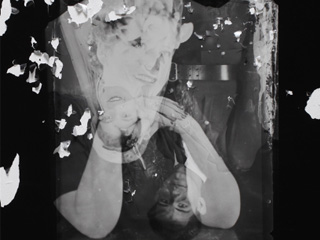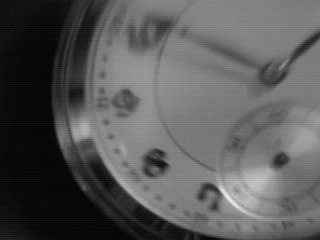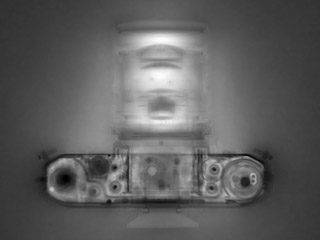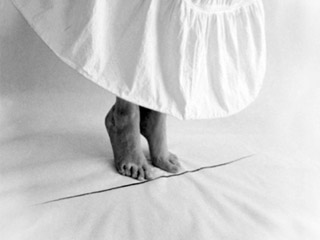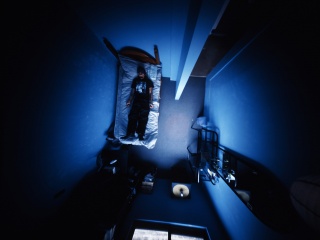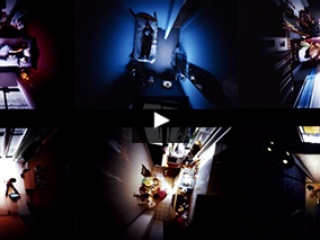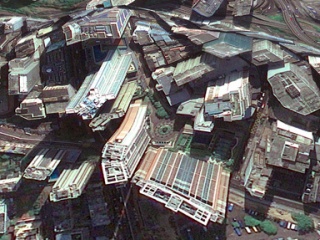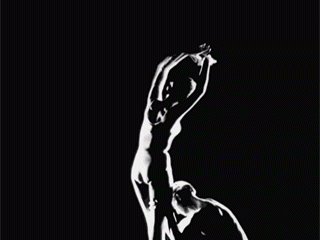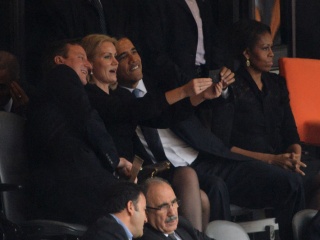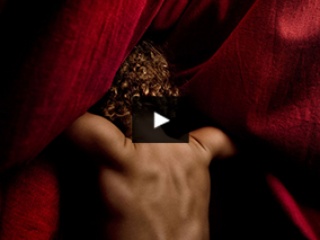Marcus DeSieno
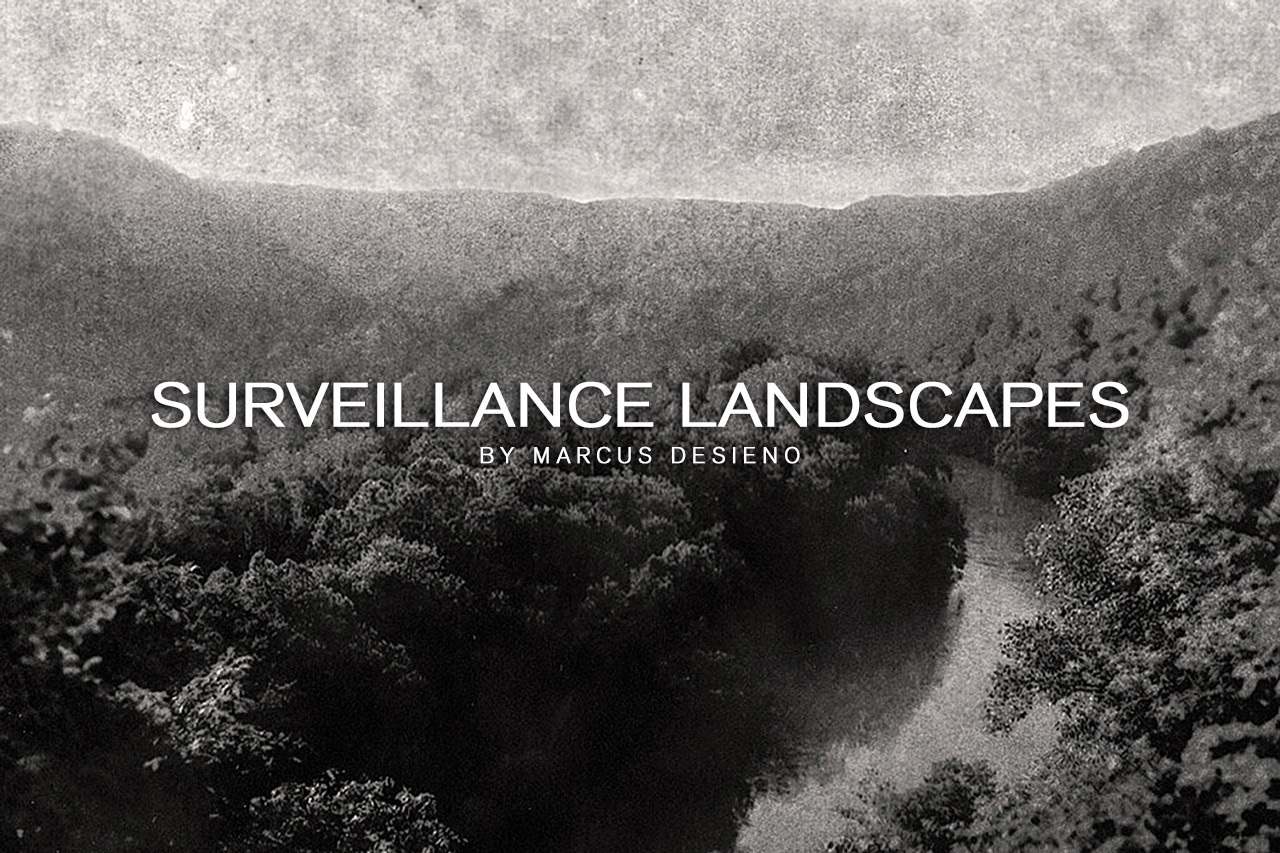
Surveillance Landscapes interrogates how surveillance technology has changed our relationship and understanding of landscape and place in our increasingly intrusive electronic culture. I hack into surveillance cameras, public webcams, and CCTV feeds in a pursuit for the classical picturesque landscape, dislocating the visual product from its automated origins while searching for a conversation between land, borders, and power. The very act of surveying a site through these photographic systems implies a dominating relationship between man and place. Ultimately, I hope to undermine these schemes of social control through the obfuscated melancholic images found while exploiting the technological mechanisms of power in our surveillance society.




















 Marcus DeSieno (USA). His work is concerned with science and exploration in relation to the history of photography. He received his MFA in Studio Art from the University of South Florida in 2015. DeSieno often assumes the role of the amateur scientist in his work in order to investigate photography's historic relationship with science in regards to the notion of the invisible. Antiquated and obsolescent photographic processes are often combined with contemporary imaging technologies to engage in a critical dialog on the evolution of photographic technology in relation to seeing.
Marcus DeSieno (USA). His work is concerned with science and exploration in relation to the history of photography. He received his MFA in Studio Art from the University of South Florida in 2015. DeSieno often assumes the role of the amateur scientist in his work in order to investigate photography's historic relationship with science in regards to the notion of the invisible. Antiquated and obsolescent photographic processes are often combined with contemporary imaging technologies to engage in a critical dialog on the evolution of photographic technology in relation to seeing.
Surveillance Landscapes interrogates how surveillance technology has changed our relationship and understanding of landscape and place in our increasingly intrusive electronic culture. I hack into surveillance cameras, public webcams, and CCTV feeds in a pursuit for the classical picturesque landscape, dislocating the visual product from its automated origins while searching for a conversation between land, borders, and power. The very act of surveying a site through these photographic systems implies a dominating relationship between man and place. Ultimately, I hope to undermine these schemes of social control through the obfuscated melancholic images found while exploiting the technological mechanisms of power in our surveillance society.




















 Marcus DeSieno (USA). His work is concerned with science and exploration in relation to the history of photography. He received his MFA in Studio Art from the University of South Florida in 2015. DeSieno often assumes the role of the amateur scientist in his work in order to investigate photography's historic relationship with science in regards to the notion of the invisible. Antiquated and obsolescent photographic processes are often combined with contemporary imaging technologies to engage in a critical dialog on the evolution of photographic technology in relation to seeing.
Marcus DeSieno (USA). His work is concerned with science and exploration in relation to the history of photography. He received his MFA in Studio Art from the University of South Florida in 2015. DeSieno often assumes the role of the amateur scientist in his work in order to investigate photography's historic relationship with science in regards to the notion of the invisible. Antiquated and obsolescent photographic processes are often combined with contemporary imaging technologies to engage in a critical dialog on the evolution of photographic technology in relation to seeing.Mauricio Alejo
In relation to his videos Mauricio shared the following reflexion with us, that was part of an interview he gave:
Recently I was interviewed by Katrin Steffen. She asked me what I thought of the idea of my videos being surreal. The question caught me off guard; not that I was completely unaware of this, let’s say, approach to my work - other people have made the same observation - but it was the direct, straightforward way in which she formulated her question that struck me.
It is interesting that, until then, I had been resisting calling my work surreal. I don’t know why. I just unreflectively didn't like the idea, but once the question was out I had no option but to come to terms with what I was so stubbornly denying.
Answering it was both liberating and enlightening. I came to understand that, indeed, there is a strong surreal element to my work, probably “á la Magritte” as in “This is not a Pipe” (as opposed to “á la Dalí”, whose work I dislike; it is too spectacular for my taste).
Either way, what I can say is that I’m not trying to open a door to the unconscious, but to a more obvious and factual world that is still surprising, because it actually exists and is just hidden in plain sight.
These lines show a desire to offer a new way of looking at a universe that is hidden behind the false transparency of the photographic language.
In several of the works presented here, our reading of a still image is transformed—thanks to the passage of time—into something completely different. The surprising elements in the universe are infinitely more casual. Gravity, in an unforeseen twist, belies the lightness of the air.
In all of them, the passage of time is a necessary element to show that photography can be a map of the reality but is not equal to it, like for example in the piece World: the world that not stops to move is different from the world that not stops to move around it, and in turn different from our world that also does not slow down.
| Universe |
Line |
Hole |
| Gravity |
Twig |
Crack |
| Container |
Fact and fiction |
World |
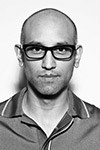 Mauricio Alejo (Mexico, 1969). He earned his Master of Art from New York University in 2002, as a Fulbright Grant recipient. In 2007, he was a resident artist at NUS Centre for the Arts in Singapore. He has received multiple awards and grants, including the New York Foundation for the Arts grant in 2008. His work is part of important collections such as Daros Latinoamérica Collection in Zürich . His work has been reviewed in important journals, such as Flash Art; Art News and Art in America. He has had solo exhibitions in New York, Japan, Madrid, Paris and Mexico. His work has been shown at CCA Wattis Institute of Contemporary Arts in San Francisco; Museo Centro de Arte Reina Sofía in Madrid and The 8th Havana Biennial among other venues. He currently lives and works in New York City.
Mauricio Alejo (Mexico, 1969). He earned his Master of Art from New York University in 2002, as a Fulbright Grant recipient. In 2007, he was a resident artist at NUS Centre for the Arts in Singapore. He has received multiple awards and grants, including the New York Foundation for the Arts grant in 2008. His work is part of important collections such as Daros Latinoamérica Collection in Zürich . His work has been reviewed in important journals, such as Flash Art; Art News and Art in America. He has had solo exhibitions in New York, Japan, Madrid, Paris and Mexico. His work has been shown at CCA Wattis Institute of Contemporary Arts in San Francisco; Museo Centro de Arte Reina Sofía in Madrid and The 8th Havana Biennial among other venues. He currently lives and works in New York City.In relation to his videos Mauricio shared the following reflexion with us, that was part of an interview he gave:
Recently I was interviewed by Katrin Steffen. She asked me what I thought of the idea of my videos being surreal. The question caught me off guard; not that I was completely unaware of this, let’s say, approach to my work - other people have made the same observation - but it was the direct, straightforward way in which she formulated her question that struck me.
It is interesting that, until then, I had been resisting calling my work surreal. I don’t know why. I just unreflectively didn't like the idea, but once the question was out I had no option but to come to terms with what I was so stubbornly denying.
Answering it was both liberating and enlightening. I came to understand that, indeed, there is a strong surreal element to my work, probably “á la Magritte” as in “This is not a Pipe” (as opposed to “á la Dalí”, whose work I dislike; it is too spectacular for my taste).
Either way, what I can say is that I’m not trying to open a door to the unconscious, but to a more obvious and factual world that is still surprising, because it actually exists and is just hidden in plain sight.
These lines show a desire to offer a new way of looking at a universe that is hidden behind the false transparency of the photographic language.
In several of the works presented here, our reading of a still image is transformed—thanks to the passage of time—into something completely different. The surprising elements in the universe are infinitely more casual. Gravity, in an unforeseen twist, belies the lightness of the air.
In all of them, the passage of time is a necessary element to show that photography can be a map of the reality but is not equal to it, like for example in the piece World: the world that not stops to move is different from the world that not stops to move around it, and in turn different from our world that also does not slow down.
| Universe |
Line |
Hole |
| Gravity |
Twig |
Crack |
| Container |
Fact and fiction |
World |
 Mauricio Alejo (Mexico, 1969). He earned his Master of Art from New York University in 2002, as a Fulbright Grant recipient. In 2007, he was a resident artist at NUS Centre for the Arts in Singapore. He has received multiple awards and grants, including the New York Foundation for the Arts grant in 2008. His work is part of important collections such as Daros Latinoamérica Collection in Zürich . His work has been reviewed in important journals, such as Flash Art; Art News and Art in America. He has had solo exhibitions in New York, Japan, Madrid, Paris and Mexico. His work has been shown at CCA Wattis Institute of Contemporary Arts in San Francisco; Museo Centro de Arte Reina Sofía in Madrid and The 8th Havana Biennial among other venues. He currently lives and works in New York City.
Mauricio Alejo (Mexico, 1969). He earned his Master of Art from New York University in 2002, as a Fulbright Grant recipient. In 2007, he was a resident artist at NUS Centre for the Arts in Singapore. He has received multiple awards and grants, including the New York Foundation for the Arts grant in 2008. His work is part of important collections such as Daros Latinoamérica Collection in Zürich . His work has been reviewed in important journals, such as Flash Art; Art News and Art in America. He has had solo exhibitions in New York, Japan, Madrid, Paris and Mexico. His work has been shown at CCA Wattis Institute of Contemporary Arts in San Francisco; Museo Centro de Arte Reina Sofía in Madrid and The 8th Havana Biennial among other venues. He currently lives and works in New York City.Gabriel de la Mora
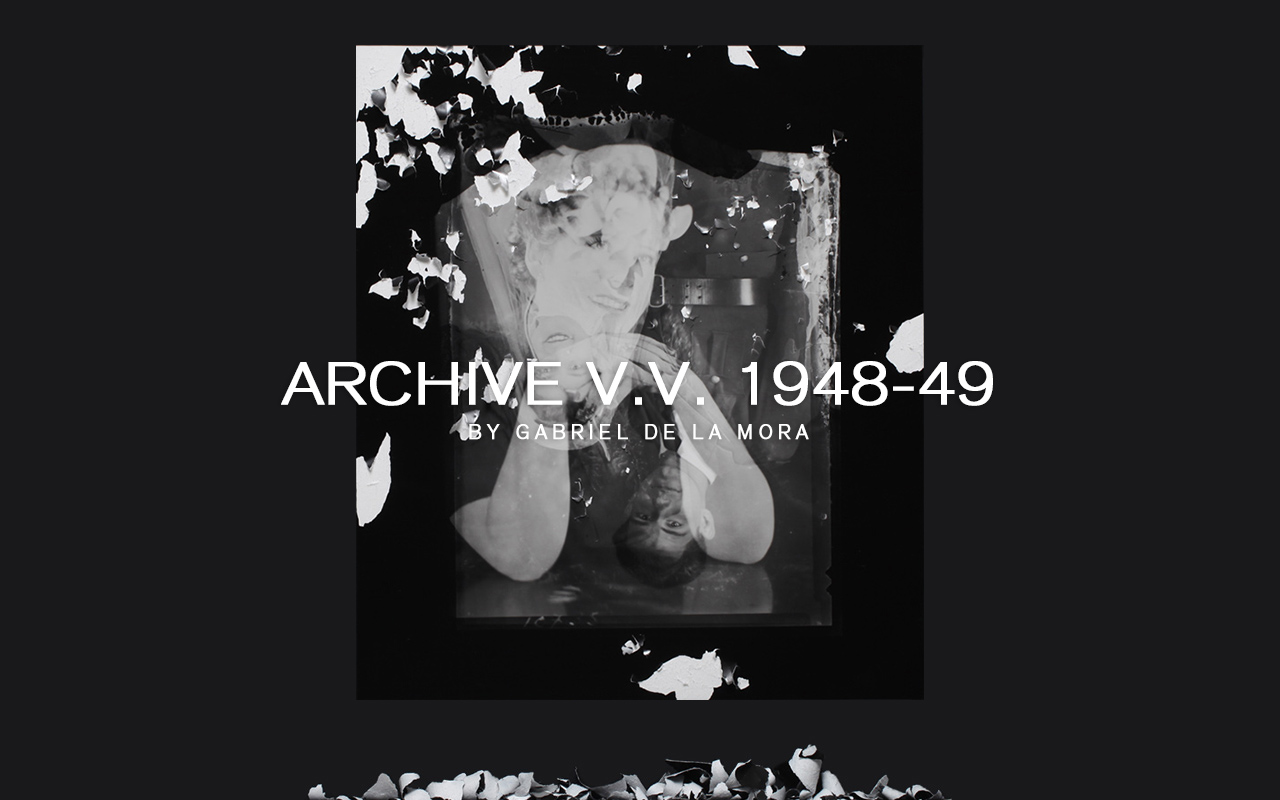
This series of altered photographs comes from a set of negatives that was destroyed when the warehouse where they had been stored for decades was flooded. This is why some of the negatives were stuck together, some of them showing two different takes of the same person and others two or three different people. They are negatives of portraits taken in 1948 and 1949 by Víctor Villamil Vilón at Cano Photography Studios, later called Vilón Photography Studios in Bogotá, Colombia. The images were printed on silver gel with fibrous paper in Mexico City and subsequently altered and framed. The artist begins his work by tearing off pieces of the photo.
Time and light do the rest, erasing the photographic image completely and leaving a monochrome surface. Only then is the work finished. Therefore 50, 100 or 300 years will have to pass, depending on the conditions in which the work is found. The artist never completes the piece and will surely never see it finished. This series is a parallel to the altered space entitled Pan-American Exhibition at NC ARTE.

























 Gabriel de la Mora (Mexico 1968). Studied a masters in painting, photography and video at the Pratt Institute in New York (2001-2003) and a bachelors in architecture at the Universidad Anáhuac del Norte (1987-1991) in Mexico City. He is currently a member of the Sistema Nacional de Creadores de Arte (2013-2015) and has received a number of awards and grants including the Primer Premio de la VII Bienal de Monterrey FEMSA, the Garcia Robles Fulbright Grant and the Jacques and Natasha Gelman Grant among others. His work as been shown in Mexico and abroad both individually and collectively.
Gabriel de la Mora (Mexico 1968). Studied a masters in painting, photography and video at the Pratt Institute in New York (2001-2003) and a bachelors in architecture at the Universidad Anáhuac del Norte (1987-1991) in Mexico City. He is currently a member of the Sistema Nacional de Creadores de Arte (2013-2015) and has received a number of awards and grants including the Primer Premio de la VII Bienal de Monterrey FEMSA, the Garcia Robles Fulbright Grant and the Jacques and Natasha Gelman Grant among others. His work as been shown in Mexico and abroad both individually and collectively.ZZ. In the project called Archive V.V. 1948 -49 how do you establish the photograph/time relationship? How does it affect the image both as an external and intrinsic element?
GM. Photographic technique is a constantly changing process. Depending upon the passage of time and light, on how the photo has been exposed to these two factors, it can slowly fade and begin to disappear. Which initially worried me for this project. But I think that later this inevitable factor became a starting point for various series in which I used photography as primary or supporting material.
In most of my work, photography is an important element, whether as a file or a document, or a starting point as it was for Willy Kautz in his work shown at the Amparo Museum from October 2014 to February 2015 under the title "What watches us that we don’t see.” The starting point in this exhibit was how an image becomes monochromatic and how a monochrome can become an image.
Although I take photographs to document pieces and processes, amongst many other things, I like to work with vintage photographs from the late 19th to the late 20th century. I buy archives, classify them and then begin my explorations. For the Archive V.V. 1948-49 project I used destroyed negatives for the first time. The alterations were both accidental and due to the passage of time, which produced astounding results.
The Vilón Archive series began in 2012 while I was preparing for my first altered space project at the NC ARTE gallery in Bogotá Colombia. As an alternative activity to the show called Pan-American Exhibition curated by Willy Kautz, I visited an old photography studio near the NC ARTE gallery. I was hoping to find vintage portraits taken in Bogotá in 1948-1949.
Victor Vilón’s children, Germán and Patricia Vilón, who owned the Vilón Photography Studio, told me that although they had no old photographs they did have some negatives which they would look for to show me. Two days later I turned up punctually for our appointment and both Patricia and Germán had a look of utter frustration: they showed me a cardboard box containing hundreds of negatives that had been destroyed by a flood in the warehouse where they had been stored, which no-one had noticed. Patricia showed me various negatives that were stuck together and would break when separated and told me they were going to throw it all away. When I saw some of the negatives, I found them far more interesting than they would have been if they had not got wet. So I asked Germán if they could print the negatives in their destroyed state and he told me that they could, but that they would turn out badly. I chose a few and asked for examples. A couple of days later, these examples exceeded my expectations. Previously, I would buy vintage photographs from Mexican movies and alter them by randomly tearing part of the film to transform the narrative and configuration through a process of abstraction and destruction.
Before destroying each image I would scan both sides so that each altered photograph could be added to my digital archives.
The destroyed negatives from Archive V.V. had not been altered by me, but by an accident that destroyed them over time, so the artistic process for series like the one on Mexican movies was carried out by time rather than by me. The result is simply amazing. To rescue the negatives from the garbage I asked German and Patricia to sell them to me to keep in Mexico where I could continue experimenting with the series of images.
ZZ. How much do you intervene in the construction of a photographic image and at what point is it beyond your control?
GM. As an artist I like to have control over certain pieces or series, but I also like to lose absolute control over other series in particular, or occasionally combine both: control and randomness.
With regards to the destroyed negatives, or Archive V.V. 1948-49, the majority of alterations were made by the flood and time and the results were the starting point for a new series. When printed, the images were extraordinary, unique, and I did not intervene in them at all except for finding and recovering them. It was like a type of assisted Ready Made, as Francisco Reyes Palma so aptly called it. Once the photos had been printed, I altered them again by tearing part of the photographic film off and leaving the fragments at the bottom of the frame. This begins a process that, depending on the conditions in which the photo is stored, time and light, will cause the image to entirely disappear in maybe 50, 100 or more years, transforming the photo into a monochrome white surface. When this finally happens, the piece will be completed. “The artist only begins the piece, but will never see it finished as its process continues over time even after the artist’s death.”
Back in Mexico, I went to a photography laboratory to print the negatives I had chosen on fiber paper in a similar way. Once they were printed, but before framing them, I altered them randomly, tearing bits of photographic film off and saving them so that after the photo had been framed, they would be at the bottom of the frame.
What most interests me is what happens after the first intervention when the destroyed negative is printed. I intervene again by tearing off small pieces of the image, thereby beginning my piece of work, since time, light and varied storage conditions will complete the piece.
ZZ. When the object mediates between the artist and the spectator, what type of reflection does it incite?
GM. At the end of the day, everything vanishes. Nothing is eternal and everything is subject to constant change and transformation. Art is neither created nor destroyed, only transformed.
In my work, I like to introduce the works. They do everything. There is a an interesting visual, formal and technical factor that makes an initial, perhaps more emotional impact. Afterwards, you can explore what goes on behind the process, and the work itself has various levels of information where one question leads to another, and so on, indefinitely.
When something attracts your attention and you like it but it also makes you think, for me, that is the point where the work becomes whole. Each person will have a different opinion or reaction depending on the level and type of previous information they possess. The images or works in this series, for example, have received differing opinions and reflections. In some people they elicit nostalgia for an era, a person who no longer exists or who died years ago; for others, it produces a certain mystery, or even fear, since some of the faces or images are rather ghostlike.
Personally, I believe that the images are powerful in every respect. They have an extraordinary composition and were, in a way, part of an archive which, when it was destroyed, fulfilled its destiny by becoming waste. This is a footnote for me as an artist, knowing that what comes at the end of one thing can be the beginning of another. This waste or residual material can be transformed into artwork.
When two or more negatives in the archive are stuck together and then break and are fragmented into other images, the way I print them turns them into something extraordinary. They have been altered by time, through a naturally destructive process, making the image into an abstraction with a strange composition. The people still exist in them, or their presence is registered, together with a whole era. Thus the images are historic documents that are transformed into something else.
The original author of these portraits was Don Victor Villamil Vilón, and now I am the author. I love to find new ways of experimenting with photography. I did not originally take these photographs, but I did rescue them from the becoming garbage after they had been destroyed in a flood and now they are prime examples for exploring image through records, archives and documents.

This series of altered photographs comes from a set of negatives that was destroyed when the warehouse where they had been stored for decades was flooded. This is why some of the negatives were stuck together, some of them showing two different takes of the same person and others two or three different people. They are negatives of portraits taken in 1948 and 1949 by Víctor Villamil Vilón at Cano Photography Studios, later called Vilón Photography Studios in Bogotá, Colombia. The images were printed on silver gel with fibrous paper in Mexico City and subsequently altered and framed. The artist begins his work by tearing off pieces of the photo.
Time and light do the rest, erasing the photographic image completely and leaving a monochrome surface. Only then is the work finished. Therefore 50, 100 or 300 years will have to pass, depending on the conditions in which the work is found. The artist never completes the piece and will surely never see it finished. This series is a parallel to the altered space entitled Pan-American Exhibition at NC ARTE.

























 Gabriel de la Mora (Mexico 1968). Studied a masters in painting, photography and video at the Pratt Institute in New York (2001-2003) and a bachelors in architecture at the Universidad Anáhuac del Norte (1987-1991) in Mexico City. He is currently a member of the Sistema Nacional de Creadores de Arte (2013-2015) and has received a number of awards and grants including the Primer Premio de la VII Bienal de Monterrey FEMSA, the Garcia Robles Fulbright Grant and the Jacques and Natasha Gelman Grant among others. His work as been shown in Mexico and abroad both individually and collectively.
Gabriel de la Mora (Mexico 1968). Studied a masters in painting, photography and video at the Pratt Institute in New York (2001-2003) and a bachelors in architecture at the Universidad Anáhuac del Norte (1987-1991) in Mexico City. He is currently a member of the Sistema Nacional de Creadores de Arte (2013-2015) and has received a number of awards and grants including the Primer Premio de la VII Bienal de Monterrey FEMSA, the Garcia Robles Fulbright Grant and the Jacques and Natasha Gelman Grant among others. His work as been shown in Mexico and abroad both individually and collectively.ZZ. In the project called Archive V.V. 1948 -49 how do you establish the photograph/time relationship? How does it affect the image both as an external and intrinsic element?
GM. Photographic technique is a constantly changing process. Depending upon the passage of time and light, on how the photo has been exposed to these two factors, it can slowly fade and begin to disappear. Which initially worried me for this project. But I think that later this inevitable factor became a starting point for various series in which I used photography as primary or supporting material.
In most of my work, photography is an important element, whether as a file or a document, or a starting point as it was for Willy Kautz in his work shown at the Amparo Museum from October 2014 to February 2015 under the title "What watches us that we don’t see.” The starting point in this exhibit was how an image becomes monochromatic and how a monochrome can become an image.
Although I take photographs to document pieces and processes, amongst many other things, I like to work with vintage photographs from the late 19th to the late 20th century. I buy archives, classify them and then begin my explorations. For the Archive V.V. 1948-49 project I used destroyed negatives for the first time. The alterations were both accidental and due to the passage of time, which produced astounding results.
The Vilón Archive series began in 2012 while I was preparing for my first altered space project at the NC ARTE gallery in Bogotá Colombia. As an alternative activity to the show called Pan-American Exhibition curated by Willy Kautz, I visited an old photography studio near the NC ARTE gallery. I was hoping to find vintage portraits taken in Bogotá in 1948-1949.
Victor Vilón’s children, Germán and Patricia Vilón, who owned the Vilón Photography Studio, told me that although they had no old photographs they did have some negatives which they would look for to show me. Two days later I turned up punctually for our appointment and both Patricia and Germán had a look of utter frustration: they showed me a cardboard box containing hundreds of negatives that had been destroyed by a flood in the warehouse where they had been stored, which no-one had noticed. Patricia showed me various negatives that were stuck together and would break when separated and told me they were going to throw it all away. When I saw some of the negatives, I found them far more interesting than they would have been if they had not got wet. So I asked Germán if they could print the negatives in their destroyed state and he told me that they could, but that they would turn out badly. I chose a few and asked for examples. A couple of days later, these examples exceeded my expectations. Previously, I would buy vintage photographs from Mexican movies and alter them by randomly tearing part of the film to transform the narrative and configuration through a process of abstraction and destruction.
Before destroying each image I would scan both sides so that each altered photograph could be added to my digital archives.
The destroyed negatives from Archive V.V. had not been altered by me, but by an accident that destroyed them over time, so the artistic process for series like the one on Mexican movies was carried out by time rather than by me. The result is simply amazing. To rescue the negatives from the garbage I asked German and Patricia to sell them to me to keep in Mexico where I could continue experimenting with the series of images.
ZZ. How much do you intervene in the construction of a photographic image and at what point is it beyond your control?
GM. As an artist I like to have control over certain pieces or series, but I also like to lose absolute control over other series in particular, or occasionally combine both: control and randomness.
With regards to the destroyed negatives, or Archive V.V. 1948-49, the majority of alterations were made by the flood and time and the results were the starting point for a new series. When printed, the images were extraordinary, unique, and I did not intervene in them at all except for finding and recovering them. It was like a type of assisted Ready Made, as Francisco Reyes Palma so aptly called it. Once the photos had been printed, I altered them again by tearing part of the photographic film off and leaving the fragments at the bottom of the frame. This begins a process that, depending on the conditions in which the photo is stored, time and light, will cause the image to entirely disappear in maybe 50, 100 or more years, transforming the photo into a monochrome white surface. When this finally happens, the piece will be completed. “The artist only begins the piece, but will never see it finished as its process continues over time even after the artist’s death.”
Back in Mexico, I went to a photography laboratory to print the negatives I had chosen on fiber paper in a similar way. Once they were printed, but before framing them, I altered them randomly, tearing bits of photographic film off and saving them so that after the photo had been framed, they would be at the bottom of the frame.
What most interests me is what happens after the first intervention when the destroyed negative is printed. I intervene again by tearing off small pieces of the image, thereby beginning my piece of work, since time, light and varied storage conditions will complete the piece.
ZZ. When the object mediates between the artist and the spectator, what type of reflection does it incite?
GM. At the end of the day, everything vanishes. Nothing is eternal and everything is subject to constant change and transformation. Art is neither created nor destroyed, only transformed.
In my work, I like to introduce the works. They do everything. There is a an interesting visual, formal and technical factor that makes an initial, perhaps more emotional impact. Afterwards, you can explore what goes on behind the process, and the work itself has various levels of information where one question leads to another, and so on, indefinitely.
When something attracts your attention and you like it but it also makes you think, for me, that is the point where the work becomes whole. Each person will have a different opinion or reaction depending on the level and type of previous information they possess. The images or works in this series, for example, have received differing opinions and reflections. In some people they elicit nostalgia for an era, a person who no longer exists or who died years ago; for others, it produces a certain mystery, or even fear, since some of the faces or images are rather ghostlike.
Personally, I believe that the images are powerful in every respect. They have an extraordinary composition and were, in a way, part of an archive which, when it was destroyed, fulfilled its destiny by becoming waste. This is a footnote for me as an artist, knowing that what comes at the end of one thing can be the beginning of another. This waste or residual material can be transformed into artwork.
When two or more negatives in the archive are stuck together and then break and are fragmented into other images, the way I print them turns them into something extraordinary. They have been altered by time, through a naturally destructive process, making the image into an abstraction with a strange composition. The people still exist in them, or their presence is registered, together with a whole era. Thus the images are historic documents that are transformed into something else.
The original author of these portraits was Don Victor Villamil Vilón, and now I am the author. I love to find new ways of experimenting with photography. I did not originally take these photographs, but I did rescue them from the becoming garbage after they had been destroyed in a flood and now they are prime examples for exploring image through records, archives and documents.
Andrea Dorliguzzo

In 2013, Andrea Dorliguzzo started with his rephotography project Roma Ieri Oggi (Rome Yesterday Today). Driven by his passion for photography and his admiration for Rome, he started to collect old photographs of the city and combined these with contemporary ones, taken at exactly the same spot. In this way, the past and the present are brought together, causing a thrilling historical sensation which reminds us of all the great stories that the city has to tell.




















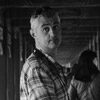 Andrea Dorliguzzo (Italy) was born in Friuli, in the north-east part of Italy. A few years ago, he moved to Rome. His passion for photography was born quite recently. Over the last years, he had the luck of traveling a lot and bringing home an unimaginable number of pictures and memories. Regarding his photos, he is very critical and only a small selection is published on his photo blog.
Andrea Dorliguzzo (Italy) was born in Friuli, in the north-east part of Italy. A few years ago, he moved to Rome. His passion for photography was born quite recently. Over the last years, he had the luck of traveling a lot and bringing home an unimaginable number of pictures and memories. Regarding his photos, he is very critical and only a small selection is published on his photo blog.
In 2013, Andrea Dorliguzzo started with his rephotography project Roma Ieri Oggi (Rome Yesterday Today). Driven by his passion for photography and his admiration for Rome, he started to collect old photographs of the city and combined these with contemporary ones, taken at exactly the same spot. In this way, the past and the present are brought together, causing a thrilling historical sensation which reminds us of all the great stories that the city has to tell.




















 Andrea Dorliguzzo (Italy) was born in Friuli, in the north-east part of Italy. A few years ago, he moved to Rome. His passion for photography was born quite recently. Over the last years, he had the luck of traveling a lot and bringing home an unimaginable number of pictures and memories. Regarding his photos, he is very critical and only a small selection is published on his photo blog.
Andrea Dorliguzzo (Italy) was born in Friuli, in the north-east part of Italy. A few years ago, he moved to Rome. His passion for photography was born quite recently. Over the last years, he had the luck of traveling a lot and bringing home an unimaginable number of pictures and memories. Regarding his photos, he is very critical and only a small selection is published on his photo blog.Virgil Widrich
Copy Shop, 2001
Written, directed, produced, edited by Virgil Widrich
An original copy film. 2001, 35mm. b/w, 12 min. sound, no dialogue.
The film Copy Shop actually consist of nearly 18,000 photocopied digital frames, which are animated and filmed with a 35mm camera.
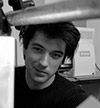 Virgil Widrich (Salzburg, 1967). Lives in Vienna. He works on numerous multimedia and film productions. His first feature film is Heller als der Mond (Brighter than the Moon). His short film Copy Shop won 35 international awards and was nominated for the Oscar. Fast Film premiered in Cannes 2003 and won 36 awards until today. At the moment Widrich is working on a new feature film The Night of a Thousand Hours.
Virgil Widrich (Salzburg, 1967). Lives in Vienna. He works on numerous multimedia and film productions. His first feature film is Heller als der Mond (Brighter than the Moon). His short film Copy Shop won 35 international awards and was nominated for the Oscar. Fast Film premiered in Cannes 2003 and won 36 awards until today. At the moment Widrich is working on a new feature film The Night of a Thousand Hours.Copy Shop, 2001
Written, directed, produced, edited by Virgil Widrich
An original copy film. 2001, 35mm. b/w, 12 min. sound, no dialogue.
The film Copy Shop actually consist of nearly 18,000 photocopied digital frames, which are animated and filmed with a 35mm camera.
 Virgil Widrich (Salzburg, 1967). Lives in Vienna. He works on numerous multimedia and film productions. His first feature film is Heller als der Mond (Brighter than the Moon). His short film Copy Shop won 35 international awards and was nominated for the Oscar. Fast Film premiered in Cannes 2003 and won 36 awards until today. At the moment Widrich is working on a new feature film The Night of a Thousand Hours.
Virgil Widrich (Salzburg, 1967). Lives in Vienna. He works on numerous multimedia and film productions. His first feature film is Heller als der Mond (Brighter than the Moon). His short film Copy Shop won 35 international awards and was nominated for the Oscar. Fast Film premiered in Cannes 2003 and won 36 awards until today. At the moment Widrich is working on a new feature film The Night of a Thousand Hours.ZoneZero
Interview with Virgil Widrich about his work. February 2015
 Virgil Widrich (Salzburg, 1967). Lives in Vienna. He works on numerous multimedia and film productions. His first feature film is Heller als der Mond (Brighter than the Moon). His short film Copy Shop won 35 international awards and was nominated for the Oscar. Fast Film premiered in Cannes 2003 and won 36 awards until today. At the moment Widrich is working on a new feature film The Night of a Thousand Hours.
Virgil Widrich (Salzburg, 1967). Lives in Vienna. He works on numerous multimedia and film productions. His first feature film is Heller als der Mond (Brighter than the Moon). His short film Copy Shop won 35 international awards and was nominated for the Oscar. Fast Film premiered in Cannes 2003 and won 36 awards until today. At the moment Widrich is working on a new feature film The Night of a Thousand Hours.Interview with Virgil Widrich about his work. February 2015
 Virgil Widrich (Salzburg, 1967). Lives in Vienna. He works on numerous multimedia and film productions. His first feature film is Heller als der Mond (Brighter than the Moon). His short film Copy Shop won 35 international awards and was nominated for the Oscar. Fast Film premiered in Cannes 2003 and won 36 awards until today. At the moment Widrich is working on a new feature film The Night of a Thousand Hours.
Virgil Widrich (Salzburg, 1967). Lives in Vienna. He works on numerous multimedia and film productions. His first feature film is Heller als der Mond (Brighter than the Moon). His short film Copy Shop won 35 international awards and was nominated for the Oscar. Fast Film premiered in Cannes 2003 and won 36 awards until today. At the moment Widrich is working on a new feature film The Night of a Thousand Hours.Alejandro Malo

by Eadweard Muybridge
The fleeting today is tenuous and eternal;
Don’t wait for another Heaven or Hell.
—Jorge Luis Borges.
Photography is thought of as a way to freeze time and people rarely discuss how much time each photographic instant really represents. From the more than eight hours taken to shoot View from the Window at Le Gras to the fifteen minutes for Boulevard du Temple, to the speeds achieved in the past decade of more than a billion frames per second, each photograph prolongs a fiction in which we desire to see the ever-changing world imprisoned before our gaze. Movies, like theater and dance, derived from photographs precisely their desire to represent this same ever-changing world, but without being confined to an instant or synthesizing something living into a fixed image. The work of Muybridge and Marey, by capturing sequential movement and reproducing it in fixed or animated images, addressed these aspects which appeared to draw one path for photography and another for cinematography.
Decades later, communication vessels became popular, blurring the boundaries between these mediums. Photographic time extends itself in anyone’s hands and an image, previously immobile, unfolds instantly into movement with any number of applications such as Vine, Instagram, Cinemagram and others. With increasing frequency, photographers offer video work as part of their professional activities and create time-lapse or rephotography images to convey events that extend beyond the limits of a series or a single shot. Likewise, movies have shifted from the surprise occasioned by works like Chris Marker’s La Jetée (1962) and the flat sequences of Antonioni that scandalized Cannes in 1960 to a visual fascination with suspended, almost immobile shots, as in the Tarkovsky movies. Current cinematography often employs flat sequence structure, or imitates Ken Burns by recovering photographic files through a specific video editing effect named after him.
Tonino Guerra, in the preface to Instant Light: Tarkovsky Polaroids, anecdotes about how both Tarkovsky and Antonioni used Polaroid cameras in the late 1970s. The former was constantly worried about the volatility of time and his desire to freeze it in these instant images; it is not difficult to imagine how this impacted his movies. The latter discusses how, during a location scouting trip to Uzbekistan, an old man rejected a photograph recently take of him and two friends by asking: "¿“Why stop time?” to which neither man could respond. And this invites the questions: If photography is a way to stop time, how much time and how much mobility can an instant comprise? And no less important, how much do movies actually escape from their photographic desire to stop time, even though it captures entire lifetimes or historic moments?
The first question has been tested in a number of projects, and the opportunity to represent the variability of time has multiplied with the immediacy of available tools. The visual language permitted by cameras has led to the proliferation of works where years become a chronograph, days are the sun’s accelerated journey across the horizon, people are frozen in 360 degrees and cameras slow down or speed up at the pace of a silent film. Movies have their own experimental territory where more frequent use of the flat sequence and found footage, real or fictitious, and the recording and recovery of material in lapses is increasingly prolonged. The bridge between what was considered a brief, decisive instant and what was considered a long, narrative instant is constantly lengthening. The fields of photography and film are more accessible, and the instant, more relative. This freedom is worth exploring.
 Alejandro Malo (Mexico, 1972). Lives and works in Mexico and is the director of ZoneZero. Since 1993, he has taken part in various cultural projects and worked as an information technology consultant. He has collaborated in print and electronic publications, and given workshops and conferences on literature, creative writing, storytelling and technology. In 2009, Malo joined the team of the Fundación Pedro Meyer, where he directs the Archives and Technology departments.
Alejandro Malo (Mexico, 1972). Lives and works in Mexico and is the director of ZoneZero. Since 1993, he has taken part in various cultural projects and worked as an information technology consultant. He has collaborated in print and electronic publications, and given workshops and conferences on literature, creative writing, storytelling and technology. In 2009, Malo joined the team of the Fundación Pedro Meyer, where he directs the Archives and Technology departments.[core_state] => 1 [core_access] => 1 [core_metadata] => {"robots":"","author":"Alejandro Malo","rights":"","xreference":""} [core_created_user_id] => 841 [core_created_by_alias] => [core_created_time] => 2015-02-18 20:11:20 [core_images] => {"image_intro":"images\/categories\/temporality\/Muybridge_race_horse_animated.gif","float_intro":"","image_intro_alt":"","image_intro_caption":"","image_fulltext":"images\/categories\/temporality\/Muybridge_race_horse_animated.gif","float_fulltext":"","image_fulltext_alt":"","image_fulltext_caption":""} [core_modified_time] => 2015-06-01 18:12:34 [core_language] => en-GB [core_catid] => 57 [core_publish_up] => 2015-02-18 20:11:20 [core_publish_down] => 0000-00-00 00:00:00 [content_type_title] => Article [router] => ContentHelperRoute::getArticleRoute [author] => [author_email] => [link] => index.php?option=com_content&view=article&id=257:the-many-moments-of-the-instant&catid=57&lang=en-GB [displayDate] => 2015-02-18 20:11:20 [event] => stdClass Object ( [afterDisplayTitle] => [beforeDisplayContent] => [afterDisplayContent] => ) [text] =>

by Eadweard Muybridge
The fleeting today is tenuous and eternal;
Don’t wait for another Heaven or Hell.
—Jorge Luis Borges.
Photography is thought of as a way to freeze time and people rarely discuss how much time each photographic instant really represents. From the more than eight hours taken to shoot View from the Window at Le Gras to the fifteen minutes for Boulevard du Temple, to the speeds achieved in the past decade of more than a billion frames per second, each photograph prolongs a fiction in which we desire to see the ever-changing world imprisoned before our gaze. Movies, like theater and dance, derived from photographs precisely their desire to represent this same ever-changing world, but without being confined to an instant or synthesizing something living into a fixed image. The work of Muybridge and Marey, by capturing sequential movement and reproducing it in fixed or animated images, addressed these aspects which appeared to draw one path for photography and another for cinematography.
Decades later, communication vessels became popular, blurring the boundaries between these mediums. Photographic time extends itself in anyone’s hands and an image, previously immobile, unfolds instantly into movement with any number of applications such as Vine, Instagram, Cinemagram and others. With increasing frequency, photographers offer video work as part of their professional activities and create time-lapse or rephotography images to convey events that extend beyond the limits of a series or a single shot. Likewise, movies have shifted from the surprise occasioned by works like Chris Marker’s La Jetée (1962) and the flat sequences of Antonioni that scandalized Cannes in 1960 to a visual fascination with suspended, almost immobile shots, as in the Tarkovsky movies. Current cinematography often employs flat sequence structure, or imitates Ken Burns by recovering photographic files through a specific video editing effect named after him.
Tonino Guerra, in the preface to Instant Light: Tarkovsky Polaroids, anecdotes about how both Tarkovsky and Antonioni used Polaroid cameras in the late 1970s. The former was constantly worried about the volatility of time and his desire to freeze it in these instant images; it is not difficult to imagine how this impacted his movies. The latter discusses how, during a location scouting trip to Uzbekistan, an old man rejected a photograph recently take of him and two friends by asking: "¿“Why stop time?” to which neither man could respond. And this invites the questions: If photography is a way to stop time, how much time and how much mobility can an instant comprise? And no less important, how much do movies actually escape from their photographic desire to stop time, even though it captures entire lifetimes or historic moments?
The first question has been tested in a number of projects, and the opportunity to represent the variability of time has multiplied with the immediacy of available tools. The visual language permitted by cameras has led to the proliferation of works where years become a chronograph, days are the sun’s accelerated journey across the horizon, people are frozen in 360 degrees and cameras slow down or speed up at the pace of a silent film. Movies have their own experimental territory where more frequent use of the flat sequence and found footage, real or fictitious, and the recording and recovery of material in lapses is increasingly prolonged. The bridge between what was considered a brief, decisive instant and what was considered a long, narrative instant is constantly lengthening. The fields of photography and film are more accessible, and the instant, more relative. This freedom is worth exploring.
 Alejandro Malo (Mexico, 1972). Lives and works in Mexico and is the director of ZoneZero. Since 1993, he has taken part in various cultural projects and worked as an information technology consultant. He has collaborated in print and electronic publications, and given workshops and conferences on literature, creative writing, storytelling and technology. In 2009, Malo joined the team of the Fundación Pedro Meyer, where he directs the Archives and Technology departments.
Alejandro Malo (Mexico, 1972). Lives and works in Mexico and is the director of ZoneZero. Since 1993, he has taken part in various cultural projects and worked as an information technology consultant. He has collaborated in print and electronic publications, and given workshops and conferences on literature, creative writing, storytelling and technology. In 2009, Malo joined the team of the Fundación Pedro Meyer, where he directs the Archives and Technology departments.[id] => 257 [language] => en-GB [catid] => 57 [jcfields] => Array ( ) ) 1
Zone Zero
Andy Joule uses a combination of traditional and digital techniques, such as stop-motion, multi-layered image sequences and time-lapse. His time-lapses are more than just a technical sensation, closer to the fields of experimental video or fictional documentary. Time becomes the protagonist. Objects that seem to be inert at first, begin to change; a process that only becomes visible by the layer of time that is put over the presented sequences. In this way, the work of Joule brings about the manipulation, deconstruction and reinterpretation of time and space, proposing unconventional narratives and new ways of understanding time in short audiovisual formats.
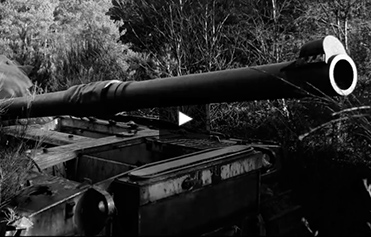 SALVAGE
SALVAGEInspired by a quote from the naturalist Jacques Yves Cousteau, this film explores the way in which nature clings to life, finds a foothold, and ultimately reclaims what is hers. The solidity of these metal beasts is questioned as the rust and flake slowly leak into the ground.
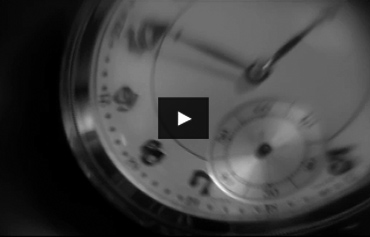 ELIPSIS
ELIPSIS Andy Joule is a film-maker and animator. He studied animation at West Surrey College of Art & Design. After graduating he worked in London, Manchester, Bristol, the Netherlands and in the US. His films have been screened in festivals and competitions around the world. He has lectured at Volda University College, Norway and is a Senior Lecturer in Animation at the University for the Creative Arts. He is also a BAFTA juror and a Fellow of the Royal Society of Arts.
Andy Joule is a film-maker and animator. He studied animation at West Surrey College of Art & Design. After graduating he worked in London, Manchester, Bristol, the Netherlands and in the US. His films have been screened in festivals and competitions around the world. He has lectured at Volda University College, Norway and is a Senior Lecturer in Animation at the University for the Creative Arts. He is also a BAFTA juror and a Fellow of the Royal Society of Arts.Andy Joule uses a combination of traditional and digital techniques, such as stop-motion, multi-layered image sequences and time-lapse. His time-lapses are more than just a technical sensation, closer to the fields of experimental video or fictional documentary. Time becomes the protagonist. Objects that seem to be inert at first, begin to change; a process that only becomes visible by the layer of time that is put over the presented sequences. In this way, the work of Joule brings about the manipulation, deconstruction and reinterpretation of time and space, proposing unconventional narratives and new ways of understanding time in short audiovisual formats.
 SALVAGE
SALVAGEInspired by a quote from the naturalist Jacques Yves Cousteau, this film explores the way in which nature clings to life, finds a foothold, and ultimately reclaims what is hers. The solidity of these metal beasts is questioned as the rust and flake slowly leak into the ground.
 ELIPSIS
ELIPSIS Andy Joule is a film-maker and animator. He studied animation at West Surrey College of Art & Design. After graduating he worked in London, Manchester, Bristol, the Netherlands and in the US. His films have been screened in festivals and competitions around the world. He has lectured at Volda University College, Norway and is a Senior Lecturer in Animation at the University for the Creative Arts. He is also a BAFTA juror and a Fellow of the Royal Society of Arts.
Andy Joule is a film-maker and animator. He studied animation at West Surrey College of Art & Design. After graduating he worked in London, Manchester, Bristol, the Netherlands and in the US. His films have been screened in festivals and competitions around the world. He has lectured at Volda University College, Norway and is a Senior Lecturer in Animation at the University for the Creative Arts. He is also a BAFTA juror and a Fellow of the Royal Society of Arts.Kent Krugh

This body of work, using linear accelerator x-rays of cameras, explores the micro-evolution of cameras over time. While form and media may have changed, the camera is still a camera: a tool to create images by capturing photons of light. In a sense, it is an homage to the cameras I have used and handled. A linear accelerator produces high energy particles and x-rays and is used in physics research and health care to treat cancer patients. The resulting images align with an inner desire to probe those unseen spaces and realms I sense exist, but do not observe with my eyes.


















 Kent Krugh is a fine art photographer, living and working in Greater Cincinnati, OH. Ten years ago he decided to dedicate himself to photography. He has received numerous awards in national and international competitions and was a Photolucida 2012 and 2014 Critical Mass Finalist.. His work has been exhibited in national and international group and solo venues. He also taught workshops in collaboration with Colegiatura Colombiana del Diseño, Fundación Universitaria de Bellas Artes and Centro Colombo Americano under the auspices of the Universidad de Antioquia. Krugh’s work has been exhibited at three major festivals: Fringe Festival 2010, Cincinnati, OH; FotoFest Biennial 2012, Houston, TX; and FotoFocus Biennial 2012, Cincinnati, OH. Krugh's work can be found in numerous private collections and museums including the Portland Art Museum and the Cleveland Museum of Art.
Kent Krugh is a fine art photographer, living and working in Greater Cincinnati, OH. Ten years ago he decided to dedicate himself to photography. He has received numerous awards in national and international competitions and was a Photolucida 2012 and 2014 Critical Mass Finalist.. His work has been exhibited in national and international group and solo venues. He also taught workshops in collaboration with Colegiatura Colombiana del Diseño, Fundación Universitaria de Bellas Artes and Centro Colombo Americano under the auspices of the Universidad de Antioquia. Krugh’s work has been exhibited at three major festivals: Fringe Festival 2010, Cincinnati, OH; FotoFest Biennial 2012, Houston, TX; and FotoFocus Biennial 2012, Cincinnati, OH. Krugh's work can be found in numerous private collections and museums including the Portland Art Museum and the Cleveland Museum of Art.[core_state] => 1 [core_access] => 1 [core_metadata] => {"robots":"","author":"Kent Krugh","rights":"","xreference":""} [core_created_user_id] => 838 [core_created_by_alias] => [core_created_time] => 2015-02-10 21:22:20 [core_images] => {"image_intro":"images\/categories\/open-content\/krugh.jpg","float_intro":"","image_intro_alt":"","image_intro_caption":"","image_fulltext":"images\/categories\/open-content\/krugh.jpg","float_fulltext":"","image_fulltext_alt":"","image_fulltext_caption":""} [core_modified_time] => 2016-06-22 18:25:45 [core_language] => en-GB [core_catid] => 37 [core_publish_up] => 2015-02-10 21:22:20 [core_publish_down] => 0000-00-00 00:00:00 [content_type_title] => Article [router] => ContentHelperRoute::getArticleRoute [author] => Elisa Rugo [author_email] => elisa@zonezero.com [link] => index.php?option=com_content&view=article&id=248:speciation&catid=37&lang=en-GB [displayDate] => 2015-02-10 21:22:20 [event] => stdClass Object ( [afterDisplayTitle] => [beforeDisplayContent] => [afterDisplayContent] => ) [text] =>

This body of work, using linear accelerator x-rays of cameras, explores the micro-evolution of cameras over time. While form and media may have changed, the camera is still a camera: a tool to create images by capturing photons of light. In a sense, it is an homage to the cameras I have used and handled. A linear accelerator produces high energy particles and x-rays and is used in physics research and health care to treat cancer patients. The resulting images align with an inner desire to probe those unseen spaces and realms I sense exist, but do not observe with my eyes.


















 Kent Krugh is a fine art photographer, living and working in Greater Cincinnati, OH. Ten years ago he decided to dedicate himself to photography. He has received numerous awards in national and international competitions and was a Photolucida 2012 and 2014 Critical Mass Finalist.. His work has been exhibited in national and international group and solo venues. He also taught workshops in collaboration with Colegiatura Colombiana del Diseño, Fundación Universitaria de Bellas Artes and Centro Colombo Americano under the auspices of the Universidad de Antioquia. Krugh’s work has been exhibited at three major festivals: Fringe Festival 2010, Cincinnati, OH; FotoFest Biennial 2012, Houston, TX; and FotoFocus Biennial 2012, Cincinnati, OH. Krugh's work can be found in numerous private collections and museums including the Portland Art Museum and the Cleveland Museum of Art.
Kent Krugh is a fine art photographer, living and working in Greater Cincinnati, OH. Ten years ago he decided to dedicate himself to photography. He has received numerous awards in national and international competitions and was a Photolucida 2012 and 2014 Critical Mass Finalist.. His work has been exhibited in national and international group and solo venues. He also taught workshops in collaboration with Colegiatura Colombiana del Diseño, Fundación Universitaria de Bellas Artes and Centro Colombo Americano under the auspices of the Universidad de Antioquia. Krugh’s work has been exhibited at three major festivals: Fringe Festival 2010, Cincinnati, OH; FotoFest Biennial 2012, Houston, TX; and FotoFocus Biennial 2012, Cincinnati, OH. Krugh's work can be found in numerous private collections and museums including the Portland Art Museum and the Cleveland Museum of Art.[id] => 248 [language] => en-GB [catid] => 37 [jcfields] => Array ( ) ) 1
Marta María Pérez

During a lifetime of work, Marta Maria Perez Bravo has explored the rites and beliefs of Cuban religion through her own image. Her body sacrifices the symbol, creating an account of intersections between dualities, such as the visible and the invisible, the material and the spiritual, life after death, the presence of absence. That reiteration of opposites uses its own aesthetic to create narratives that, supported by the photographic document, build a universe of re-creations of rites and ceremonial objects.
Currently, her artistic proposal has led her to use other visual mediums with which she complements and continues to investigate her conceptual interests.














 Marta María Pérez Bravo (Cuba, 1959). Lives and works in Mexico. Photographer. She began her studies as an artist in 1979 at the School of Visual Arts San Alejandro, Havana, Cuba. In 1984 she continued her studies at the Instituto Superior de Arte (ISA), Havana, Cuba. She has participated in numerous international solo and group exhibitions. She has won several awards for her work, such as the Guggenheim Fellowship (USA) in 1998.
Marta María Pérez Bravo (Cuba, 1959). Lives and works in Mexico. Photographer. She began her studies as an artist in 1979 at the School of Visual Arts San Alejandro, Havana, Cuba. In 1984 she continued her studies at the Instituto Superior de Arte (ISA), Havana, Cuba. She has participated in numerous international solo and group exhibitions. She has won several awards for her work, such as the Guggenheim Fellowship (USA) in 1998.ZZ. In your work, self-representation is a constant theme, ¿how did your interest in talking about various themes through your own image arise?
MM. I studied Fine Arts, but my graduate thesis, at the Instituto Superior de Arte in Havana (1984), was a photographic project, even though I never studied photography. This project consisted of photographs documenting actions that I performed outdoors, taking as its theme the popular superstitions regarding natural phenomena, appearances etc. When I was pregnant, I could no longer do these performances and I started using my own body. I started to document, in a different way, other actions related to these superstitions and popular beliefs, but now regarding my experience of motherhood. As in the first stage, these realities were constructed and ‘staged’. So, from the beginning, it was clear that using a model or another person, and not my own body would completely change the concept of the work, given that it has a strong autobiographical presence, although implicitly.
ZZ. We see that themes, like evocation and absence, are constant in your work. How have these themes continued to change throughout your career?
MM. In my work, religious themes, especially of afro-cuban origin, started to emerge. The constructed realities (constructed through the staged scenes), that are devoid of time and space, are re-creations (not recreations) of rites and ritual objects.
ZZ. What is the symbolic value of the objects in your photos? What place do you give to the objects as symbols in your photos? What does their reiterative use signify?
From the ritual objects I want to extract a meaning that goes beyond the form, though the making of these objects is done with reference to the originals and the use they are given in religious practices. Although my photography is always black and white, I use the original colors in the elaboration of these objects as a token of respect for these practices and real liturgical objects. Nevertheless, I don’t want the spectator to be distracted by these colors; I want him to focus his attention on the symbols and their meanings. Even though he might not know them at all (since they are object of separate study and profound analysis) my intention is that, when these symbols are interpreted, they evoke ideas and suggest and provoke sensations. In addition to this, the title is a fundamental part of each piece.
ZZ. How does photography help you in the search of your identity? And, what has the use of video added to your work?
Since the beginning of my work in the eighties, my work has been photographic, although five or six years ago it went through a formal change –not its concept nor its aesthetic– through the use of video. The only aspects that make these videos different from my photographic work is the existence of space and the time in which an action occurs. Besides that, my work has not changed; in representing my ideas, I maintain the minimalistic aesthetic, I use the same materials and concepts, I still use black and white and I don’t use audio.
I don’t exactly know in which moment I started using video, but I think it happened in a very natural way, or, in other words, the development of the work itself brought me to it. Actually, people had asked me why I didn’t make videos, because of the performative character of my work, but at the time I, as an artist, was not at all interested in the idea, even though later on I permanently incorporated this medium into my work.
ZZ. What has been the result of your search throughout these years and which course is it taking?
Currently I tend to use video as a medium and not photography, but I still maintain my own aesthetic and conceptual parameters. The only difference is that, at the moment, video is a perfect medium for what I want. Surely the development of my work will lead me to other formal solutions in the future.
I have always thought that maybe a lot of the success of an artist’s work depends on finding the right tool with which he can express and “realize” his ideas.

During a lifetime of work, Marta Maria Perez Bravo has explored the rites and beliefs of Cuban religion through her own image. Her body sacrifices the symbol, creating an account of intersections between dualities, such as the visible and the invisible, the material and the spiritual, life after death, the presence of absence. That reiteration of opposites uses its own aesthetic to create narratives that, supported by the photographic document, build a universe of re-creations of rites and ceremonial objects.
Currently, her artistic proposal has led her to use other visual mediums with which she complements and continues to investigate her conceptual interests.














 Marta María Pérez Bravo (Cuba, 1959). Lives and works in Mexico. Photographer. She began her studies as an artist in 1979 at the School of Visual Arts San Alejandro, Havana, Cuba. In 1984 she continued her studies at the Instituto Superior de Arte (ISA), Havana, Cuba. She has participated in numerous international solo and group exhibitions. She has won several awards for her work, such as the Guggenheim Fellowship (USA) in 1998.
Marta María Pérez Bravo (Cuba, 1959). Lives and works in Mexico. Photographer. She began her studies as an artist in 1979 at the School of Visual Arts San Alejandro, Havana, Cuba. In 1984 she continued her studies at the Instituto Superior de Arte (ISA), Havana, Cuba. She has participated in numerous international solo and group exhibitions. She has won several awards for her work, such as the Guggenheim Fellowship (USA) in 1998.ZZ. In your work, self-representation is a constant theme, ¿how did your interest in talking about various themes through your own image arise?
MM. I studied Fine Arts, but my graduate thesis, at the Instituto Superior de Arte in Havana (1984), was a photographic project, even though I never studied photography. This project consisted of photographs documenting actions that I performed outdoors, taking as its theme the popular superstitions regarding natural phenomena, appearances etc. When I was pregnant, I could no longer do these performances and I started using my own body. I started to document, in a different way, other actions related to these superstitions and popular beliefs, but now regarding my experience of motherhood. As in the first stage, these realities were constructed and ‘staged’. So, from the beginning, it was clear that using a model or another person, and not my own body would completely change the concept of the work, given that it has a strong autobiographical presence, although implicitly.
ZZ. We see that themes, like evocation and absence, are constant in your work. How have these themes continued to change throughout your career?
MM. In my work, religious themes, especially of afro-cuban origin, started to emerge. The constructed realities (constructed through the staged scenes), that are devoid of time and space, are re-creations (not recreations) of rites and ritual objects.
ZZ. What is the symbolic value of the objects in your photos? What place do you give to the objects as symbols in your photos? What does their reiterative use signify?
From the ritual objects I want to extract a meaning that goes beyond the form, though the making of these objects is done with reference to the originals and the use they are given in religious practices. Although my photography is always black and white, I use the original colors in the elaboration of these objects as a token of respect for these practices and real liturgical objects. Nevertheless, I don’t want the spectator to be distracted by these colors; I want him to focus his attention on the symbols and their meanings. Even though he might not know them at all (since they are object of separate study and profound analysis) my intention is that, when these symbols are interpreted, they evoke ideas and suggest and provoke sensations. In addition to this, the title is a fundamental part of each piece.
ZZ. How does photography help you in the search of your identity? And, what has the use of video added to your work?
Since the beginning of my work in the eighties, my work has been photographic, although five or six years ago it went through a formal change –not its concept nor its aesthetic– through the use of video. The only aspects that make these videos different from my photographic work is the existence of space and the time in which an action occurs. Besides that, my work has not changed; in representing my ideas, I maintain the minimalistic aesthetic, I use the same materials and concepts, I still use black and white and I don’t use audio.
I don’t exactly know in which moment I started using video, but I think it happened in a very natural way, or, in other words, the development of the work itself brought me to it. Actually, people had asked me why I didn’t make videos, because of the performative character of my work, but at the time I, as an artist, was not at all interested in the idea, even though later on I permanently incorporated this medium into my work.
ZZ. What has been the result of your search throughout these years and which course is it taking?
Currently I tend to use video as a medium and not photography, but I still maintain my own aesthetic and conceptual parameters. The only difference is that, at the moment, video is a perfect medium for what I want. Surely the development of my work will lead me to other formal solutions in the future.
I have always thought that maybe a lot of the success of an artist’s work depends on finding the right tool with which he can express and “realize” his ideas.
Josef Wladyka

My mother left Japan more than thirty years ago and didn't return until November 2010. This is her story.
Location: Tokyo, Japan.
Cinematography: Stan Wladyka.
Music: Tyler Parkinson.
Okaasan お母さん
Beginning as a child performer in Odessa, Russia, Albert Makhtsier has been acting for over half a century. Despite being diagnosed with Parkinson's disease, Albert remains one of New York City's finest actors. This is his story.
Location: Times Square, New York City.
Cinematography: Alan Blanco.
Music: Tyler Cash.
Albert Makhtsier
Curai is a small, tight knit fishing village on the Southern Pacific Coast of Colombia. It's a place where almost everyone shares the same last name. Jacobo is a community leader there and this is one of his stories.
Location: Curai, Colombia.
Cinematography by Leonardo D'Antoni.
Music by Tyler Cash.
Jacobo Castillo Salazar
These are a collection of peoples' personal stories told through a single shot. Each story is an exploration of the universal essence of the human condition and our connection to one another that extends beyond any boundaries.
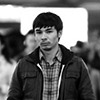 Josef Wladyka. Lives in New York. Influenced by his parents, Josef developed a fascination for movies from a very young age. He began experimenting with filmmaking in high school and has since created several (short) films and commercials that have been screened at festivals around the world. He holds a MFA from NYU Tisch Graduate Film where he won a Spike Lee Fellowship. His debut feature film, Manos Sucias (2014), has won various awards.
Josef Wladyka. Lives in New York. Influenced by his parents, Josef developed a fascination for movies from a very young age. He began experimenting with filmmaking in high school and has since created several (short) films and commercials that have been screened at festivals around the world. He holds a MFA from NYU Tisch Graduate Film where he won a Spike Lee Fellowship. His debut feature film, Manos Sucias (2014), has won various awards.
My mother left Japan more than thirty years ago and didn't return until November 2010. This is her story.
Location: Tokyo, Japan.
Cinematography: Stan Wladyka.
Music: Tyler Parkinson.
Okaasan お母さん
Beginning as a child performer in Odessa, Russia, Albert Makhtsier has been acting for over half a century. Despite being diagnosed with Parkinson's disease, Albert remains one of New York City's finest actors. This is his story.
Location: Times Square, New York City.
Cinematography: Alan Blanco.
Music: Tyler Cash.
Albert Makhtsier
Curai is a small, tight knit fishing village on the Southern Pacific Coast of Colombia. It's a place where almost everyone shares the same last name. Jacobo is a community leader there and this is one of his stories.
Location: Curai, Colombia.
Cinematography by Leonardo D'Antoni.
Music by Tyler Cash.
Jacobo Castillo Salazar
These are a collection of peoples' personal stories told through a single shot. Each story is an exploration of the universal essence of the human condition and our connection to one another that extends beyond any boundaries.
 Josef Wladyka. Lives in New York. Influenced by his parents, Josef developed a fascination for movies from a very young age. He began experimenting with filmmaking in high school and has since created several (short) films and commercials that have been screened at festivals around the world. He holds a MFA from NYU Tisch Graduate Film where he won a Spike Lee Fellowship. His debut feature film, Manos Sucias (2014), has won various awards.
Josef Wladyka. Lives in New York. Influenced by his parents, Josef developed a fascination for movies from a very young age. He began experimenting with filmmaking in high school and has since created several (short) films and commercials that have been screened at festivals around the world. He holds a MFA from NYU Tisch Graduate Film where he won a Spike Lee Fellowship. His debut feature film, Manos Sucias (2014), has won various awards.Noah Kalina
Noah Kalina has been taking a photograph of himself every day since January 2000. Originally it was meant to be a photo project, but in 2006 he was inspired by a project by Ahree Lee, a graphic designer from California who had put a time-lapse video of herself on YouTube. Noah decided to do the same with his self-portraits and, within three weeks, it became an international internet sensation.
 Noah Kalina (US, 1980) is a photographer based in Brooklyn and Lumberland, New York. He graduated from the School of Visual Arts with a BFA in photography. His project ‘Everyday’ was a worldwide hit. His work has been exhibited all over the world: in the U.S., Switzerland, Italy, Belgium, France, Australia, England, Canada, Germany and the Netherlands. He also has given lectures in various countries. To see more of his work go to: noahkalina.com
Noah Kalina (US, 1980) is a photographer based in Brooklyn and Lumberland, New York. He graduated from the School of Visual Arts with a BFA in photography. His project ‘Everyday’ was a worldwide hit. His work has been exhibited all over the world: in the U.S., Switzerland, Italy, Belgium, France, Australia, England, Canada, Germany and the Netherlands. He also has given lectures in various countries. To see more of his work go to: noahkalina.comNoah Kalina has been taking a photograph of himself every day since January 2000. Originally it was meant to be a photo project, but in 2006 he was inspired by a project by Ahree Lee, a graphic designer from California who had put a time-lapse video of herself on YouTube. Noah decided to do the same with his self-portraits and, within three weeks, it became an international internet sensation.
 Noah Kalina (US, 1980) is a photographer based in Brooklyn and Lumberland, New York. He graduated from the School of Visual Arts with a BFA in photography. His project ‘Everyday’ was a worldwide hit. His work has been exhibited all over the world: in the U.S., Switzerland, Italy, Belgium, France, Australia, England, Canada, Germany and the Netherlands. He also has given lectures in various countries. To see more of his work go to: noahkalina.com
Noah Kalina (US, 1980) is a photographer based in Brooklyn and Lumberland, New York. He graduated from the School of Visual Arts with a BFA in photography. His project ‘Everyday’ was a worldwide hit. His work has been exhibited all over the world: in the U.S., Switzerland, Italy, Belgium, France, Australia, England, Canada, Germany and the Netherlands. He also has given lectures in various countries. To see more of his work go to: noahkalina.comXtabay Alderete
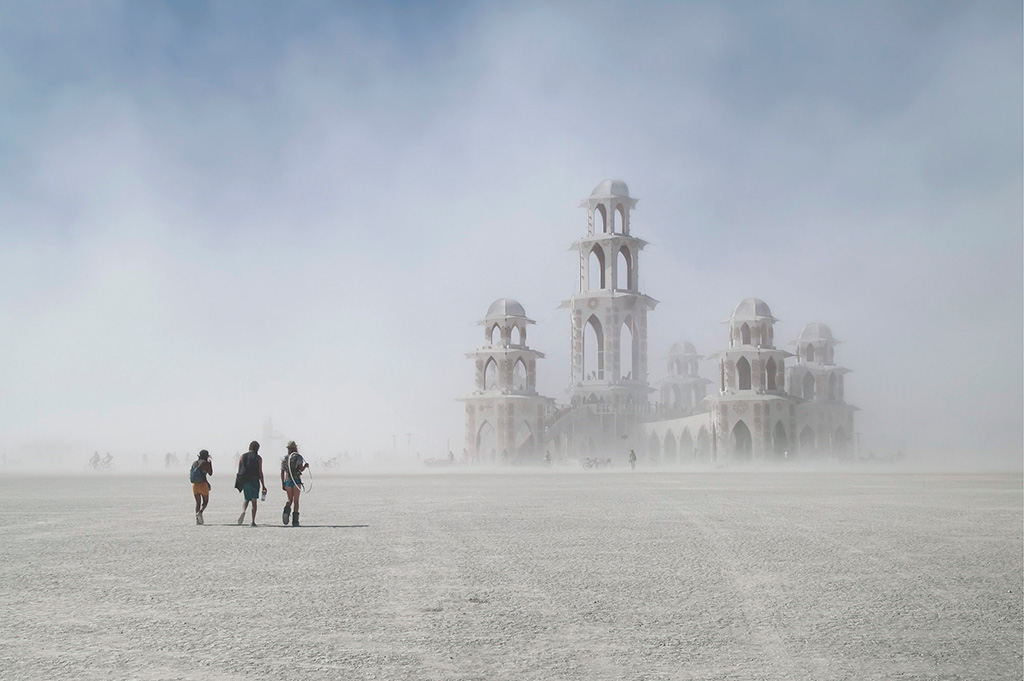

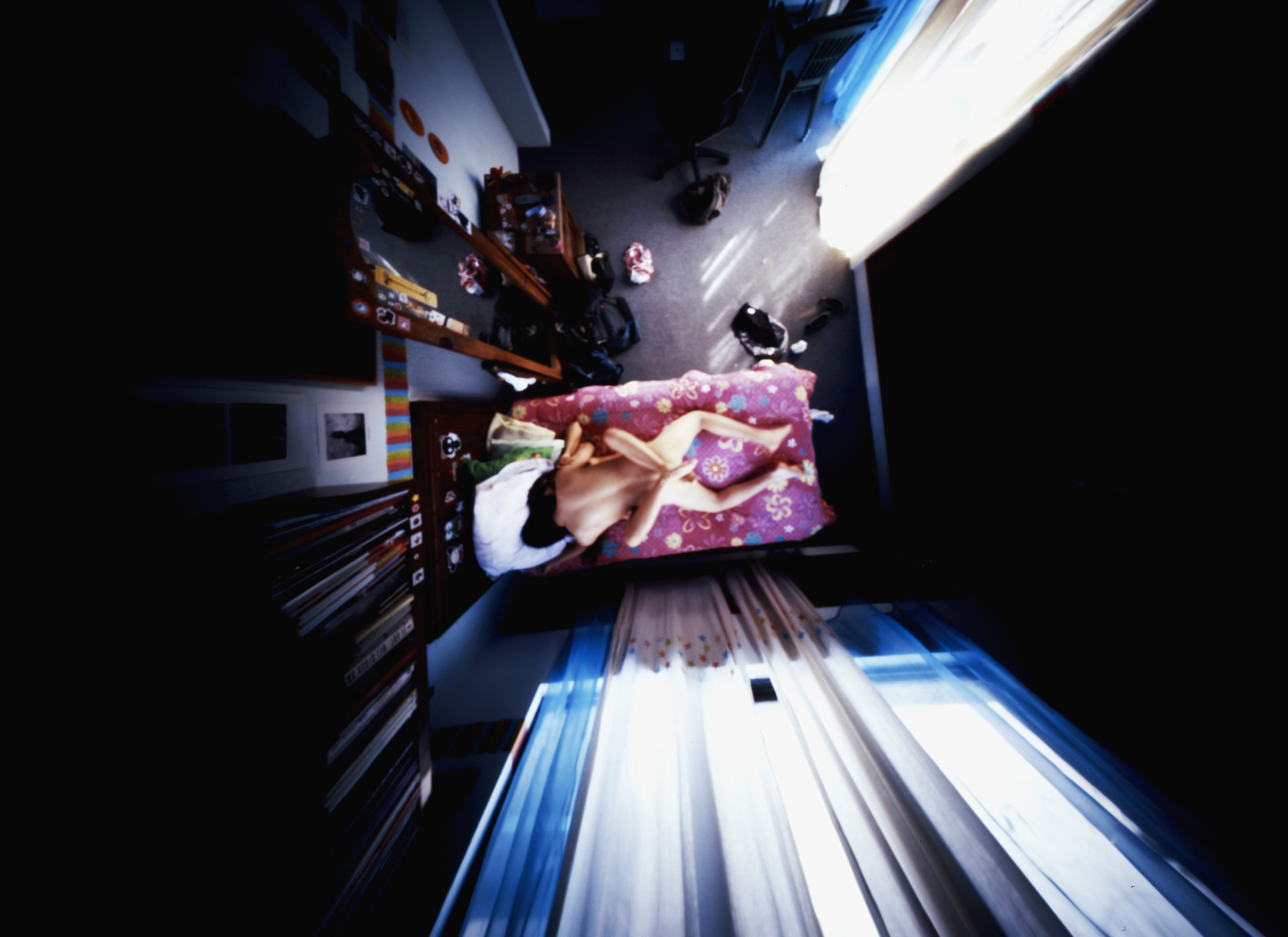
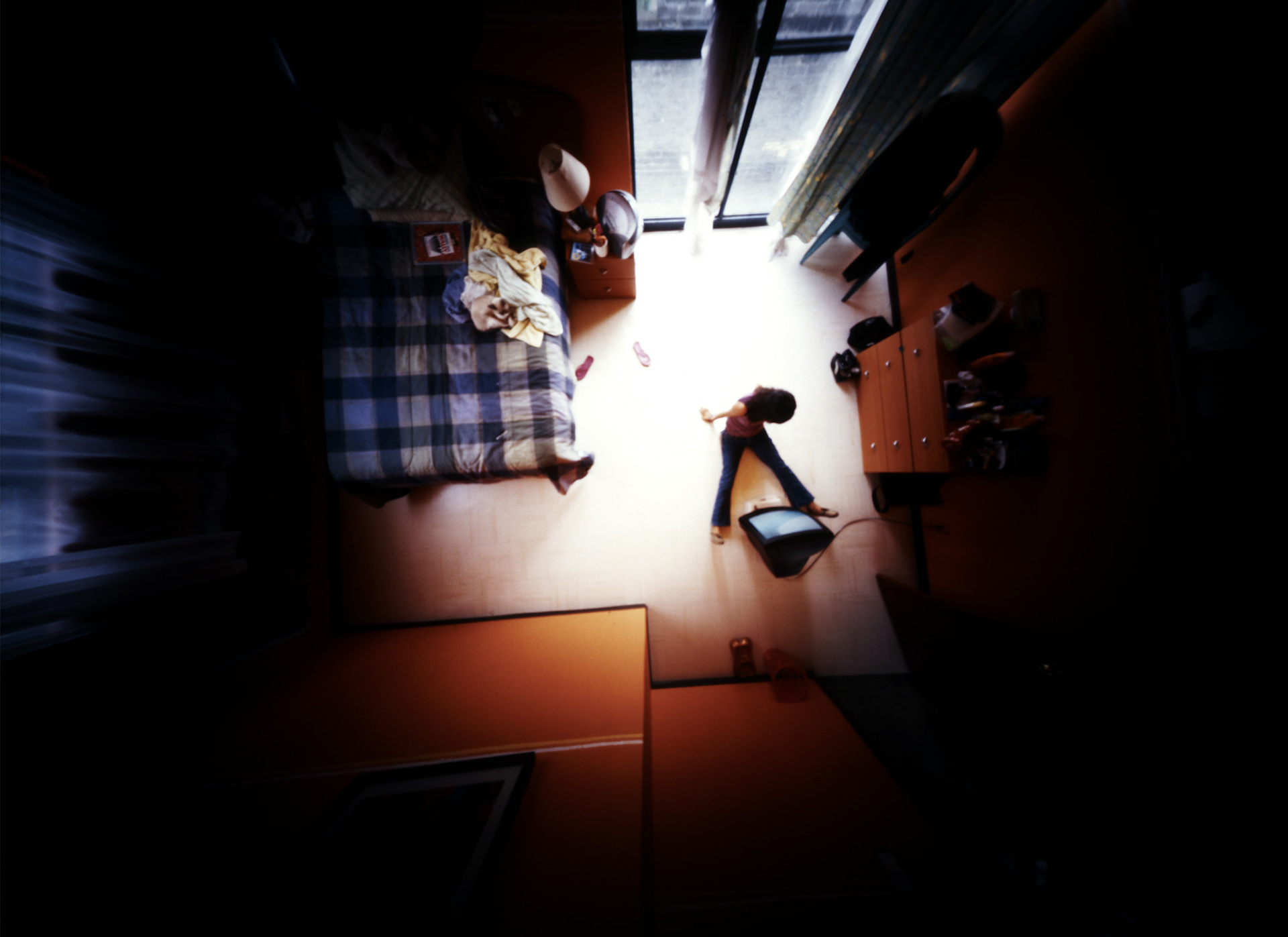
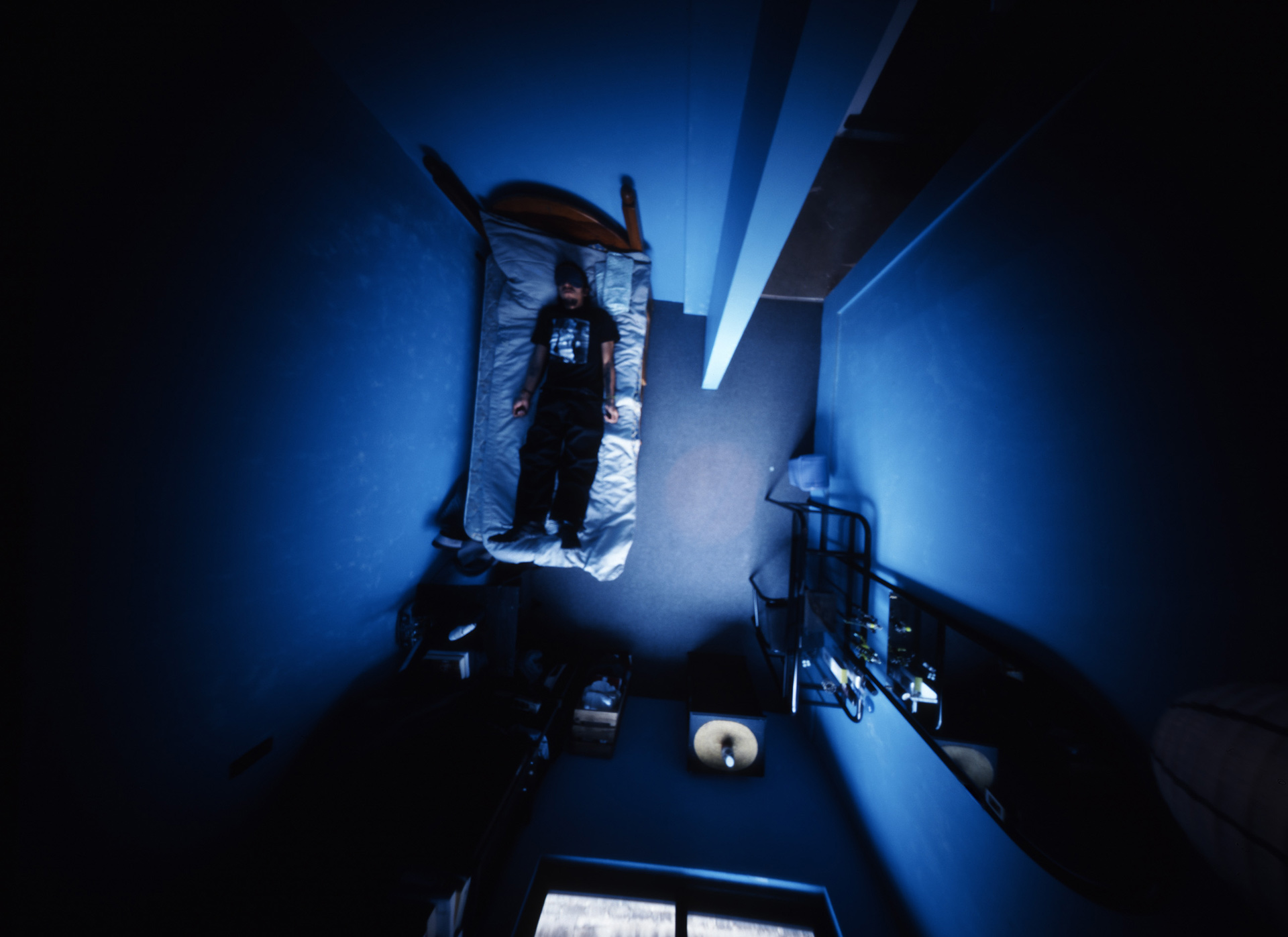
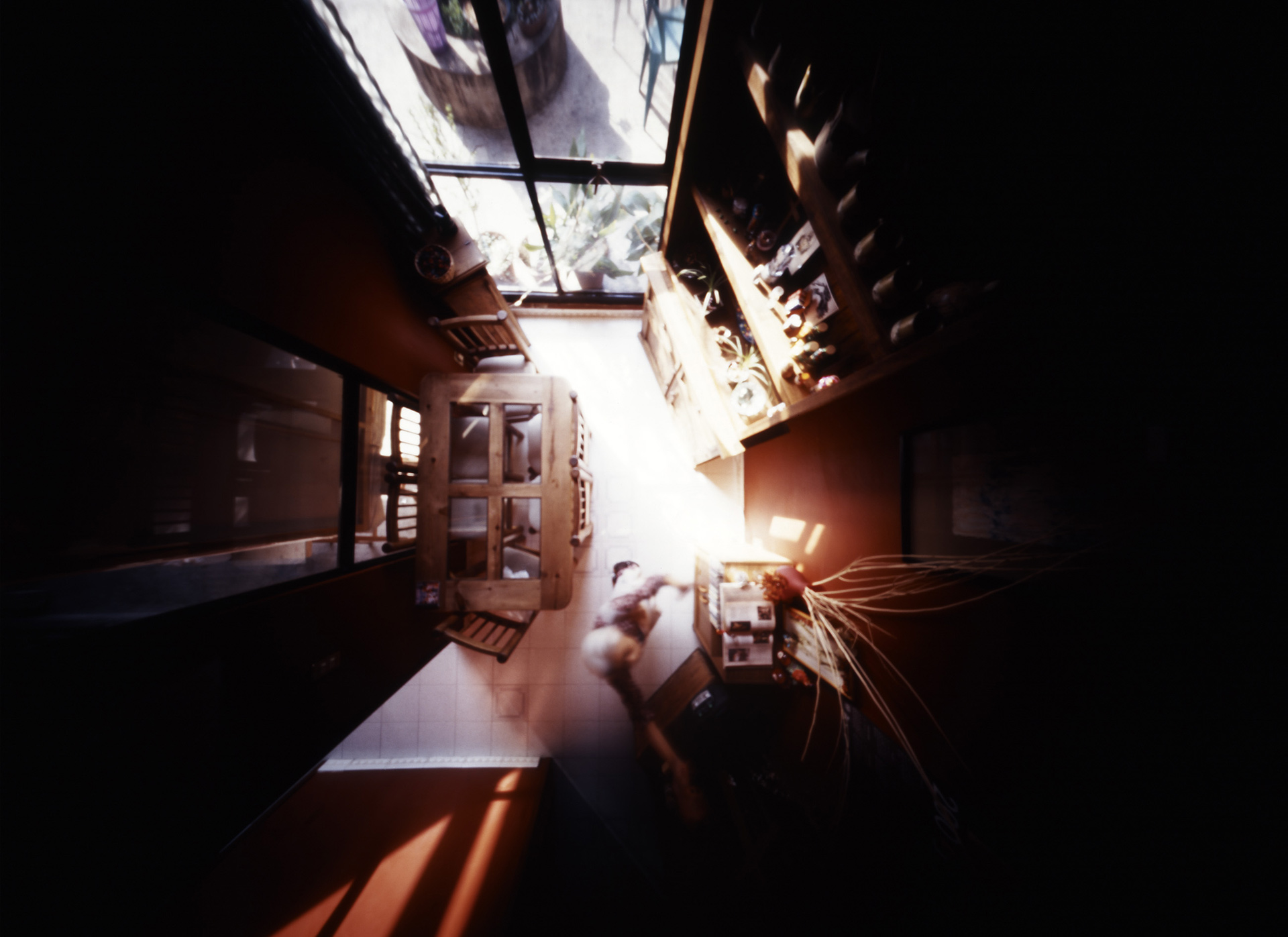
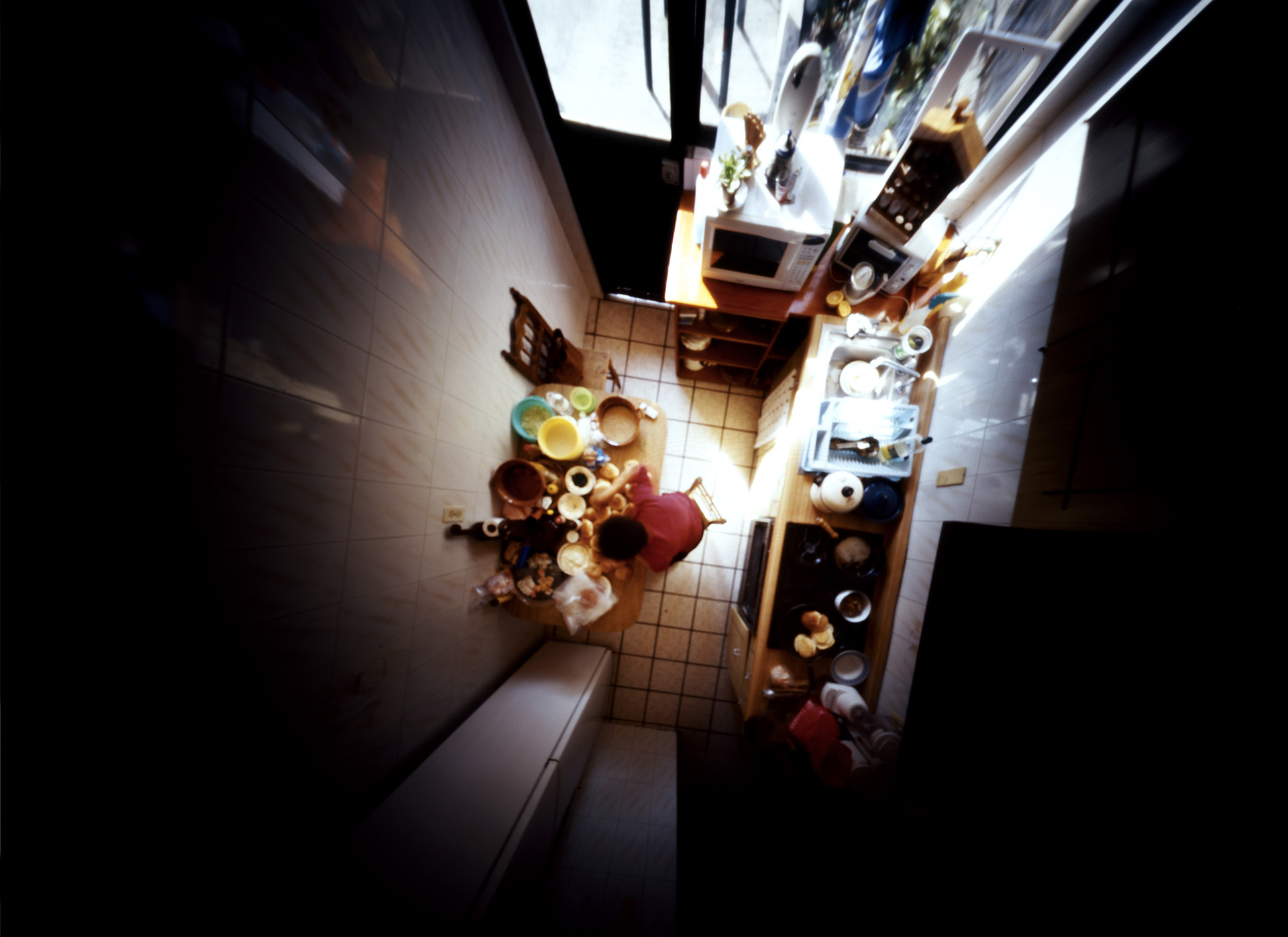
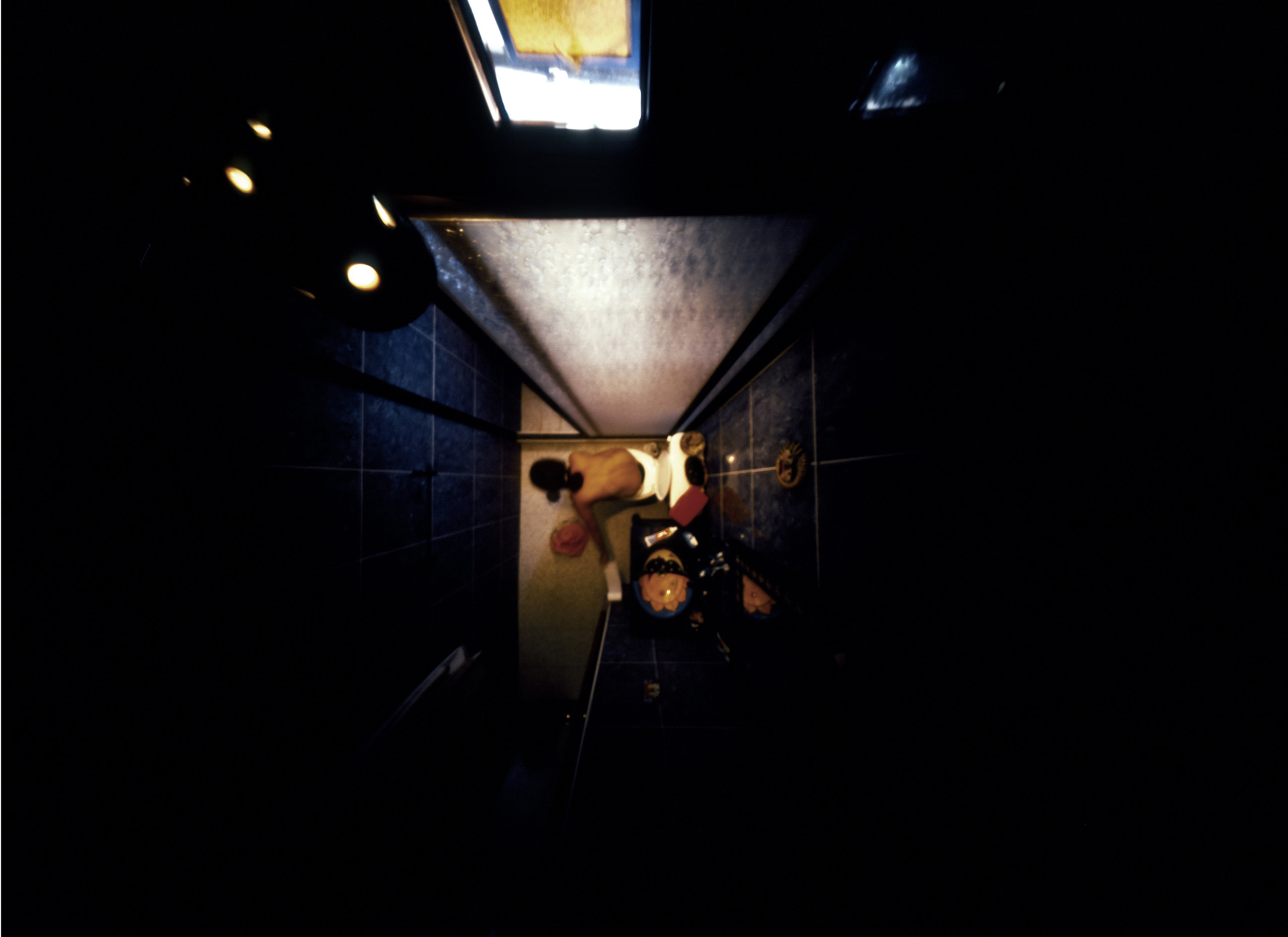
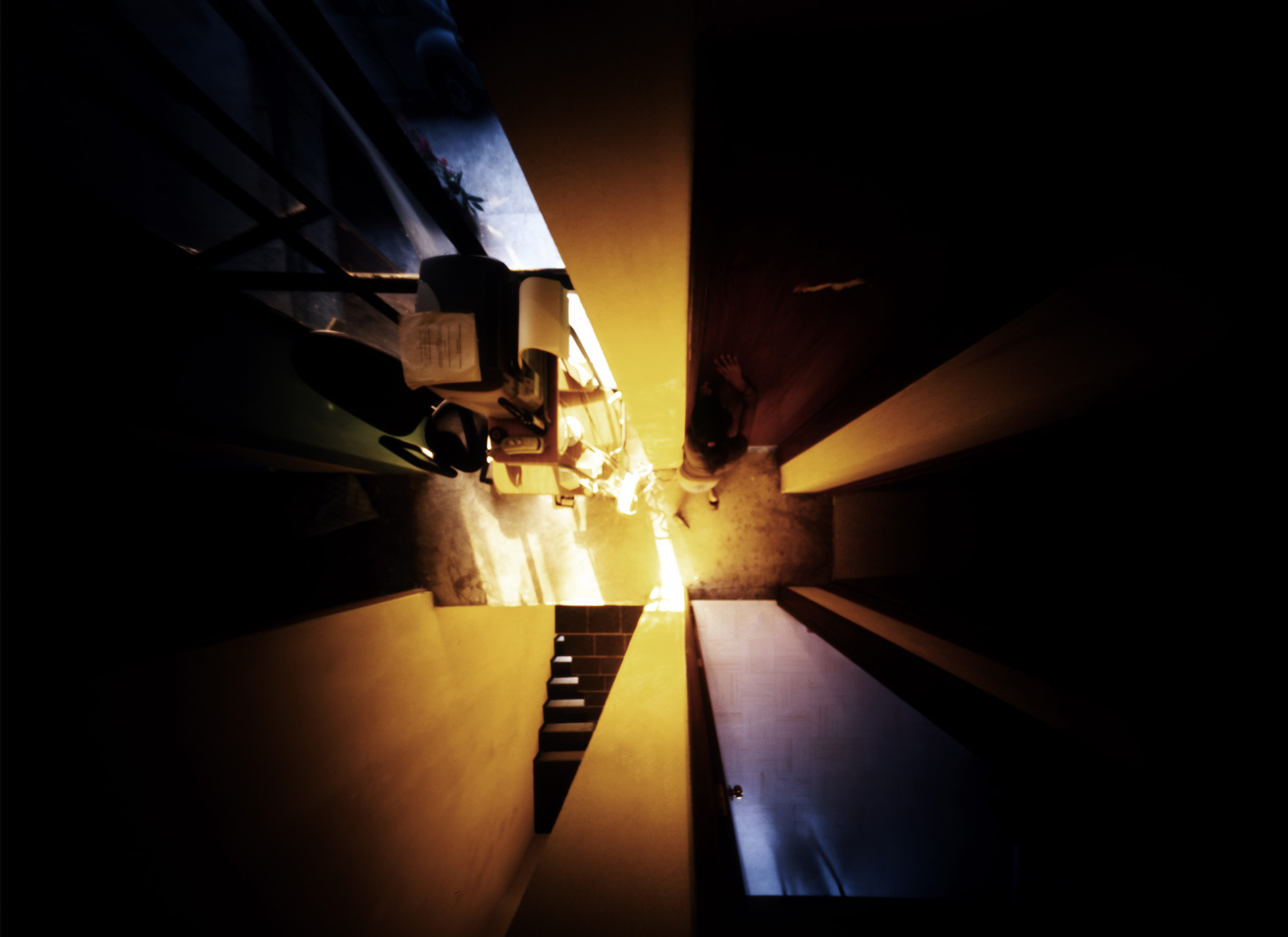
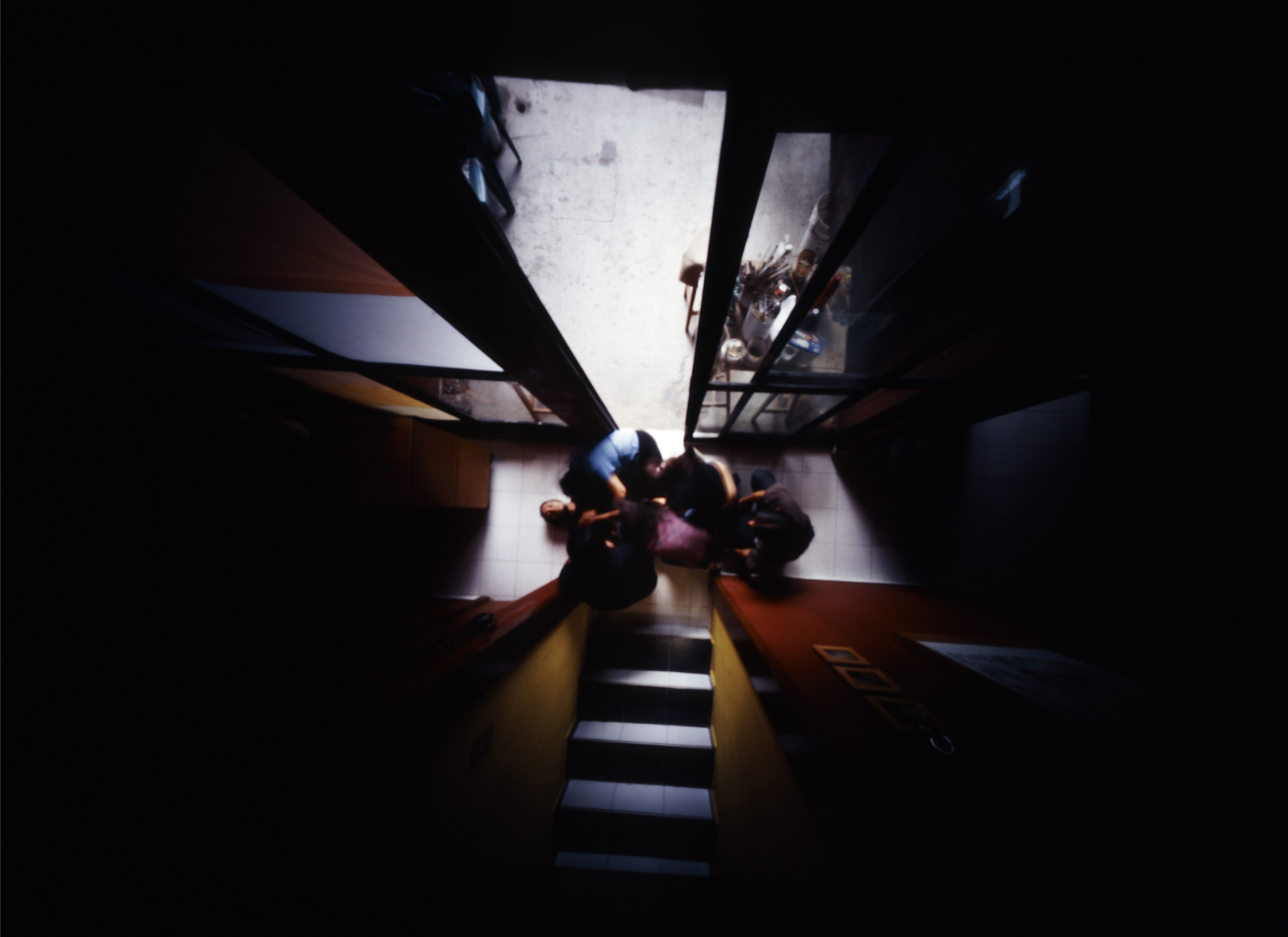
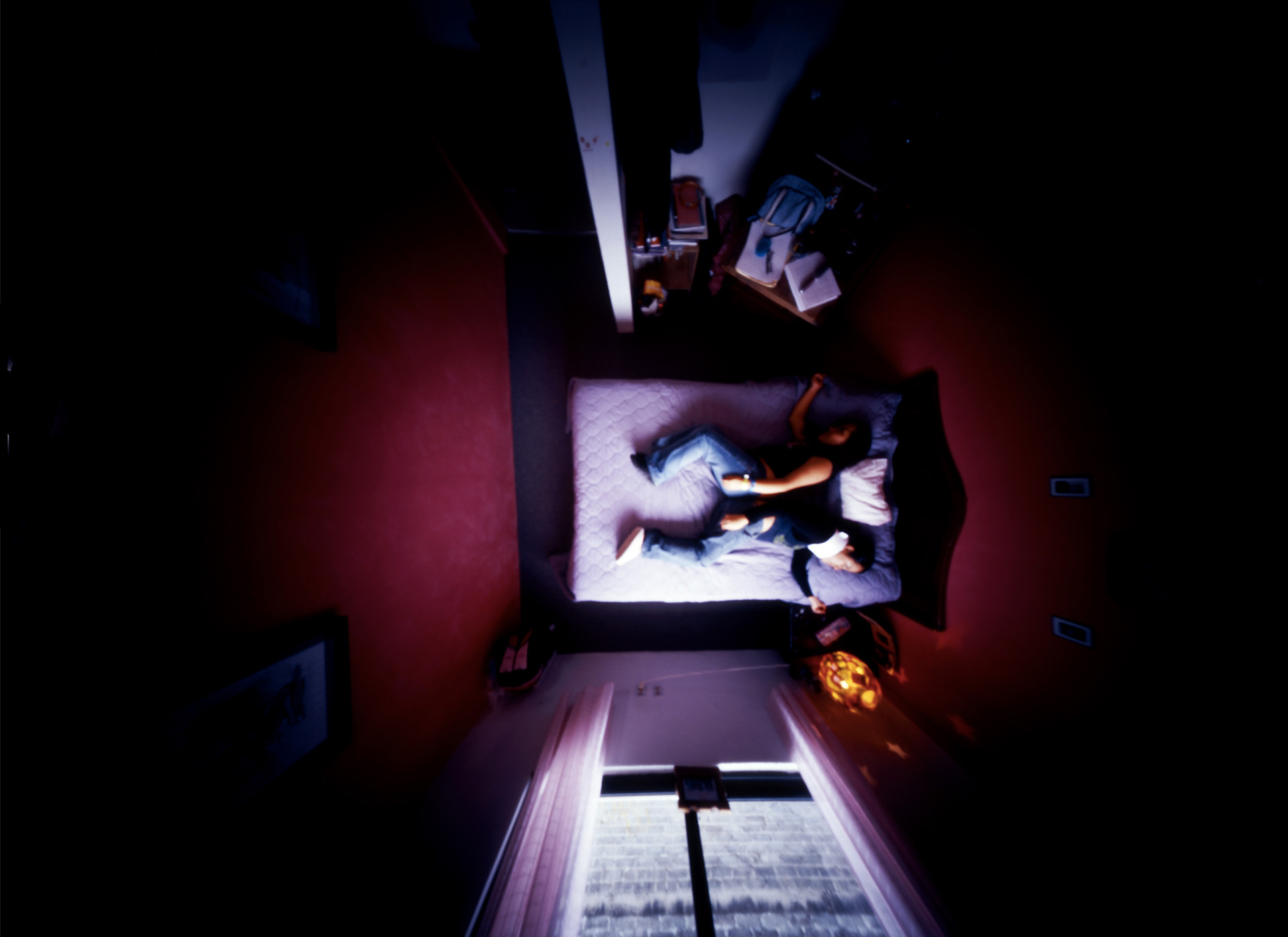
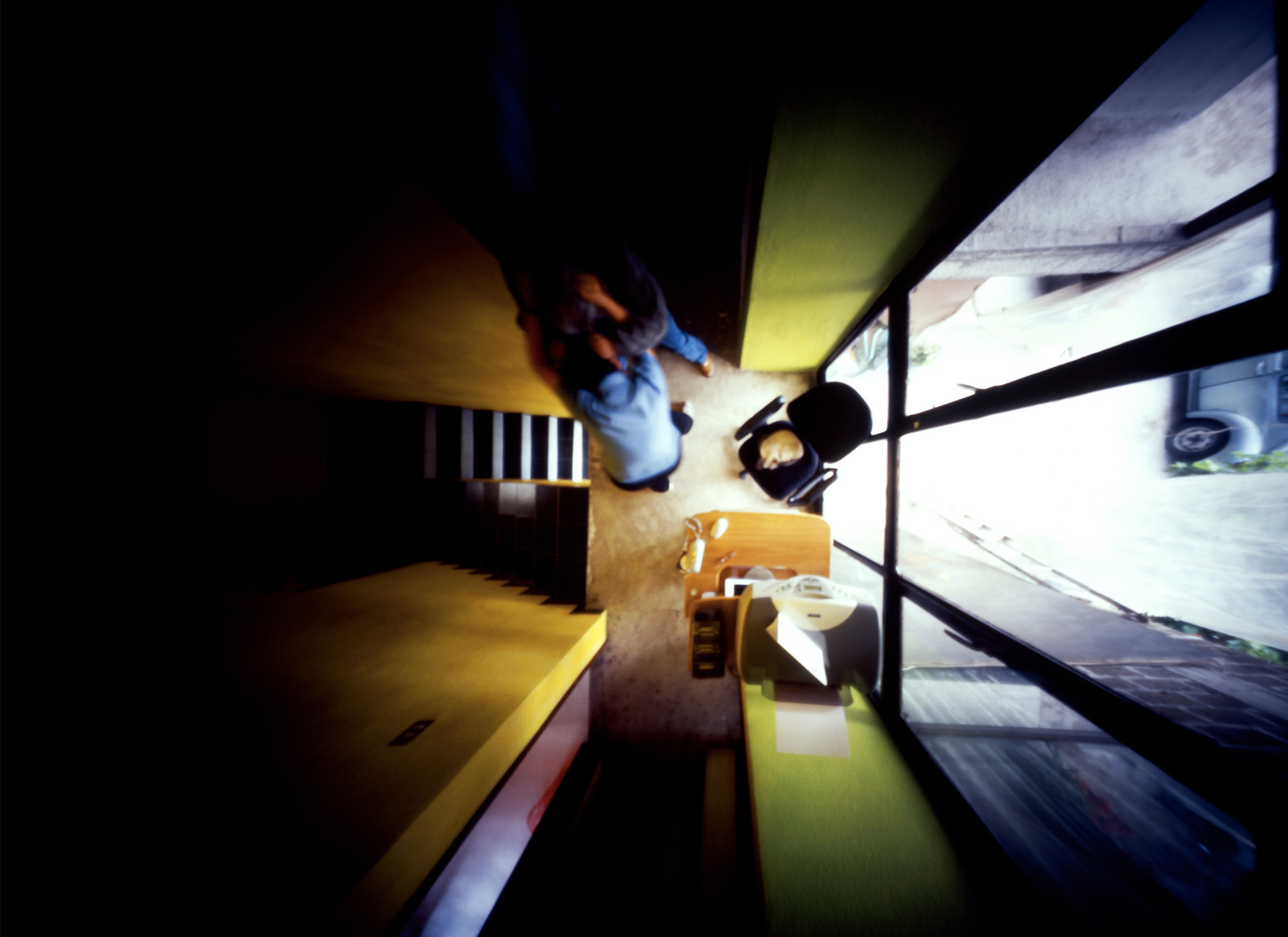
This project is based on the idea of the vigilant eye that threatens us to do no wrong. With this idea in mind, the author depicts her family environment, from conflicts to normal daily life, as if they were being monitored by a divine, human or mechanical being (God, spies or Big Brother). She presents these images from the point of view that each one of us is somehow controlled by a system, which reinforces the moral burden one feels when committing sins, crimes and mistakes.
The work presents daily life through images taken from different angles. With her handmade pinhole camera, the author establishes a certain feeling of omnipresence. She allows us to immerse ourselves in her experiences and the daily life between the walls of her home, giving the spectator a panoptic vision of her family as the so-called social unit of our times. Proving, in the end, that the society of the spectacle has encouraged a certain voyeurism through reality shows, which compel us to take sides and to judge the acts of the observed, and which puts us in the position of the divine being that tilts the scale of judgement towards the good or the bad.
We invite you to learn more about the preoccupations and the questionings of the author through this video.
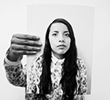 Xtabay Alderete (Mexico, 1979). Lives and works in Mexico City. Graduated from the School of Visual Arts, UNAM, with a bachelor´s degree in Visual Arts. At present, she studies a master in Visual Arts at the Academy of San Carlos, UNAM. Her artistic work focuses primarily on photography. In 2013 she took part in the exhibition (Re)Presentations, Contemporary Latin-American Photography, organised by PHotoEspaña, Madrid. Currently, she intervenes in landscapes that contain memory, oblivion, death and devastation, using objects.
Xtabay Alderete (Mexico, 1979). Lives and works in Mexico City. Graduated from the School of Visual Arts, UNAM, with a bachelor´s degree in Visual Arts. At present, she studies a master in Visual Arts at the Academy of San Carlos, UNAM. Her artistic work focuses primarily on photography. In 2013 she took part in the exhibition (Re)Presentations, Contemporary Latin-American Photography, organised by PHotoEspaña, Madrid. Currently, she intervenes in landscapes that contain memory, oblivion, death and devastation, using objects.











This project is based on the idea of the vigilant eye that threatens us to do no wrong. With this idea in mind, the author depicts her family environment, from conflicts to normal daily life, as if they were being monitored by a divine, human or mechanical being (God, spies or Big Brother). She presents these images from the point of view that each one of us is somehow controlled by a system, which reinforces the moral burden one feels when committing sins, crimes and mistakes.
The work presents daily life through images taken from different angles. With her handmade pinhole camera, the author establishes a certain feeling of omnipresence. She allows us to immerse ourselves in her experiences and the daily life between the walls of her home, giving the spectator a panoptic vision of her family as the so-called social unit of our times. Proving, in the end, that the society of the spectacle has encouraged a certain voyeurism through reality shows, which compel us to take sides and to judge the acts of the observed, and which puts us in the position of the divine being that tilts the scale of judgement towards the good or the bad.
We invite you to learn more about the preoccupations and the questionings of the author through this video.
 Xtabay Alderete (Mexico, 1979). Lives and works in Mexico City. Graduated from the School of Visual Arts, UNAM, with a bachelor´s degree in Visual Arts. At present, she studies a master in Visual Arts at the Academy of San Carlos, UNAM. Her artistic work focuses primarily on photography. In 2013 she took part in the exhibition (Re)Presentations, Contemporary Latin-American Photography, organised by PHotoEspaña, Madrid. Currently, she intervenes in landscapes that contain memory, oblivion, death and devastation, using objects.
Xtabay Alderete (Mexico, 1979). Lives and works in Mexico City. Graduated from the School of Visual Arts, UNAM, with a bachelor´s degree in Visual Arts. At present, she studies a master in Visual Arts at the Academy of San Carlos, UNAM. Her artistic work focuses primarily on photography. In 2013 she took part in the exhibition (Re)Presentations, Contemporary Latin-American Photography, organised by PHotoEspaña, Madrid. Currently, she intervenes in landscapes that contain memory, oblivion, death and devastation, using objects.ZoneZero
Interview with Xtabay Alderete about her process of Panopticon series. Visit her gallery here.
July 2014 by ZoneZero.
 Xtabay Alderete (Mexico, 1979). Lives and works in Mexico City. Graduated from the School of Visual Arts, UNAM, with a bachelor´s degree in Visual Arts. At present, she studies a master in Visual Arts at the Academy of San Carlos, UNAM. Her artistic work focuses primarily on photography. In 2013 she took part in the exhibition (Re)Presentations, Contemporary Latin-American Photography, organised by PHotoEspaña, Madrid. Currently, she intervenes in landscapes that contain memory, oblivion, death and devastation, using objects.
Xtabay Alderete (Mexico, 1979). Lives and works in Mexico City. Graduated from the School of Visual Arts, UNAM, with a bachelor´s degree in Visual Arts. At present, she studies a master in Visual Arts at the Academy of San Carlos, UNAM. Her artistic work focuses primarily on photography. In 2013 she took part in the exhibition (Re)Presentations, Contemporary Latin-American Photography, organised by PHotoEspaña, Madrid. Currently, she intervenes in landscapes that contain memory, oblivion, death and devastation, using objects.Interview with Xtabay Alderete about her process of Panopticon series. Visit her gallery here.
July 2014 by ZoneZero.
 Xtabay Alderete (Mexico, 1979). Lives and works in Mexico City. Graduated from the School of Visual Arts, UNAM, with a bachelor´s degree in Visual Arts. At present, she studies a master in Visual Arts at the Academy of San Carlos, UNAM. Her artistic work focuses primarily on photography. In 2013 she took part in the exhibition (Re)Presentations, Contemporary Latin-American Photography, organised by PHotoEspaña, Madrid. Currently, she intervenes in landscapes that contain memory, oblivion, death and devastation, using objects.
Xtabay Alderete (Mexico, 1979). Lives and works in Mexico City. Graduated from the School of Visual Arts, UNAM, with a bachelor´s degree in Visual Arts. At present, she studies a master in Visual Arts at the Academy of San Carlos, UNAM. Her artistic work focuses primarily on photography. In 2013 she took part in the exhibition (Re)Presentations, Contemporary Latin-American Photography, organised by PHotoEspaña, Madrid. Currently, she intervenes in landscapes that contain memory, oblivion, death and devastation, using objects.Clement Valla
!-- Parrafo de eric kim
Eric Kim, "Debunking the “Myth of the Decisive Moment”", Eric Kim Street Photography Blog , May 23, 2014
-->Clement Valla, "The Universal Texture.", Rhizome, 2012.
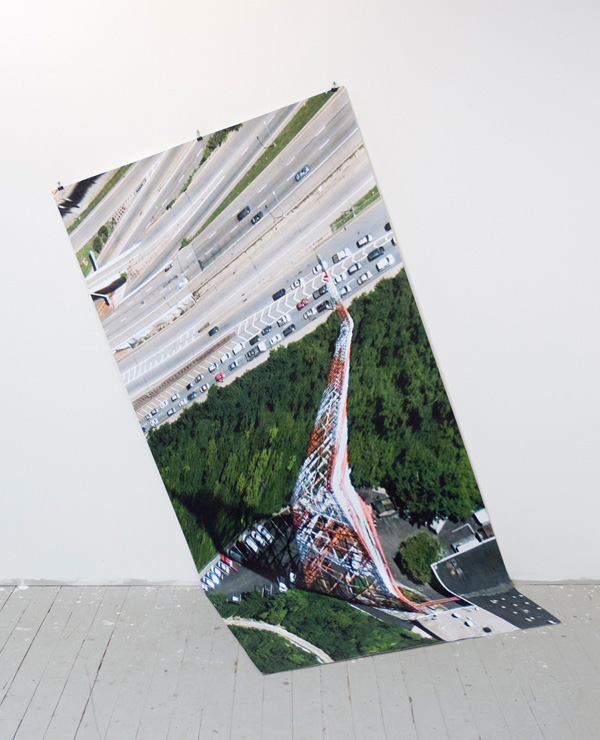
Images via Clement Valla.
These artists (...) counter the database, understood as a structure of dehumanized power, with the collection, as a form of idiosyncratic, unsystematic, and human memory. They collect what interests them, whatever they feel can and should be included in a meaning system. They describe, critique, and finally challenge the dynamics of the database, forcing it to evolve.1
I collect Google Earth images. I discovered them by accident, these particularly strange snapshots, where the illusion of a seamless and accurate representation of the Earth’s surface seems to break down. I was Google Earth-ing, when I noticed that a striking number of buildings looked like they were upside down. I could tell there were two competing visual inputs here —the 3D model that formed the surface of the earth, and the mapping of the aerial photography; they didn't match up. Depth cues in the aerial photographs, like shadows and lighting, were not aligning with the depth cues of the 3D model.
The competing visual inputs I had noticed produced some exceptional imagery, and I began to find more and start a collection. At first, I thought they were glitches, or errors in the algorithm, but looking closer, I realized the situation was actually more interesting — these images are not glitches. They are the absolute logical result of the system. They are an edge condition—an anomaly within the system, a nonstandard, an outlier, even, but not an error. These jarring moments expose how Google Earth works, focusing our attention on the software. They are seams which reveal a new model of seeing and of representing our world - as dynamic, ever-changing data from a myriad of different sources – endlessly combined, constantly updated, creating a seamless illusion.
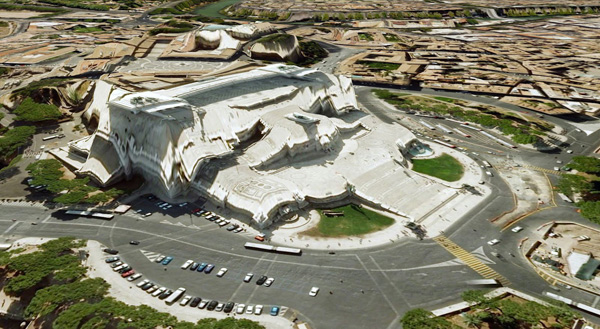 !--
!--
Contact sheet from Henri Cartier-Bresson in Seville, Spain, 1933. © Henri Cartier-Bresson / Magnum Photos-->
3D Images like those in Google Earth are generated through a process called texture mapping. Texture mapping is a technology developed by Ed Catmull in the 1970's. In 3D modeling, a texture map is a flat image that gets applied to the surface of a 3D model, like a label on a can or a bottle of soda. Textures typically represent a flat expanse with very little depth of field, meant to mimic surface properties of an object. Textures are more like a scan than a photograph. The surface represented in a texture coincides with the surface of the picture plane, unlike a photograph that represents a space beyond the picture plane. This difference might be summed up another way: we see through a photograph, we look at a texture. This is an important distinction in 3D modeling, because textures are stretched across the surface of a 3D model, in essence becoming the skin for the model.
Google Earth's textures however, are not shallow or flat. They are photographs that we look through into a space represented beyond—a space our brain interprets as having three dimensions and depth. We see space in the aerial photographs because of light and shadows and because of our prior knowledge of experienced space. When these photographs get distorted and stretched across the 3D topography of the earth, we are both looking at the distorted picture plane, and through the same picture plane at the space depicted in the texture. In other words, we are looking at two spaces simultaneously. Most of the time this doubling of spaces in Google Earth goes unnoticed, but sometimes the two spaces are so different, that things look strange, vertiginous, or plain wrong. But they’re not wrong. They reveal Google’s system used to map the earth — The Universal Texture.
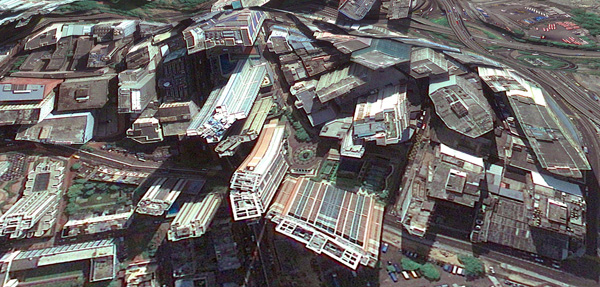 !--
!--
Contact sheet from Henri Cartier-Bresson in Seville, Spain, 1933. © Henri Cartier-Bresson / Magnum Photos-->
The Universal Texture is a Google patent for mapping textures onto a 3D model of the entire globe.2 At its core the Universal Texture is just an optimal way to generate a texture map of the earth. As its name implies, the Universal Texture promises a god-like (or drone-like) uninterrupted navigation of our planet — not a tiled series of discrete maps, but a flowing and fluid experience. This experience is so different, so much more seamless than previous technologies, that it is an achievement quite like what the escalator did to shopping:
No invention has had the importance for and impact on shopping as the escalator. As opposed to the elevator, which is limited in terms of the numbers it can transport between different floors and which through its very mechanism insists on division, the escalator accommodates and combines any flow, efficiently creates fluid transitions between one level and another, and even blurs the distinction between separate levels and individual spaces.3
In the digital media world, this fluid continuity is analogous to the infinite scroll's effect on Tumblr. In Google Earth, the Universal Texture delivers a smooth, complete and easily accessible knowledge of the planet's surface. The Universal Texture is able to take a giant photo collage made up of aerial photographs from all kinds of different sources — various companies, governments, mapping institutes — and map it onto a three-dimensional model assembled from as many distinct sources. It blends these disparate data together into a seamless space - like the escalator merges floors in a shopping mall.
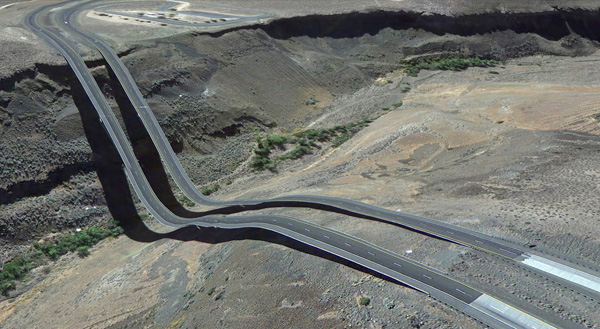 !--
!--
Contact sheet from Henri Cartier-Bresson in Seville, Spain, 1933. © Henri Cartier-Bresson / Magnum Photos-->
Our mechanical processes for creating images have habituated us into thinking in terms of snapshots - discrete segments of time and space (no matter how close together those discrete segments get, we still count in frames per second and image aspect ratios). But Google is thinking in continuity. The images produced by Google Earth are quite unlike a photograph that bears an indexical relationship to a given space at a given time. Rather, they are hybrid images, a patchwork of two-dimensional photographic data and three-dimensional topographic data extracted from a slew of sources, data-mined, pre-processed, blended and merged in real-time. Google Earth is essentially a database disguised as a photographic representation.
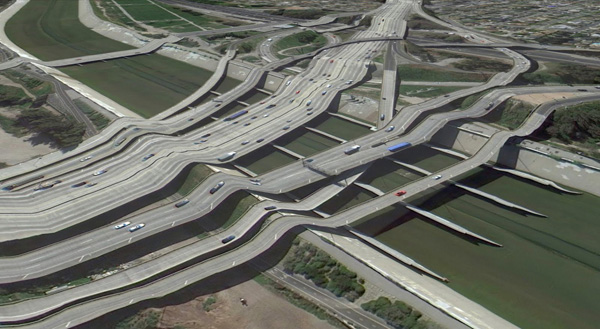 !--
!--
Contact sheet from Henri Cartier-Bresson in Seville, Spain, 1933. © Henri Cartier-Bresson / Magnum Photos-->
It is an automated, statistical, incessant, universal representation that selectively chooses its data. (For one, there is no ‘night’ in Google’s version of Earth.) The system edits a particular representation of the world. The software edits, re-assembles, processes and packages reality in order to form a very specific and useful model. These collected images feel alien, because they are clearly an incorrect representation of the earth’s surface. And it is precisely because humans did not directly create these images that they are so fascinating. They are created by an algorithm that finds nothing wrong in these moments. They are less a creation, than a kind of fact - a representation of the laws of the Universal Texture. As a collection the anomalies are a weird natural history of Google Earth’s software. They are strange new typologies, representative of a particular digital process. Typically, the illusion the Universal Texture creates makes the process itself go unnoticed, but these anomalies offer a glimpse into the data collection and assembly. They bring the diverging data sources to light. In these anomalies we understand there are competing inputs, competing data sources and discrepancy in the data. The world is not so fluid after all.
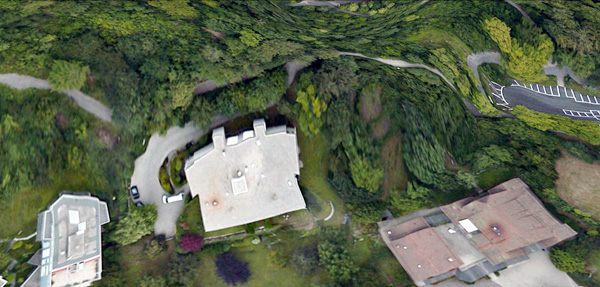 !--
!--
Contact sheet from Henri Cartier-Bresson in Seville, Spain, 1933. © Henri Cartier-Bresson / Magnum Photos-->
By capturing screenshots of these images in Google Earth, I am pausing them and pulling them out of the update cycle. I capture these images to archive them - to make sure there is a record that this image was produced by the Universal Texture at a particular time and place. As I kept looking for more anomalies, and revisiting anomalies I had already discovered, I noticed the images I had discovered were disappearing. The aerial photographs were getting updated, becoming 'flatter' – from being taken at less of an angle or having the shadows below bridges muted. Because Google Earth is constantly updating its algorithms and three-dimensional data, each specific moment could only be captured as a still image. I know Google is trying to fix some of these anomalies too – I’ve been contacted by a Google engineer who has come up with a clever fix for the problem of drooping roads and bridges. Though the change has yet to appear in the software, it’s only a matter of time.
Taking a closer look, Google’s algorithms also seem to have a way to select certain types of aerial photographs over others, so as more photographs are taken, the better ones get selected. To Google, better photographs are flatter, have fewer shadows and are taken from higher angles. Because of this progress, these strange images are being erased. I see part of my work as archiving these temporal digital typologies. I also call these images postcards to cast myself as a tourist in the temporal and virtual space - a space that exists digitally for a moment, and may perhaps never be reconstituted again by any computer.
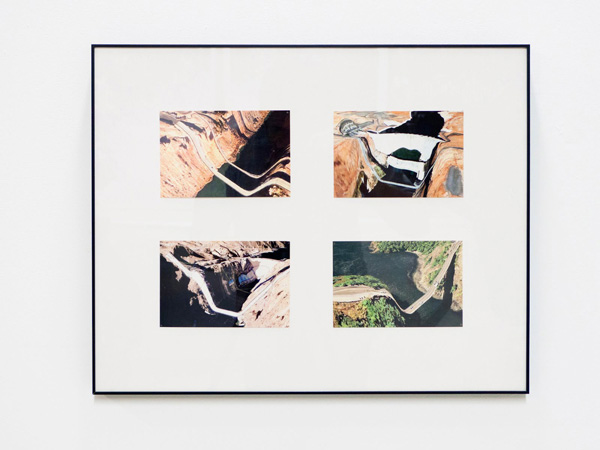 !--
!--
Contact sheet from Henri Cartier-Bresson in Seville, Spain, 1933. © Henri Cartier-Bresson / Magnum Photos-->
Nothing draws more attention to the temporality of these images than the simple observation that the clouds are disappearing from Google Earth. After all, clouds obscures the surface of the planet so photos with no clouds are privileged. The Universal Texture and its attendant database algorithms are trained on a few basic qualitative traits - no clouds, high contrast, shallow depth, daylight photos. Progress in architecture has given us total control over interior environments; climate controlled spaces smoothly connected by escalators in shopping malls, airports, hotels and casinos. Progress in the Universal Texture promises to give us a smooth and continuous 24-hour, cloudless, daylit world, increasingly free of jarring anomalies, outliers and statistical inconsistency.
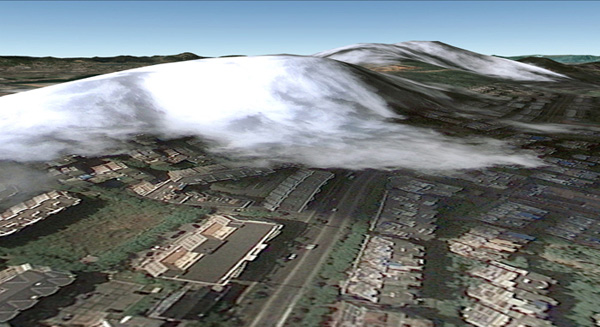 !--
!--
Contact sheet from Henri Cartier-Bresson in Seville, Spain, 1933. © Henri Cartier-Bresson / Magnum Photos-->
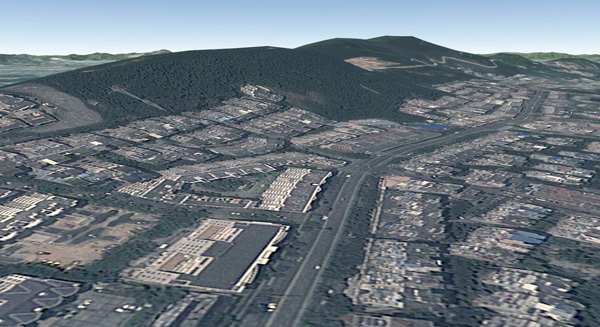 !--
!--
Contact sheet from Henri Cartier-Bresson in Seville, Spain, 1933. © Henri Cartier-Bresson / Magnum Photos-->
1. Quaranta, Domenico, “Collect the WWWorld. The Artist as Archivist in the Internet Age,” in Domenico Quaranta et al., Collect the WWWorld, exhibition catalogue, LINK Editions, September 2011.
2. "WebGL Earth Documentation - 2 Real-time Texturing Methods," WebGL Earth Documentation - 2 Real-time Texturing Methods, N.p., n.d. Web. 30 July 2012.
3. Jovanovic Weiss, Srdjan and Leong, Sze Tsung, “Escalator,” in Koolhaas et al., Harvard Design School guide to shopping, Köln, New York, Taschen, 2001.
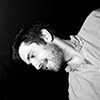 Clement Valla (USA, 1979). Lives and works in Brooklyn, New York. He received a BA in Architecture from Columbia University and a MFA from the Rhode Island School of Design in Digital+Media. He is currently an associate professor of Graphic Design at RISD. His work has been exhibited in several internationally places as The Indianapolis Museum of Art, Indianapolis; Museum of the Moving Image, New York; Thommassen Galleri, Gothenbur, etc. His work is available at clementvalla.com
Clement Valla (USA, 1979). Lives and works in Brooklyn, New York. He received a BA in Architecture from Columbia University and a MFA from the Rhode Island School of Design in Digital+Media. He is currently an associate professor of Graphic Design at RISD. His work has been exhibited in several internationally places as The Indianapolis Museum of Art, Indianapolis; Museum of the Moving Image, New York; Thommassen Galleri, Gothenbur, etc. His work is available at clementvalla.com[core_state] => 1 [core_access] => 1 [core_metadata] => {"robots":"","author":"Clement Valla","rights":"","xreference":""} [core_created_user_id] => 838 [core_created_by_alias] => [core_created_time] => 2014-06-23 17:00:00 [core_images] => {"image_intro":"images\/categories\/zonezero-3\/articles.clementvalla.valla.jpg","float_intro":"","image_intro_alt":"","image_intro_caption":"","image_fulltext":"images\/categories\/zonezero-3\/articles.clementvalla.valla.jpg","float_fulltext":"","image_fulltext_alt":"","image_fulltext_caption":""} [core_modified_time] => 2015-04-22 20:01:16 [core_language] => en-GB [core_catid] => 42 [core_publish_up] => 2014-06-23 17:00:00 [core_publish_down] => 0000-00-00 00:00:00 [content_type_title] => Article [router] => ContentHelperRoute::getArticleRoute [author] => Elisa Rugo [author_email] => elisa@zonezero.com [link] => index.php?option=com_content&view=article&id=169:the-universal-texture&catid=42&lang=en-GB [displayDate] => 2014-06-23 17:00:00 [event] => stdClass Object ( [afterDisplayTitle] => [beforeDisplayContent] => [afterDisplayContent] => ) [text] =>
!-- Parrafo de eric kim
Eric Kim, "Debunking the “Myth of the Decisive Moment”", Eric Kim Street Photography Blog , May 23, 2014
-->Clement Valla, "The Universal Texture.", Rhizome, 2012.

Images via Clement Valla.
These artists (...) counter the database, understood as a structure of dehumanized power, with the collection, as a form of idiosyncratic, unsystematic, and human memory. They collect what interests them, whatever they feel can and should be included in a meaning system. They describe, critique, and finally challenge the dynamics of the database, forcing it to evolve.1
I collect Google Earth images. I discovered them by accident, these particularly strange snapshots, where the illusion of a seamless and accurate representation of the Earth’s surface seems to break down. I was Google Earth-ing, when I noticed that a striking number of buildings looked like they were upside down. I could tell there were two competing visual inputs here —the 3D model that formed the surface of the earth, and the mapping of the aerial photography; they didn't match up. Depth cues in the aerial photographs, like shadows and lighting, were not aligning with the depth cues of the 3D model.
The competing visual inputs I had noticed produced some exceptional imagery, and I began to find more and start a collection. At first, I thought they were glitches, or errors in the algorithm, but looking closer, I realized the situation was actually more interesting — these images are not glitches. They are the absolute logical result of the system. They are an edge condition—an anomaly within the system, a nonstandard, an outlier, even, but not an error. These jarring moments expose how Google Earth works, focusing our attention on the software. They are seams which reveal a new model of seeing and of representing our world - as dynamic, ever-changing data from a myriad of different sources – endlessly combined, constantly updated, creating a seamless illusion.
 !--
!--
Contact sheet from Henri Cartier-Bresson in Seville, Spain, 1933. © Henri Cartier-Bresson / Magnum Photos-->
3D Images like those in Google Earth are generated through a process called texture mapping. Texture mapping is a technology developed by Ed Catmull in the 1970's. In 3D modeling, a texture map is a flat image that gets applied to the surface of a 3D model, like a label on a can or a bottle of soda. Textures typically represent a flat expanse with very little depth of field, meant to mimic surface properties of an object. Textures are more like a scan than a photograph. The surface represented in a texture coincides with the surface of the picture plane, unlike a photograph that represents a space beyond the picture plane. This difference might be summed up another way: we see through a photograph, we look at a texture. This is an important distinction in 3D modeling, because textures are stretched across the surface of a 3D model, in essence becoming the skin for the model.
Google Earth's textures however, are not shallow or flat. They are photographs that we look through into a space represented beyond—a space our brain interprets as having three dimensions and depth. We see space in the aerial photographs because of light and shadows and because of our prior knowledge of experienced space. When these photographs get distorted and stretched across the 3D topography of the earth, we are both looking at the distorted picture plane, and through the same picture plane at the space depicted in the texture. In other words, we are looking at two spaces simultaneously. Most of the time this doubling of spaces in Google Earth goes unnoticed, but sometimes the two spaces are so different, that things look strange, vertiginous, or plain wrong. But they’re not wrong. They reveal Google’s system used to map the earth — The Universal Texture.
 !--
!--
Contact sheet from Henri Cartier-Bresson in Seville, Spain, 1933. © Henri Cartier-Bresson / Magnum Photos-->
The Universal Texture is a Google patent for mapping textures onto a 3D model of the entire globe.2 At its core the Universal Texture is just an optimal way to generate a texture map of the earth. As its name implies, the Universal Texture promises a god-like (or drone-like) uninterrupted navigation of our planet — not a tiled series of discrete maps, but a flowing and fluid experience. This experience is so different, so much more seamless than previous technologies, that it is an achievement quite like what the escalator did to shopping:
No invention has had the importance for and impact on shopping as the escalator. As opposed to the elevator, which is limited in terms of the numbers it can transport between different floors and which through its very mechanism insists on division, the escalator accommodates and combines any flow, efficiently creates fluid transitions between one level and another, and even blurs the distinction between separate levels and individual spaces.3
In the digital media world, this fluid continuity is analogous to the infinite scroll's effect on Tumblr. In Google Earth, the Universal Texture delivers a smooth, complete and easily accessible knowledge of the planet's surface. The Universal Texture is able to take a giant photo collage made up of aerial photographs from all kinds of different sources — various companies, governments, mapping institutes — and map it onto a three-dimensional model assembled from as many distinct sources. It blends these disparate data together into a seamless space - like the escalator merges floors in a shopping mall.
 !--
!--
Contact sheet from Henri Cartier-Bresson in Seville, Spain, 1933. © Henri Cartier-Bresson / Magnum Photos-->
Our mechanical processes for creating images have habituated us into thinking in terms of snapshots - discrete segments of time and space (no matter how close together those discrete segments get, we still count in frames per second and image aspect ratios). But Google is thinking in continuity. The images produced by Google Earth are quite unlike a photograph that bears an indexical relationship to a given space at a given time. Rather, they are hybrid images, a patchwork of two-dimensional photographic data and three-dimensional topographic data extracted from a slew of sources, data-mined, pre-processed, blended and merged in real-time. Google Earth is essentially a database disguised as a photographic representation.
 !--
!--
Contact sheet from Henri Cartier-Bresson in Seville, Spain, 1933. © Henri Cartier-Bresson / Magnum Photos-->
It is an automated, statistical, incessant, universal representation that selectively chooses its data. (For one, there is no ‘night’ in Google’s version of Earth.) The system edits a particular representation of the world. The software edits, re-assembles, processes and packages reality in order to form a very specific and useful model. These collected images feel alien, because they are clearly an incorrect representation of the earth’s surface. And it is precisely because humans did not directly create these images that they are so fascinating. They are created by an algorithm that finds nothing wrong in these moments. They are less a creation, than a kind of fact - a representation of the laws of the Universal Texture. As a collection the anomalies are a weird natural history of Google Earth’s software. They are strange new typologies, representative of a particular digital process. Typically, the illusion the Universal Texture creates makes the process itself go unnoticed, but these anomalies offer a glimpse into the data collection and assembly. They bring the diverging data sources to light. In these anomalies we understand there are competing inputs, competing data sources and discrepancy in the data. The world is not so fluid after all.
 !--
!--
Contact sheet from Henri Cartier-Bresson in Seville, Spain, 1933. © Henri Cartier-Bresson / Magnum Photos-->
By capturing screenshots of these images in Google Earth, I am pausing them and pulling them out of the update cycle. I capture these images to archive them - to make sure there is a record that this image was produced by the Universal Texture at a particular time and place. As I kept looking for more anomalies, and revisiting anomalies I had already discovered, I noticed the images I had discovered were disappearing. The aerial photographs were getting updated, becoming 'flatter' – from being taken at less of an angle or having the shadows below bridges muted. Because Google Earth is constantly updating its algorithms and three-dimensional data, each specific moment could only be captured as a still image. I know Google is trying to fix some of these anomalies too – I’ve been contacted by a Google engineer who has come up with a clever fix for the problem of drooping roads and bridges. Though the change has yet to appear in the software, it’s only a matter of time.
Taking a closer look, Google’s algorithms also seem to have a way to select certain types of aerial photographs over others, so as more photographs are taken, the better ones get selected. To Google, better photographs are flatter, have fewer shadows and are taken from higher angles. Because of this progress, these strange images are being erased. I see part of my work as archiving these temporal digital typologies. I also call these images postcards to cast myself as a tourist in the temporal and virtual space - a space that exists digitally for a moment, and may perhaps never be reconstituted again by any computer.
 !--
!--
Contact sheet from Henri Cartier-Bresson in Seville, Spain, 1933. © Henri Cartier-Bresson / Magnum Photos-->
Nothing draws more attention to the temporality of these images than the simple observation that the clouds are disappearing from Google Earth. After all, clouds obscures the surface of the planet so photos with no clouds are privileged. The Universal Texture and its attendant database algorithms are trained on a few basic qualitative traits - no clouds, high contrast, shallow depth, daylight photos. Progress in architecture has given us total control over interior environments; climate controlled spaces smoothly connected by escalators in shopping malls, airports, hotels and casinos. Progress in the Universal Texture promises to give us a smooth and continuous 24-hour, cloudless, daylit world, increasingly free of jarring anomalies, outliers and statistical inconsistency.
 !--
!--
Contact sheet from Henri Cartier-Bresson in Seville, Spain, 1933. © Henri Cartier-Bresson / Magnum Photos-->
 !--
!--
Contact sheet from Henri Cartier-Bresson in Seville, Spain, 1933. © Henri Cartier-Bresson / Magnum Photos-->
1. Quaranta, Domenico, “Collect the WWWorld. The Artist as Archivist in the Internet Age,” in Domenico Quaranta et al., Collect the WWWorld, exhibition catalogue, LINK Editions, September 2011.
2. "WebGL Earth Documentation - 2 Real-time Texturing Methods," WebGL Earth Documentation - 2 Real-time Texturing Methods, N.p., n.d. Web. 30 July 2012.
3. Jovanovic Weiss, Srdjan and Leong, Sze Tsung, “Escalator,” in Koolhaas et al., Harvard Design School guide to shopping, Köln, New York, Taschen, 2001.
 Clement Valla (USA, 1979). Lives and works in Brooklyn, New York. He received a BA in Architecture from Columbia University and a MFA from the Rhode Island School of Design in Digital+Media. He is currently an associate professor of Graphic Design at RISD. His work has been exhibited in several internationally places as The Indianapolis Museum of Art, Indianapolis; Museum of the Moving Image, New York; Thommassen Galleri, Gothenbur, etc. His work is available at clementvalla.com
Clement Valla (USA, 1979). Lives and works in Brooklyn, New York. He received a BA in Architecture from Columbia University and a MFA from the Rhode Island School of Design in Digital+Media. He is currently an associate professor of Graphic Design at RISD. His work has been exhibited in several internationally places as The Indianapolis Museum of Art, Indianapolis; Museum of the Moving Image, New York; Thommassen Galleri, Gothenbur, etc. His work is available at clementvalla.com[id] => 169 [language] => en-GB [catid] => 42 [jcfields] => Array ( ) ) 1
Melissa Valenzuela y Ehekatl Hernández
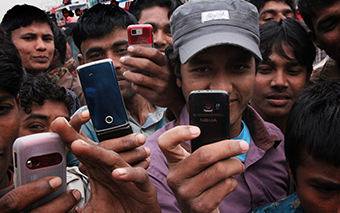
Photography has modified not only its devices for recording images but also its range of subjects and of course its means of dissemination. Traditional media such as paper and books were taken over a long time ago by their digital counterparts, which enable thousands of images to be shared on the Internet and mobile devices every day. As time went by and technology evolved, graphic formats emerged with a distinct advantage in terms of image quality, the use of animations and the layer of interaction. Many of these, such as Flash technology, were at first innovative and widely used, but rapidly replaced.
In this context, one of the formats that has existed alongside the Web since its inception, and remains popular, is GIF (Graphic Interchange Format), a form of technology developed in 1987 by the company CompuServe. Long before screen and monitor resolution brought viewers thousands or even millions of colors with sophisticated compression algorithms, such as JPGs or PNGs, the GIF already enabled graphics of a maximum of 256 colors to be inserted. A few years later, an improvement allowed more than one graph to be incorporated sequentially, and for the first time modest animations could be created on the emerging Web, with low weight and rapid display without extra plug-in. And so the ANIMATED GIF was born.
Other formats have gradually fallen into disuse because of incompatibility with new devices, their high processing requirements for proper display and visualization, or their reliance on complex tools to add animation and interactivity. Meanwhile, the GIF has continued to function, thanks to its flexibility and compatibility with many different systems, browsers and even mobile devices. As a result, it has been widely used recently, and is no longer limited to publicists and marketers.
In this context, and as part of the current trend towards immediacy, GIF has established itself as an interesting tool for visual expression and experimentation, because of its particular technical, communicative and expressive qualities. Indeed, ANIMATED GIFs enable users to create authentic moving photographs that record short, repetitive actions. Reproduction in a loop (infinite repetition) emphasizes the idea of the redundancy of the moment, and consequently the instant grows, completes the action and highlights it. Time is no longer suspended for eternity, but is now redundant. This is the case of the so-called “Cinemagraph”, a variation of the animated GIF in which movement is restricted to an area or specific element of the shot. GIFs do not attempt to freeze the instant and instead insist on it, expressing itself time and time again in the image.
This narrows the gap between photography, cinema and video. These frames in movement allude to the first cinematographic films by the Lumière brothers, which captured instants of an action and reproduced the sequence to emulate movement. Unlike that era, viewers are currently not only accustomed to images but oversaturated with them. Observation is no longer guided by surprise, but by identification with an instant that is indefinitely prolonged.
In contrast with the visual quality of cinema and photography, ANIMATED GIFs remind us of the texture of the first video cameras, a pastel-colored, poor quality image lacking depth. Cinema and photography maintain a certain expressive and visual independence from video and GIF. Those media refer to different concepts, as they have varied methods of dissemination and a different form of interaction with the viewer. They establish a relationship with an active spectator who repeatedly gives meaning to the image, reconstructing and reinterpreting in accordance with various factors that range from perception and the relation of each person to time, to external factors such as interface and the device supporting the image.
And yet, the contents manipulated by GIFs often draw on images extracted specifically from photographs, films or videos, and treated to emphasize a concrete action or some elements in movement. GIF narratives are ephemeral but reiterative, describing the instant and action, delving into content and the capacity for seduction and transmitting ideas and feelings. Indeed, action in movement is always the backbone of a visual construction charged with meanings.
Not surprisingly, this digital format is currently being explored by visual artists and photographers, to produce images in movement as an alternative to the formulas of cinema, video or animation shots. Though it may seem complex to understand the spectrum in which the ANIMATED GIF exists, the format has transformed its limited scope in the use of time into its greatest asset, with extensive expressive and conceptual possibilities. It also provides guidelines to redefine the notions and concepts, even at a theoretical level, involved in the constant evolution of photography, which will certainly not be the same in years to come.
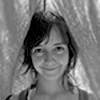 Melissa Valenzuela (Colombia, 1982). Lives and works in Mexico City. She holds a Masters’ Degree in Visual Arts from the Escuela Nacional de Artes Pláticas at the Universidad Nacional Autónoma de México (UNAM), and studied Audiovisual Communication at the Pontificia Universidad Javeriana de Bogotá. Valenzuela is an artist, and her work consists of self-portraits and recollections that address various nuances of perception, representation and memory. She also works in curatorship and education to integrate her artistic and research work..
Melissa Valenzuela (Colombia, 1982). Lives and works in Mexico City. She holds a Masters’ Degree in Visual Arts from the Escuela Nacional de Artes Pláticas at the Universidad Nacional Autónoma de México (UNAM), and studied Audiovisual Communication at the Pontificia Universidad Javeriana de Bogotá. Valenzuela is an artist, and her work consists of self-portraits and recollections that address various nuances of perception, representation and memory. She also works in curatorship and education to integrate her artistic and research work..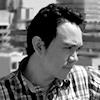 Ehekatl Hernández (México, 1975).received a Bachelor’s Degree in Graphic Design from the Escuela Nacional de Artes Plásticas at UNAM in Mexico, and a Master’s Degree in Multimedia Applications from the Universidad Poltécnica de Catalunya in Spain. He has over 15 years’ experience in graphic design and planning, developing and implementing web projects. Hernández has given diploma courses in web design at UNAM. He has spent nine years contributing to the web design and multimedia area at zonezero.com, and also works as a consultant for various companies as well as coordinating the e-learning system of the Virtual Campus of the Pedro Meyer Foundation.
Ehekatl Hernández (México, 1975).received a Bachelor’s Degree in Graphic Design from the Escuela Nacional de Artes Plásticas at UNAM in Mexico, and a Master’s Degree in Multimedia Applications from the Universidad Poltécnica de Catalunya in Spain. He has over 15 years’ experience in graphic design and planning, developing and implementing web projects. Hernández has given diploma courses in web design at UNAM. He has spent nine years contributing to the web design and multimedia area at zonezero.com, and also works as a consultant for various companies as well as coordinating the e-learning system of the Virtual Campus of the Pedro Meyer Foundation.
Photography has modified not only its devices for recording images but also its range of subjects and of course its means of dissemination. Traditional media such as paper and books were taken over a long time ago by their digital counterparts, which enable thousands of images to be shared on the Internet and mobile devices every day. As time went by and technology evolved, graphic formats emerged with a distinct advantage in terms of image quality, the use of animations and the layer of interaction. Many of these, such as Flash technology, were at first innovative and widely used, but rapidly replaced.
In this context, one of the formats that has existed alongside the Web since its inception, and remains popular, is GIF (Graphic Interchange Format), a form of technology developed in 1987 by the company CompuServe. Long before screen and monitor resolution brought viewers thousands or even millions of colors with sophisticated compression algorithms, such as JPGs or PNGs, the GIF already enabled graphics of a maximum of 256 colors to be inserted. A few years later, an improvement allowed more than one graph to be incorporated sequentially, and for the first time modest animations could be created on the emerging Web, with low weight and rapid display without extra plug-in. And so the ANIMATED GIF was born.
Other formats have gradually fallen into disuse because of incompatibility with new devices, their high processing requirements for proper display and visualization, or their reliance on complex tools to add animation and interactivity. Meanwhile, the GIF has continued to function, thanks to its flexibility and compatibility with many different systems, browsers and even mobile devices. As a result, it has been widely used recently, and is no longer limited to publicists and marketers.
In this context, and as part of the current trend towards immediacy, GIF has established itself as an interesting tool for visual expression and experimentation, because of its particular technical, communicative and expressive qualities. Indeed, ANIMATED GIFs enable users to create authentic moving photographs that record short, repetitive actions. Reproduction in a loop (infinite repetition) emphasizes the idea of the redundancy of the moment, and consequently the instant grows, completes the action and highlights it. Time is no longer suspended for eternity, but is now redundant. This is the case of the so-called “Cinemagraph”, a variation of the animated GIF in which movement is restricted to an area or specific element of the shot. GIFs do not attempt to freeze the instant and instead insist on it, expressing itself time and time again in the image.
This narrows the gap between photography, cinema and video. These frames in movement allude to the first cinematographic films by the Lumière brothers, which captured instants of an action and reproduced the sequence to emulate movement. Unlike that era, viewers are currently not only accustomed to images but oversaturated with them. Observation is no longer guided by surprise, but by identification with an instant that is indefinitely prolonged.
In contrast with the visual quality of cinema and photography, ANIMATED GIFs remind us of the texture of the first video cameras, a pastel-colored, poor quality image lacking depth. Cinema and photography maintain a certain expressive and visual independence from video and GIF. Those media refer to different concepts, as they have varied methods of dissemination and a different form of interaction with the viewer. They establish a relationship with an active spectator who repeatedly gives meaning to the image, reconstructing and reinterpreting in accordance with various factors that range from perception and the relation of each person to time, to external factors such as interface and the device supporting the image.
And yet, the contents manipulated by GIFs often draw on images extracted specifically from photographs, films or videos, and treated to emphasize a concrete action or some elements in movement. GIF narratives are ephemeral but reiterative, describing the instant and action, delving into content and the capacity for seduction and transmitting ideas and feelings. Indeed, action in movement is always the backbone of a visual construction charged with meanings.
Not surprisingly, this digital format is currently being explored by visual artists and photographers, to produce images in movement as an alternative to the formulas of cinema, video or animation shots. Though it may seem complex to understand the spectrum in which the ANIMATED GIF exists, the format has transformed its limited scope in the use of time into its greatest asset, with extensive expressive and conceptual possibilities. It also provides guidelines to redefine the notions and concepts, even at a theoretical level, involved in the constant evolution of photography, which will certainly not be the same in years to come.
 Melissa Valenzuela (Colombia, 1982). Lives and works in Mexico City. She holds a Masters’ Degree in Visual Arts from the Escuela Nacional de Artes Pláticas at the Universidad Nacional Autónoma de México (UNAM), and studied Audiovisual Communication at the Pontificia Universidad Javeriana de Bogotá. Valenzuela is an artist, and her work consists of self-portraits and recollections that address various nuances of perception, representation and memory. She also works in curatorship and education to integrate her artistic and research work..
Melissa Valenzuela (Colombia, 1982). Lives and works in Mexico City. She holds a Masters’ Degree in Visual Arts from the Escuela Nacional de Artes Pláticas at the Universidad Nacional Autónoma de México (UNAM), and studied Audiovisual Communication at the Pontificia Universidad Javeriana de Bogotá. Valenzuela is an artist, and her work consists of self-portraits and recollections that address various nuances of perception, representation and memory. She also works in curatorship and education to integrate her artistic and research work.. Ehekatl Hernández (México, 1975).received a Bachelor’s Degree in Graphic Design from the Escuela Nacional de Artes Plásticas at UNAM in Mexico, and a Master’s Degree in Multimedia Applications from the Universidad Poltécnica de Catalunya in Spain. He has over 15 years’ experience in graphic design and planning, developing and implementing web projects. Hernández has given diploma courses in web design at UNAM. He has spent nine years contributing to the web design and multimedia area at zonezero.com, and also works as a consultant for various companies as well as coordinating the e-learning system of the Virtual Campus of the Pedro Meyer Foundation.
Ehekatl Hernández (México, 1975).received a Bachelor’s Degree in Graphic Design from the Escuela Nacional de Artes Plásticas at UNAM in Mexico, and a Master’s Degree in Multimedia Applications from the Universidad Poltécnica de Catalunya in Spain. He has over 15 years’ experience in graphic design and planning, developing and implementing web projects. Hernández has given diploma courses in web design at UNAM. He has spent nine years contributing to the web design and multimedia area at zonezero.com, and also works as a consultant for various companies as well as coordinating the e-learning system of the Virtual Campus of the Pedro Meyer Foundation.André Gunthert
André Gunthert, "Conversational image: new uses of digital photography.", Etudes photographiques, n° 31, printemps 2014.
Nowadays we dislike the overwhelming amount of images, for we link this proliferation to the progress of reproducibility. But is the technical predictability the only parameter for this growth? This could be explained more satisfactorily in terms of more uses for photographs. In any case, this is what is suggested by the observation of connected uses.
The first period of the static websites was characterized as a "society of authors 14 ". In contrast, the abilities of symmetric interaction promoted by the Web 2.0 have lead to users describing the activity of on-line publications as a conversation 15 . Studied in detail by Pragmatics or Ethnomethodology, the oral exchange structured by the order of speaking is considered as one of the foundations of sociability. "That is where the child learns to speak, where the stranger socializes by entering a new group (...), where the social relationship is built, where the system of the language is formed and transformed 16 ."
The ordered, symmetrical, open, and cumulative interaction that characterizes instant messaging or on-line exchanges is similar to the egalitarian sociability of conversation. As Jean-Samuel Beuscart, Dominique Cardon, Nicolas Pissard and Christophe Prieur note in their study on Flickr, the integration of the image in this economy represents a remarkable evolution of these features 17 . Rather than having conversations about pictures, they say, the Web has favored having conversations using pictures.
However, the ability of using an image as a message wasn't born with digital devices. For example, this attribute is also offered by an illustrated postcard, which has seen a marked development since the end of the 10th century. If we agree to add the correspondence as a conversational genre, the association of the image allows us to see a primitive state of this creation, following a much slower rhythm. Even if the industrial production requires us to turn to standard ways or situations, the usefulness of postcards provide precious examples of the archeology of the visual conversation.
In its digital version, it appears at the core of e-mail and on-line forums, and then in multimedia messaging services, or MMS, that appeared with the first camera phones. The Sharp J-SH04, released in Japan in October 2000 at a cost of $500, works with the J-Phone network, which allows sharing pictures among users.
In the middle of the 2000's an intermediate stage was born with "monoblogging", where sharing pictures taken with a camera phone in a blog was the predecessor of the instant publication in social networks. Therefore, if there are two different uses for the connected image, taking one from the private conversation, and the other one from the public or semi-public conversation, it is equally important to notice the permeability between the different spaces, which is encouraged by the digital fluidity.

Fig. 3. Album of purikura, Tokyo, 2003(courtesy of Claude Estebe).
Recently baptized as "selfie", a form of contextual self-photograph, this type of picture is possibly the oldest identifiable practice of the connected image. The birth of camera phones in Japan is placed in the wake of the phenomenon, purikura 18, that can be attached multiple decorations with the goal of becoming collectible items (see fig. 3). The first camera phone model by Sharp has a small mirror in front, an original scheme to make taking self-portraits easier. The promotional images from that time leave no room for questions: the camera was conceived by the manufacturer to allow users to take pictures of them at an arm's length by using a lens of short focal length.
If these features were only imagined as a gadget, it is a more dramatic way to manifest the transformation of the uses provided by connected images. On July 7th, 2005, between 8:50 and 9:47am, four bombs transported by terrorists blew up three subway stations and a bus in London, resulting in 56 dead and 700 injured. While the media was not able to enter the subway, Sky News broadcasted at 12:35pm an image taken very near the attack: it was a picture taken at 9:25am with a camera phone of user Adam Stacey in the corridor connecting to King's Cross, and sent as an electronic message to many recipients (see fig.4).
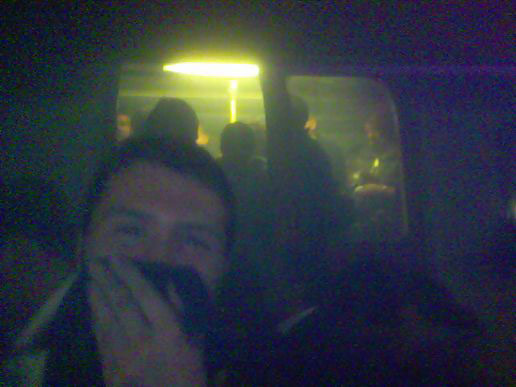
Fig. 4. Photograph of Adam Stacey by Kevin Ward, London subway, July 07, 2005 (CC licence).
Although this image shows a face, it is by no means a portrait in the sense granted by pictorial tradition. And, even if the circumstances caused its public diffusion 19 , its initial share belonged to a private conversation. Due to the immediacy of its communication, the photo of Adam Stacey, taken on his demand by a friend who was with him in order to keep his next of kin informed, has, first of all, a useful function as a way of relaying quickly a fact.
If the documentary vocation is an integral part of the history of visual recording, this generally concerns specialized uses, such as scientific, media or industrial. In terms of personal photography, the use of the image continues being essentially symbolic: the preservation of memories or the writing of family history.
There are examples of practical uses, such as the documentation of an assessment of loss for an insurance company, that have been observed since the beginning of the 20th century. But they continue to be discreet, they don't matter to the observers and they aren't described in any history or sociology texts on amateur photography.
However, by making images available faster, some technical innovations such as the instant development proposed by Polaroid have competed to improve the practical use of pictures, and have made room for a wide range of recording uses. This also holds true for the instant transmission of the connected image, which gives photography access to the universe of communication. We can see a significant example of these current applications in the selfie of co-founders of Flickr, Stewart Butterfield and Caterina Fake, from October 2005. Titled " Hi Mom ", the picture published on Flickr has an accompanying explanation: "Sent to my parents while I spoke to them on the telephone so they could share the view of the environment where we were" ( see fig.5 ).
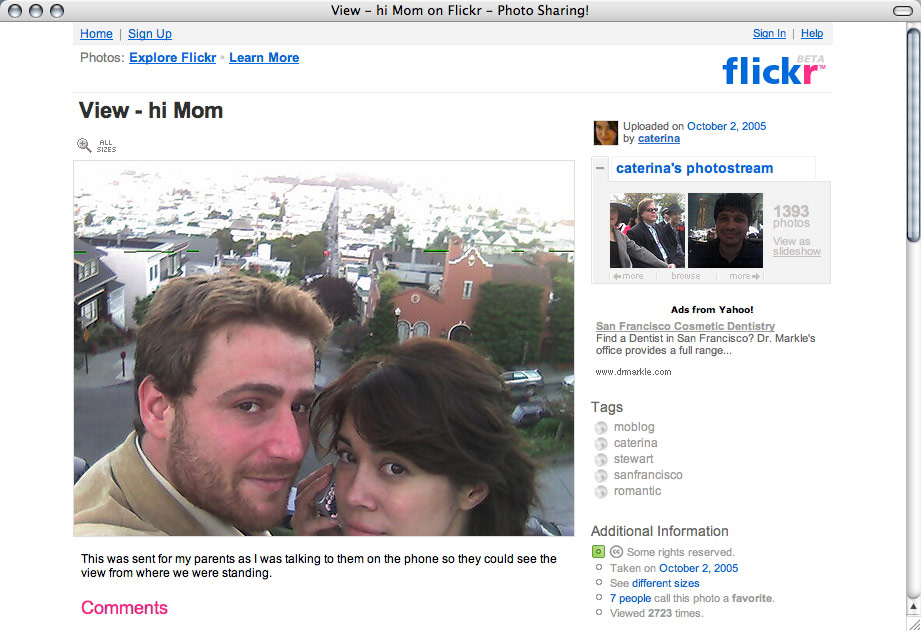
Fig. 5. " Hi Mom", selfie of Stewart Butterfield and Caterina Fake, co-founders of Flickr, October 2005 (CC licence).
The available studies on new communicative practices witness an unprecedented extension of the utilitarian applications 20 . By associating the visual dimension with shared data, the image allows to supply information about a situation (an arrival to or presence in a place, the use of a mean of transportation...), a check of appearance (an outfit test, the result of a haircut, physical aspect...), but also countless practical information, such as the purchase of a product, the composition of a dish, the state of a building, etc. Photography allows us to record all of this or transmit it faster than a written message 21 . The connected image lends itself particularly to the regular exchange of signals destined to maintain an effective, friendly or romantic relationship. It can also serve for political or military goals, such as the pictures of gatherings during the Arab Spring, immediately distributed to get people to join the demonstrations 22 .
The extreme variety of these applications shows a fast adaptation to connected tools, as well as the development of a new skill: the ability to translate a situation visually, a way to be able to offer a summary, often personal or playful, a way to reinterpret reality that reminds us of "The Practice of Everyday Life" by Michel de Certeau 23 .
14 Bernard Stiegler, " Situations technologiques de l’autorité cognitive à l’ère de la désorientation ", the conferences of the seminar " Technologies Cognitives et Environnements de Travail ", May 12th, 1998, ( quoted in Valérie Beaudouin, De la publication à la conversation . Lecture et écriture électroniques , Réseaux n° 116, 2002, p. 225).
15 Valérie Beaudouin, "De la publication à la conversation. Lecture et écriture électroniques", Réseaux , n° 116, 2002, p. 199-225.
16 Lorenza Mondada, "La question du contexte en ethnométhodologie et en analyse conversationnelle", Verbum , 28-2/3, 2006 [2008] (I thank Jonathan Larcher for his invaluable indications).
17 Jean-Samuel Beuscart, Dominique Cardon, Nicolas Pissard and Christophe Prieur, "Pourquoi partager mes photos de vacances avec des inconnus? Les usages de Flickr", Réseaux , n° 154/2, 2009, p. 91-129.
18 Jon Wurtzel, "Taking pictures with your phone", 18 September 2001, BBC News ( http://news.bbc.co.uk/2/hi/science/nature/1550622.stm). Developed by Altus and Sega, the first purikura cabins appeared in Tokyo in 1995.
19 André Gunthert, "Tous journalistes ? Les attentats de Londres ou l'intrusion des amateurs", in Gianni Haver (dir.), Press photo. Usages et pratiques , Lausanne, éd. Antipodes, 2009, p. 215- 225 (on line : http://www.arhv.lhivic.org/index.php/2009/03/19/956).
20 Olivier Aïm, Laurence Allard, Joëlle Menrath, Hécate Vergopoulos, "Vie intérieure et vie relationnelle des individus connectés. Une enquête ethnographique", French Telecoms Federation, slide show, September 2013 (on line: http://www.fftelecoms.org/sites/fftelecoms.org/files/contenus_lies/vie_interieure_vie_relationnelle_mai_2013.pdf).
21 According to ComScore, 14.3% of European smart phones owners (that is 155 million people in August 2013) have sent the picture of a product on sale to a close relation in order to get information or to ask for details, a slightly higher percentage of the total of sent SMS or calls (14%) with the same purpose (Ayaan Mohamud, "1 in 7 European Smartphone Owners Make Online Purchases via their Device", ComScore, Octobre 21st, 2013 (http://www.comscore.com/Insights/Press_Releases/2013/10/1_in_7_European_Smartphone_Owners_Make_Online_Purchases_via_their_Device).
22 Azyz Amami, "Photographier la révolution tunisienne" (memo at the symposium "Photographie, internet et réseaux sociaux", Rencontres d'Arles, July 8th, 2011), L'Atelier des icônes, July 9th, 2011 (audio, http://culturevisuelle.org/icones/1860).
23 Michel de Certeau, L’Invention du quotidien, (1) Arts de faire (1980), Paris, Gallimard, 1990
 André Gunthert (Francia, 1961). Lives and works in France. He works as a researcher in cultural history and visual studies, holds a PhD in Art History and is an associate professor at the EHESS (School for Higher Studies in Social Sciences). Gunthert is also the director of the Laboratory of Contemporary Visual History (LHIVIC) and the founder of the digital journals Photographic studies and Visual Culture. He is currently carrying out research into the new uses of the digital image. His writings on visual culture can be consulted in his blog: L'Atelier des icônes.
André Gunthert (Francia, 1961). Lives and works in France. He works as a researcher in cultural history and visual studies, holds a PhD in Art History and is an associate professor at the EHESS (School for Higher Studies in Social Sciences). Gunthert is also the director of the Laboratory of Contemporary Visual History (LHIVIC) and the founder of the digital journals Photographic studies and Visual Culture. He is currently carrying out research into the new uses of the digital image. His writings on visual culture can be consulted in his blog: L'Atelier des icônes.
[core_state] => 1 [core_access] => 1 [core_metadata] => {"robots":"","author":"André Gunthert","rights":"","xreference":""} [core_created_user_id] => 839 [core_created_by_alias] => [core_created_time] => 2014-06-01 17:00:00 [core_images] => {"image_intro":"images\/categories\/zonezero-3\/ensayos.andre_gunthert.2.jpg","float_intro":"","image_intro_alt":"","image_intro_caption":"","image_fulltext":"images\/categories\/zonezero-3\/ensayos.andre_gunthert.2.jpg","float_fulltext":"","image_fulltext_alt":"","image_fulltext_caption":""} [core_modified_time] => 2015-04-21 18:51:14 [core_language] => en-GB [core_catid] => 42 [core_publish_up] => 2014-06-01 17:00:00 [core_publish_down] => 0000-00-00 00:00:00 [content_type_title] => Article [router] => ContentHelperRoute::getArticleRoute [author] => [author_email] => [link] => index.php?option=com_content&view=article&id=147:andre-gunthert-conversational-picture-2&catid=42&lang=en-GB [displayDate] => 2014-06-01 17:00:00 [event] => stdClass Object ( [afterDisplayTitle] => [beforeDisplayContent] => [afterDisplayContent] => ) [text] =>
André Gunthert, "Conversational image: new uses of digital photography.", Etudes photographiques, n° 31, printemps 2014.
Nowadays we dislike the overwhelming amount of images, for we link this proliferation to the progress of reproducibility. But is the technical predictability the only parameter for this growth? This could be explained more satisfactorily in terms of more uses for photographs. In any case, this is what is suggested by the observation of connected uses.
The first period of the static websites was characterized as a "society of authors 14 ". In contrast, the abilities of symmetric interaction promoted by the Web 2.0 have lead to users describing the activity of on-line publications as a conversation 15 . Studied in detail by Pragmatics or Ethnomethodology, the oral exchange structured by the order of speaking is considered as one of the foundations of sociability. "That is where the child learns to speak, where the stranger socializes by entering a new group (...), where the social relationship is built, where the system of the language is formed and transformed 16 ."
The ordered, symmetrical, open, and cumulative interaction that characterizes instant messaging or on-line exchanges is similar to the egalitarian sociability of conversation. As Jean-Samuel Beuscart, Dominique Cardon, Nicolas Pissard and Christophe Prieur note in their study on Flickr, the integration of the image in this economy represents a remarkable evolution of these features 17 . Rather than having conversations about pictures, they say, the Web has favored having conversations using pictures.
However, the ability of using an image as a message wasn't born with digital devices. For example, this attribute is also offered by an illustrated postcard, which has seen a marked development since the end of the 10th century. If we agree to add the correspondence as a conversational genre, the association of the image allows us to see a primitive state of this creation, following a much slower rhythm. Even if the industrial production requires us to turn to standard ways or situations, the usefulness of postcards provide precious examples of the archeology of the visual conversation.
In its digital version, it appears at the core of e-mail and on-line forums, and then in multimedia messaging services, or MMS, that appeared with the first camera phones. The Sharp J-SH04, released in Japan in October 2000 at a cost of $500, works with the J-Phone network, which allows sharing pictures among users.
In the middle of the 2000's an intermediate stage was born with "monoblogging", where sharing pictures taken with a camera phone in a blog was the predecessor of the instant publication in social networks. Therefore, if there are two different uses for the connected image, taking one from the private conversation, and the other one from the public or semi-public conversation, it is equally important to notice the permeability between the different spaces, which is encouraged by the digital fluidity.

Fig. 3. Album of purikura, Tokyo, 2003(courtesy of Claude Estebe).
Recently baptized as "selfie", a form of contextual self-photograph, this type of picture is possibly the oldest identifiable practice of the connected image. The birth of camera phones in Japan is placed in the wake of the phenomenon, purikura 18, that can be attached multiple decorations with the goal of becoming collectible items (see fig. 3). The first camera phone model by Sharp has a small mirror in front, an original scheme to make taking self-portraits easier. The promotional images from that time leave no room for questions: the camera was conceived by the manufacturer to allow users to take pictures of them at an arm's length by using a lens of short focal length.
If these features were only imagined as a gadget, it is a more dramatic way to manifest the transformation of the uses provided by connected images. On July 7th, 2005, between 8:50 and 9:47am, four bombs transported by terrorists blew up three subway stations and a bus in London, resulting in 56 dead and 700 injured. While the media was not able to enter the subway, Sky News broadcasted at 12:35pm an image taken very near the attack: it was a picture taken at 9:25am with a camera phone of user Adam Stacey in the corridor connecting to King's Cross, and sent as an electronic message to many recipients (see fig.4).

Fig. 4. Photograph of Adam Stacey by Kevin Ward, London subway, July 07, 2005 (CC licence).
Although this image shows a face, it is by no means a portrait in the sense granted by pictorial tradition. And, even if the circumstances caused its public diffusion 19 , its initial share belonged to a private conversation. Due to the immediacy of its communication, the photo of Adam Stacey, taken on his demand by a friend who was with him in order to keep his next of kin informed, has, first of all, a useful function as a way of relaying quickly a fact.
If the documentary vocation is an integral part of the history of visual recording, this generally concerns specialized uses, such as scientific, media or industrial. In terms of personal photography, the use of the image continues being essentially symbolic: the preservation of memories or the writing of family history.
There are examples of practical uses, such as the documentation of an assessment of loss for an insurance company, that have been observed since the beginning of the 20th century. But they continue to be discreet, they don't matter to the observers and they aren't described in any history or sociology texts on amateur photography.
However, by making images available faster, some technical innovations such as the instant development proposed by Polaroid have competed to improve the practical use of pictures, and have made room for a wide range of recording uses. This also holds true for the instant transmission of the connected image, which gives photography access to the universe of communication. We can see a significant example of these current applications in the selfie of co-founders of Flickr, Stewart Butterfield and Caterina Fake, from October 2005. Titled " Hi Mom ", the picture published on Flickr has an accompanying explanation: "Sent to my parents while I spoke to them on the telephone so they could share the view of the environment where we were" ( see fig.5 ).

Fig. 5. " Hi Mom", selfie of Stewart Butterfield and Caterina Fake, co-founders of Flickr, October 2005 (CC licence).
The available studies on new communicative practices witness an unprecedented extension of the utilitarian applications 20 . By associating the visual dimension with shared data, the image allows to supply information about a situation (an arrival to or presence in a place, the use of a mean of transportation...), a check of appearance (an outfit test, the result of a haircut, physical aspect...), but also countless practical information, such as the purchase of a product, the composition of a dish, the state of a building, etc. Photography allows us to record all of this or transmit it faster than a written message 21 . The connected image lends itself particularly to the regular exchange of signals destined to maintain an effective, friendly or romantic relationship. It can also serve for political or military goals, such as the pictures of gatherings during the Arab Spring, immediately distributed to get people to join the demonstrations 22 .
The extreme variety of these applications shows a fast adaptation to connected tools, as well as the development of a new skill: the ability to translate a situation visually, a way to be able to offer a summary, often personal or playful, a way to reinterpret reality that reminds us of "The Practice of Everyday Life" by Michel de Certeau 23 .
14 Bernard Stiegler, " Situations technologiques de l’autorité cognitive à l’ère de la désorientation ", the conferences of the seminar " Technologies Cognitives et Environnements de Travail ", May 12th, 1998, ( quoted in Valérie Beaudouin, De la publication à la conversation . Lecture et écriture électroniques , Réseaux n° 116, 2002, p. 225).
15 Valérie Beaudouin, "De la publication à la conversation. Lecture et écriture électroniques", Réseaux , n° 116, 2002, p. 199-225.
16 Lorenza Mondada, "La question du contexte en ethnométhodologie et en analyse conversationnelle", Verbum , 28-2/3, 2006 [2008] (I thank Jonathan Larcher for his invaluable indications).
17 Jean-Samuel Beuscart, Dominique Cardon, Nicolas Pissard and Christophe Prieur, "Pourquoi partager mes photos de vacances avec des inconnus? Les usages de Flickr", Réseaux , n° 154/2, 2009, p. 91-129.
18 Jon Wurtzel, "Taking pictures with your phone", 18 September 2001, BBC News ( http://news.bbc.co.uk/2/hi/science/nature/1550622.stm). Developed by Altus and Sega, the first purikura cabins appeared in Tokyo in 1995.
19 André Gunthert, "Tous journalistes ? Les attentats de Londres ou l'intrusion des amateurs", in Gianni Haver (dir.), Press photo. Usages et pratiques , Lausanne, éd. Antipodes, 2009, p. 215- 225 (on line : http://www.arhv.lhivic.org/index.php/2009/03/19/956).
20 Olivier Aïm, Laurence Allard, Joëlle Menrath, Hécate Vergopoulos, "Vie intérieure et vie relationnelle des individus connectés. Une enquête ethnographique", French Telecoms Federation, slide show, September 2013 (on line: http://www.fftelecoms.org/sites/fftelecoms.org/files/contenus_lies/vie_interieure_vie_relationnelle_mai_2013.pdf).
21 According to ComScore, 14.3% of European smart phones owners (that is 155 million people in August 2013) have sent the picture of a product on sale to a close relation in order to get information or to ask for details, a slightly higher percentage of the total of sent SMS or calls (14%) with the same purpose (Ayaan Mohamud, "1 in 7 European Smartphone Owners Make Online Purchases via their Device", ComScore, Octobre 21st, 2013 (http://www.comscore.com/Insights/Press_Releases/2013/10/1_in_7_European_Smartphone_Owners_Make_Online_Purchases_via_their_Device).
22 Azyz Amami, "Photographier la révolution tunisienne" (memo at the symposium "Photographie, internet et réseaux sociaux", Rencontres d'Arles, July 8th, 2011), L'Atelier des icônes, July 9th, 2011 (audio, http://culturevisuelle.org/icones/1860).
23 Michel de Certeau, L’Invention du quotidien, (1) Arts de faire (1980), Paris, Gallimard, 1990
 André Gunthert (Francia, 1961). Lives and works in France. He works as a researcher in cultural history and visual studies, holds a PhD in Art History and is an associate professor at the EHESS (School for Higher Studies in Social Sciences). Gunthert is also the director of the Laboratory of Contemporary Visual History (LHIVIC) and the founder of the digital journals Photographic studies and Visual Culture. He is currently carrying out research into the new uses of the digital image. His writings on visual culture can be consulted in his blog: L'Atelier des icônes.
André Gunthert (Francia, 1961). Lives and works in France. He works as a researcher in cultural history and visual studies, holds a PhD in Art History and is an associate professor at the EHESS (School for Higher Studies in Social Sciences). Gunthert is also the director of the Laboratory of Contemporary Visual History (LHIVIC) and the founder of the digital journals Photographic studies and Visual Culture. He is currently carrying out research into the new uses of the digital image. His writings on visual culture can be consulted in his blog: L'Atelier des icônes.
[id] => 147 [language] => en-GB [catid] => 42 [jcfields] => Array ( ) ) 1
André Gunthert
André Gunthert, "Conversational image: new uses of digital photography.", Etudes photographiques, n° 31, printemps 2014.
The connected photography can't exist without a recipient. Beyond a first-degree utility, the communicative systems also give images the function of engaging in a conversation or a dialogical unity. This way they acquire a second-degree utility as expressive forms. In private exchanges, the protection of the messages and the familiarity of the participants encourages implicit contents, contextual games, or transgression24. In social networks, the public visibility enables collective practices: a participative interpretation through a series of commentaries generated by an iconic source, or a choral construction, by taking and repeating a motive transformed in a meme25, that shows the social productivity of visual forms (see fig. 6).
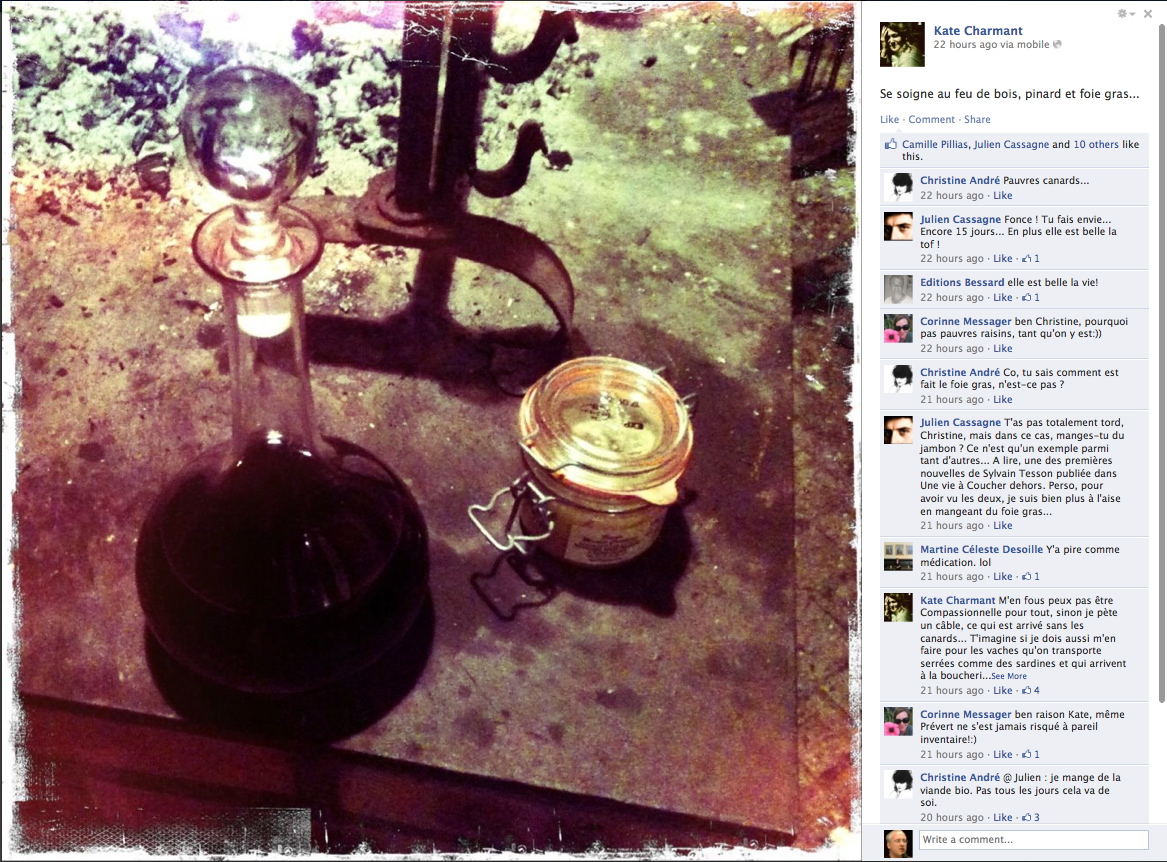
Fig. 6. Picture published in Facebook and its accompanying conversation, February 2012 (Hipstamatic, courtesy of Catherine Harmant).
As a sign of its success, we see a tendency to an autonomy of the visual conversation, through tools of collection and rebroadcast of images, such as Tumblr (2007) or Pinterest (2010), where retaking and circulating the content are the main resources of validation. A platform dedicated to the connected image, such as Instagram (2010), allows helping in the creation of collaborative answers to a common event, a meteorological phenomenon or a cultural occasion, welcomed by a photographic production whose display takes the aspect of a collective game (see fig 7).

Fig. 7. Collection of selfies published in Instagram on the release date of the video game Grand Theft Auto 5, September 2013 (priv. coll.).
Conversely, integrating images in the conversation makes them benefit from the validation systems that reward participating in social networks. The exposition and public appreciation of self-produced photography grant it a critical, aesthetic or social legitimacy. They also favor the presence of an autonomous interpretation exercise, that seems necessary to reduce the ambiguity of the images26.
By sharing broadly the new visual practices, the big social networks also give them an unprecedented visibility and contribute to their viral propagation. A satirical video published in December 2012 at the College Humor site redirects a song by Nickelback to make fun of the trends in connected photography27. Pictures of meals, feet, cats, airplane wings, filters, selfies, etc.: the clip draws up a long list of themes repeated on the timelines of Facebook and Twitter. This excellent parody shows that placing these visual forms together is beautiful and correctly identified as numerous autonomous patterns.
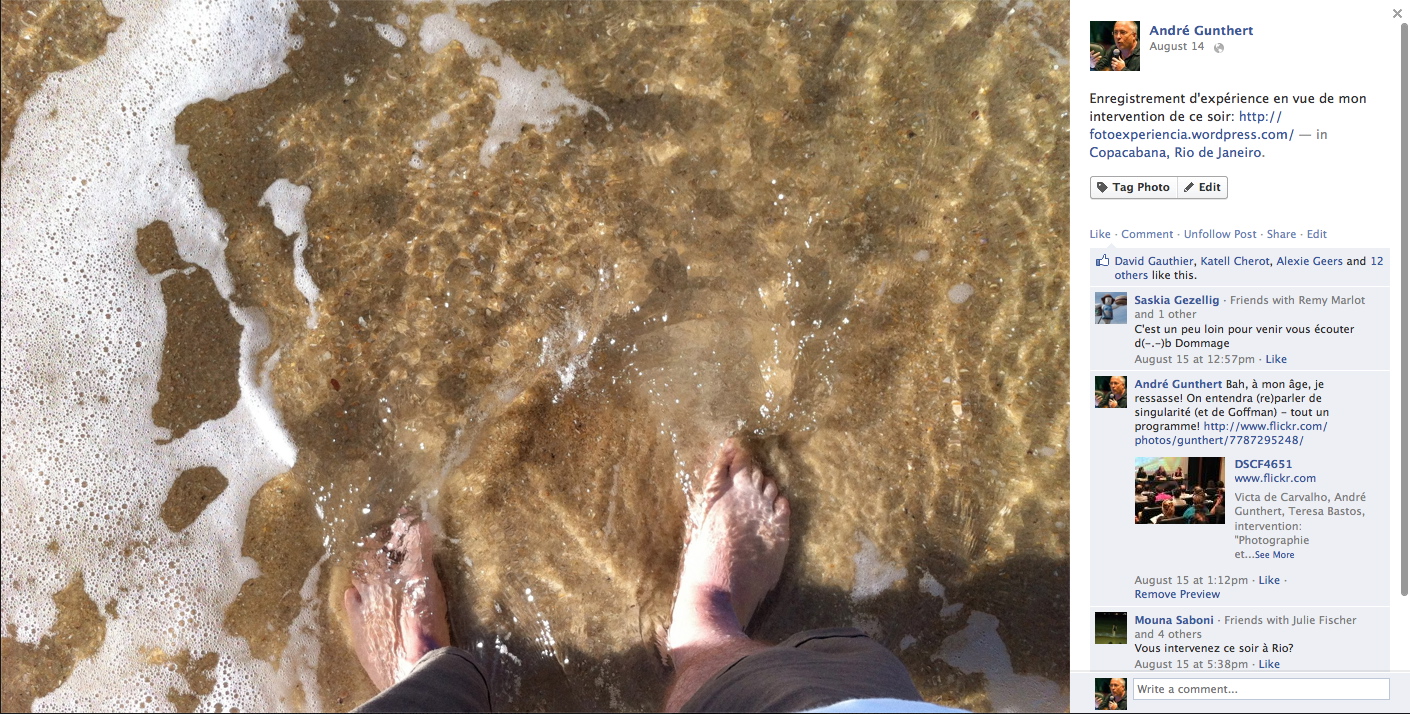
Fig. 8. Contextual self-photograph of a pair of feet published on Facebook, Rio de Janeiro, August 2012 (priv. coll.).
By examining the characteristics of private photographies from the early 20th century, Marin Dacos noticed that a large part of album photos reproduced the models of studio photography or publicity published on the papers28. By granting a group of visual practices a certificate of recognition, the video of College Humor suggests that from now on we help in a reversal phenomenon. As with memes or recommendations, the private iconography benefits from the transition that sees social networks take the place of traditional media in terms of cultural developers. Through them, the vernacular productions achieve a rank of identifiable and reproducible models.
This new visibility manifests particularly through negative reactions. This way, in 2013 we were able to see "selfie" being selected as word of the year by the editors of the Oxford Dictionary due to a share of media commentaries that denounced that the Web was saturated with this narcissistic exercise of connected self-portraits29. By criticizing an excessive presence, this reception is witnessing an standard that the genre is in the process of achieving.
When Michel de Certeau was trying to get close to the "ordinary culture", he expressed his discomfort at facing the "almost invisibility" of practices "that were hardly signaled by their own products30". On the contrary, the visibility that the main social networks give the individual expression reverse the dynamic of the production of the standard. In the past, the popular classes copied whatever the stars did. From this point forward, celebrities and the big names of this world are the ones who reproduce the models issued by the general public by conforming themselves to the rules of the selfie.
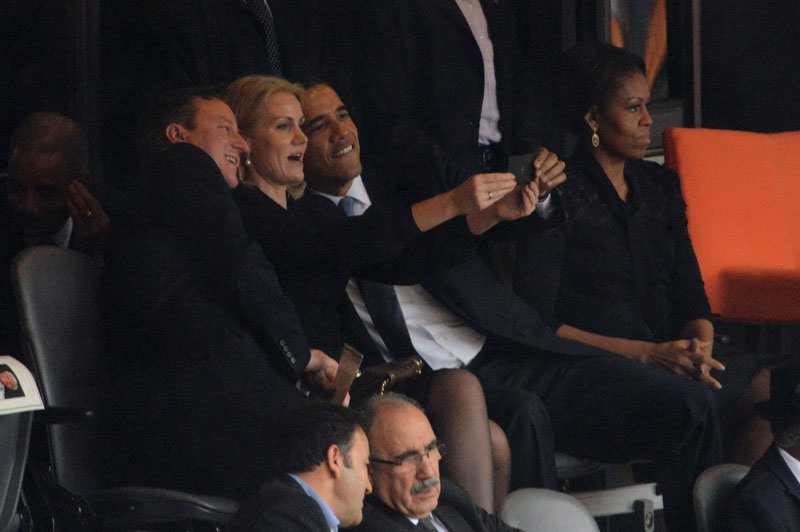
Fig. 9. Roberto Schmidt, photograph of a selfie with a smartphone by Danish Prime Minister Helle Thorning--‐Schmidt next to Barack Obama and David Cameron during the Nelson Mandela memorial service, December 11th, 2013 (AFP).
We can regret this development of a "barbaric taste" —to quote Kant's expression retaken by Bourdieu31— by social networks, the intermediaries of the ordinary culture. But isn't bringing good and bad taste into opposition the wrong way of address the problem? While the visual or musical practices encourage an unexpected approach inspired on art history, that places first the creativity of the authors and supposes a self-sufficiency for the expressive motivation, the test of language forms proposes a neutral description of the process. But, unlike the creation, or even the expression, the conversation is an autonomous domain with a communicative and social utility32. In this context, the new visual practices shouldn't be analyzed only from an aesthetic point of view.
The victory of use over content is particularly obvious with Snapchat (2011), a mobile application of visual messaging that offers the possibility of deleting the picture a few seconds after consulting it.
This feature of protected conversations through the fugacity of an iconic message has become a success for this medium with the young population, who uses it at a rhythm similar to SMS. By programming the disappearance of the image, Snapchat adds a playful dimension, as well as a supplementary freedom for the user, promoting an informal or relaxed use. The application clearly illustrates the desertion of the territory of labor and elaboration in favor of a conversation in real time. Already broadly detectable by most social networks, this shift suggests the description of ordinary practices of the image as a new language.
As with the arrival of the cinema or the television, the arrival of the conversational image transforms deeply our visual practices. Photography used to be an art and a medium. We are living the moment when it is accessing the universality of a language. Integrated by multipurpose tools for connected systems, the visual forms have begun to engage greatly in both private and public conversations. Whatever individuals can do for their production and interpretation contributes to a fast evolution of formats and uses. The visibility conferred by social networks speeds their diffusion and gives birth to self-produced standards. The appropriation of the visual language helps reinvent everyday life. Moreover, the extension of the utility of images states specific problems to be analyzed. If the semiotics of visual forms had until now leaned on a narrow register of assumed contexts, identifiable by a unique formal test, the variety of these new applications is imposing a change towards an ethnography of uses.
24 Tim Kindberg, Mirjana Spasojevic, Rowanne Fleck, Abigail Sellen, "I Saw This and Thought of You. Some Social Uses of Camera Phones", Extended Abstracts of the Conference on Human Factors in Computing Systems (CHI 2005), 2005, ACM Press, p. 1545-1548 ; Gaby David, "The Intimacy of Strong Ties in Mobile Visual Communication", Culture Visuelle, April 22th, 2013 (http://culturevisuelle.org/corazonada/2013/04/22/the-intimacy-of-strong-ties-in-mobile visualcommunication/).
25 A meme is a repetitive pattern whose viral diffusion takes the form of an adaptable game based on decontextualization (André Gunthert, “La culture du partage ou la revanche des foules”, in Hervé Le Crosnier (dir.), Culturenum. Jeunesse, culture et éducation dans la vague numérique, Caen, C & F Editions, 2013, p. 163-175).
26 Fatima Aziz, "L'image transactionnelle, enquête sur les usages visuels de Facebook", Etudes photographiques, n° 31, Spring 2014 (to be published).
27 "Look at this Instagram (Nickelback Parody)", College Humor, December 3th, 2012 (http://www.collegehumor.com/video/6853117/look-at-this-instagram-nickelback-parody).
28 Marin Dacos, "Regards sur l'élégance au village. Identités et photographies, 1900-1950", Études photographiques, n° 16, May 2005 (on line: http://etudesphotographiques.revues.org/728).
29Sherry Turkle, "The Documented Life", The New York Times, December 15th, 2013 (on line: http://www.nytimes.com/2013/12/16/opinion/the-documented-life.html).
30 Michel de Certeau, op. cit., p. 53.
31 Emmanuel Kant, Critique de la faculté de juger (1790, éd. Ferdinand Alquié), 1-13, Paris, Gallimard, 1985, p. 155 ; Pierre Bourdieu, op. cit., p. 130.
32 Catherine Kerbrat-Orecchioni, L'Enonciation. De la subjectivité dans le langage, Paris, Armand Colin, 4 e éd., 2009.
 André Gunthert (Francia, 1961). Lives and works in France. He works as a researcher in cultural history and visual studies, holds a PhD in Art History and is an associate professor at the EHESS (School for Higher Studies in Social Sciences). Gunthert is also the director of the Laboratory of Contemporary Visual History (LHIVIC) and the founder of the digital journals Photographic studies and Visual Culture. He is currently carrying out research into the new uses of the digital image. His writings on visual culture can be consulted in his blog: L'Atelier des icônes.
André Gunthert (Francia, 1961). Lives and works in France. He works as a researcher in cultural history and visual studies, holds a PhD in Art History and is an associate professor at the EHESS (School for Higher Studies in Social Sciences). Gunthert is also the director of the Laboratory of Contemporary Visual History (LHIVIC) and the founder of the digital journals Photographic studies and Visual Culture. He is currently carrying out research into the new uses of the digital image. His writings on visual culture can be consulted in his blog: L'Atelier des icônes.André Gunthert, "Conversational image: new uses of digital photography.", Etudes photographiques, n° 31, printemps 2014.
The connected photography can't exist without a recipient. Beyond a first-degree utility, the communicative systems also give images the function of engaging in a conversation or a dialogical unity. This way they acquire a second-degree utility as expressive forms. In private exchanges, the protection of the messages and the familiarity of the participants encourages implicit contents, contextual games, or transgression24. In social networks, the public visibility enables collective practices: a participative interpretation through a series of commentaries generated by an iconic source, or a choral construction, by taking and repeating a motive transformed in a meme25, that shows the social productivity of visual forms (see fig. 6).

Fig. 6. Picture published in Facebook and its accompanying conversation, February 2012 (Hipstamatic, courtesy of Catherine Harmant).
As a sign of its success, we see a tendency to an autonomy of the visual conversation, through tools of collection and rebroadcast of images, such as Tumblr (2007) or Pinterest (2010), where retaking and circulating the content are the main resources of validation. A platform dedicated to the connected image, such as Instagram (2010), allows helping in the creation of collaborative answers to a common event, a meteorological phenomenon or a cultural occasion, welcomed by a photographic production whose display takes the aspect of a collective game (see fig 7).

Fig. 7. Collection of selfies published in Instagram on the release date of the video game Grand Theft Auto 5, September 2013 (priv. coll.).
Conversely, integrating images in the conversation makes them benefit from the validation systems that reward participating in social networks. The exposition and public appreciation of self-produced photography grant it a critical, aesthetic or social legitimacy. They also favor the presence of an autonomous interpretation exercise, that seems necessary to reduce the ambiguity of the images26.
By sharing broadly the new visual practices, the big social networks also give them an unprecedented visibility and contribute to their viral propagation. A satirical video published in December 2012 at the College Humor site redirects a song by Nickelback to make fun of the trends in connected photography27. Pictures of meals, feet, cats, airplane wings, filters, selfies, etc.: the clip draws up a long list of themes repeated on the timelines of Facebook and Twitter. This excellent parody shows that placing these visual forms together is beautiful and correctly identified as numerous autonomous patterns.

Fig. 8. Contextual self-photograph of a pair of feet published on Facebook, Rio de Janeiro, August 2012 (priv. coll.).
By examining the characteristics of private photographies from the early 20th century, Marin Dacos noticed that a large part of album photos reproduced the models of studio photography or publicity published on the papers28. By granting a group of visual practices a certificate of recognition, the video of College Humor suggests that from now on we help in a reversal phenomenon. As with memes or recommendations, the private iconography benefits from the transition that sees social networks take the place of traditional media in terms of cultural developers. Through them, the vernacular productions achieve a rank of identifiable and reproducible models.
This new visibility manifests particularly through negative reactions. This way, in 2013 we were able to see "selfie" being selected as word of the year by the editors of the Oxford Dictionary due to a share of media commentaries that denounced that the Web was saturated with this narcissistic exercise of connected self-portraits29. By criticizing an excessive presence, this reception is witnessing an standard that the genre is in the process of achieving.
When Michel de Certeau was trying to get close to the "ordinary culture", he expressed his discomfort at facing the "almost invisibility" of practices "that were hardly signaled by their own products30". On the contrary, the visibility that the main social networks give the individual expression reverse the dynamic of the production of the standard. In the past, the popular classes copied whatever the stars did. From this point forward, celebrities and the big names of this world are the ones who reproduce the models issued by the general public by conforming themselves to the rules of the selfie.

Fig. 9. Roberto Schmidt, photograph of a selfie with a smartphone by Danish Prime Minister Helle Thorning--‐Schmidt next to Barack Obama and David Cameron during the Nelson Mandela memorial service, December 11th, 2013 (AFP).
We can regret this development of a "barbaric taste" —to quote Kant's expression retaken by Bourdieu31— by social networks, the intermediaries of the ordinary culture. But isn't bringing good and bad taste into opposition the wrong way of address the problem? While the visual or musical practices encourage an unexpected approach inspired on art history, that places first the creativity of the authors and supposes a self-sufficiency for the expressive motivation, the test of language forms proposes a neutral description of the process. But, unlike the creation, or even the expression, the conversation is an autonomous domain with a communicative and social utility32. In this context, the new visual practices shouldn't be analyzed only from an aesthetic point of view.
The victory of use over content is particularly obvious with Snapchat (2011), a mobile application of visual messaging that offers the possibility of deleting the picture a few seconds after consulting it.
This feature of protected conversations through the fugacity of an iconic message has become a success for this medium with the young population, who uses it at a rhythm similar to SMS. By programming the disappearance of the image, Snapchat adds a playful dimension, as well as a supplementary freedom for the user, promoting an informal or relaxed use. The application clearly illustrates the desertion of the territory of labor and elaboration in favor of a conversation in real time. Already broadly detectable by most social networks, this shift suggests the description of ordinary practices of the image as a new language.
As with the arrival of the cinema or the television, the arrival of the conversational image transforms deeply our visual practices. Photography used to be an art and a medium. We are living the moment when it is accessing the universality of a language. Integrated by multipurpose tools for connected systems, the visual forms have begun to engage greatly in both private and public conversations. Whatever individuals can do for their production and interpretation contributes to a fast evolution of formats and uses. The visibility conferred by social networks speeds their diffusion and gives birth to self-produced standards. The appropriation of the visual language helps reinvent everyday life. Moreover, the extension of the utility of images states specific problems to be analyzed. If the semiotics of visual forms had until now leaned on a narrow register of assumed contexts, identifiable by a unique formal test, the variety of these new applications is imposing a change towards an ethnography of uses.
24 Tim Kindberg, Mirjana Spasojevic, Rowanne Fleck, Abigail Sellen, "I Saw This and Thought of You. Some Social Uses of Camera Phones", Extended Abstracts of the Conference on Human Factors in Computing Systems (CHI 2005), 2005, ACM Press, p. 1545-1548 ; Gaby David, "The Intimacy of Strong Ties in Mobile Visual Communication", Culture Visuelle, April 22th, 2013 (http://culturevisuelle.org/corazonada/2013/04/22/the-intimacy-of-strong-ties-in-mobile visualcommunication/).
25 A meme is a repetitive pattern whose viral diffusion takes the form of an adaptable game based on decontextualization (André Gunthert, “La culture du partage ou la revanche des foules”, in Hervé Le Crosnier (dir.), Culturenum. Jeunesse, culture et éducation dans la vague numérique, Caen, C & F Editions, 2013, p. 163-175).
26 Fatima Aziz, "L'image transactionnelle, enquête sur les usages visuels de Facebook", Etudes photographiques, n° 31, Spring 2014 (to be published).
27 "Look at this Instagram (Nickelback Parody)", College Humor, December 3th, 2012 (http://www.collegehumor.com/video/6853117/look-at-this-instagram-nickelback-parody).
28 Marin Dacos, "Regards sur l'élégance au village. Identités et photographies, 1900-1950", Études photographiques, n° 16, May 2005 (on line: http://etudesphotographiques.revues.org/728).
29Sherry Turkle, "The Documented Life", The New York Times, December 15th, 2013 (on line: http://www.nytimes.com/2013/12/16/opinion/the-documented-life.html).
30 Michel de Certeau, op. cit., p. 53.
31 Emmanuel Kant, Critique de la faculté de juger (1790, éd. Ferdinand Alquié), 1-13, Paris, Gallimard, 1985, p. 155 ; Pierre Bourdieu, op. cit., p. 130.
32 Catherine Kerbrat-Orecchioni, L'Enonciation. De la subjectivité dans le langage, Paris, Armand Colin, 4 e éd., 2009.
 André Gunthert (Francia, 1961). Lives and works in France. He works as a researcher in cultural history and visual studies, holds a PhD in Art History and is an associate professor at the EHESS (School for Higher Studies in Social Sciences). Gunthert is also the director of the Laboratory of Contemporary Visual History (LHIVIC) and the founder of the digital journals Photographic studies and Visual Culture. He is currently carrying out research into the new uses of the digital image. His writings on visual culture can be consulted in his blog: L'Atelier des icônes.
André Gunthert (Francia, 1961). Lives and works in France. He works as a researcher in cultural history and visual studies, holds a PhD in Art History and is an associate professor at the EHESS (School for Higher Studies in Social Sciences). Gunthert is also the director of the Laboratory of Contemporary Visual History (LHIVIC) and the founder of the digital journals Photographic studies and Visual Culture. He is currently carrying out research into the new uses of the digital image. His writings on visual culture can be consulted in his blog: L'Atelier des icônes.Cia de Foto
Out of all the projects carried out by Cia de Foto, this is undoubtedly the most subjective one, as it shares a space that tests the coexistence of the members, their daily life and also the material that unites them: intimacy and affection. To paraphrase Duchamp, this is a “definitely unfinished” project , with an uncertain beginning point, which starts with time undefined in memory and includes formats as varied as those that can be found when one opens a box full of photographs.
In this manner, and following a request by the curator, Eder Chiodetto, this project was integrated into the Collectors’ club of the MAM (Museu de Arte Moderna) in São Paulo, through a video edit with a soundtrack by DJ Guab. The version presented here became the most famous one.
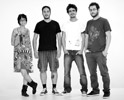 Cia de foto (Brazil, 2003). Photography Co. (Brazil, 2003). Brazilian photography collective whose works employ various visual languages, questioning the context and multiple meanings of the image. Using theoretical and experimental research, they seek to expand the limits of photographic perspectives. They have taken part in several national and international exhibitions, and collaborated in organizing seminars, publications, festivals and curatorships with photography as the central theme. Their work can be viewed at ciadefoto.com
Cia de foto (Brazil, 2003). Photography Co. (Brazil, 2003). Brazilian photography collective whose works employ various visual languages, questioning the context and multiple meanings of the image. Using theoretical and experimental research, they seek to expand the limits of photographic perspectives. They have taken part in several national and international exhibitions, and collaborated in organizing seminars, publications, festivals and curatorships with photography as the central theme. Their work can be viewed at ciadefoto.comOut of all the projects carried out by Cia de Foto, this is undoubtedly the most subjective one, as it shares a space that tests the coexistence of the members, their daily life and also the material that unites them: intimacy and affection. To paraphrase Duchamp, this is a “definitely unfinished” project , with an uncertain beginning point, which starts with time undefined in memory and includes formats as varied as those that can be found when one opens a box full of photographs.
In this manner, and following a request by the curator, Eder Chiodetto, this project was integrated into the Collectors’ club of the MAM (Museu de Arte Moderna) in São Paulo, through a video edit with a soundtrack by DJ Guab. The version presented here became the most famous one.
 Cia de foto (Brazil, 2003). Photography Co. (Brazil, 2003). Brazilian photography collective whose works employ various visual languages, questioning the context and multiple meanings of the image. Using theoretical and experimental research, they seek to expand the limits of photographic perspectives. They have taken part in several national and international exhibitions, and collaborated in organizing seminars, publications, festivals and curatorships with photography as the central theme. Their work can be viewed at ciadefoto.com
Cia de foto (Brazil, 2003). Photography Co. (Brazil, 2003). Brazilian photography collective whose works employ various visual languages, questioning the context and multiple meanings of the image. Using theoretical and experimental research, they seek to expand the limits of photographic perspectives. They have taken part in several national and international exhibitions, and collaborated in organizing seminars, publications, festivals and curatorships with photography as the central theme. Their work can be viewed at ciadefoto.comAndré Gunthert
André Gunthert, "Conversational image: new uses of digital photography.", Etudes photographiques, n° 31, printemps 2014.
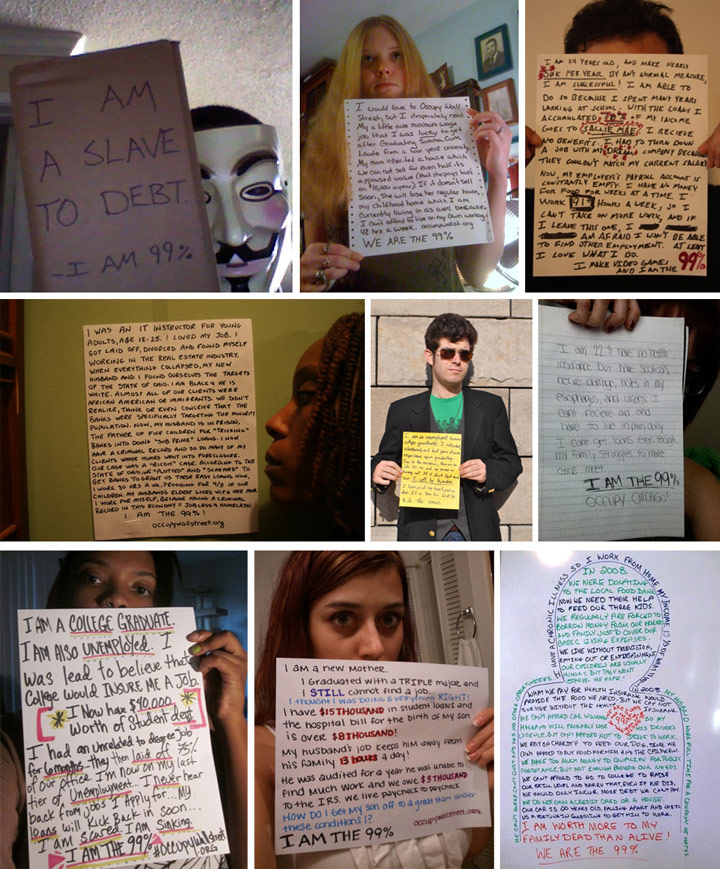
Fig. 1. Collection of visual messages from the collaborative activist blog "We are the 99%", October 2011.
Directed by Steven Spielberg and based on a novel by Philip K. Dick, the movie Minority Report released in 2002 is renowned for the credibility of its predictions about technology. It depicts a universe in 2054 based on the propositions of a group of experts, and it is famous for having foreseen the use of tactile interfaces. In addition to the visualization of mental images, it predicts the generalization of optical identification for monitoring or advertisement profiling purposes.
The most important part of this forecasting exercise is how its near-sightedness is even more remarkable in face of what has become, shortly after, common in the visual practices of developed countries. In the film, the private uses of the image are limited to traditional printed photographs, three-dimensional films, and interactive video conversations.
Some years later, these expectations seem to have been exceeded long ago. Instead of half a century, man only needed three to five years to have available on a daily basis video communication tools (Skype 2.0, 2005) or tactile interfaces (Apple iPhone, 2007). In contrast, no one would have imagined the rise of multimedia messaging services, the diversity of images or visual conversations in social networks. The present has left the future behind, and nowadays Minority Report seems trapped in a Foucauldian perception of the image as an instrument of control and domination.
The unforeseen uses, much more avant-gardist than anything that could have been imagined at the beginning of the 21st century, have turned upside-down our visual practices and have evidently found a place of their own. Yet, its unpredictable nature provides an invaluable historical indication. Quite the opposite of what happened to the automobile, aviation, or television —that fell into an extension of horse carriages, navigation, or radio— the development of innovations such as photography, cinema, or records depends on proprietary mechanisms where the choice of users has had a major role. The same holds true for interactive images, an unexpected product of the encounter of the digitalization of visual contents and the documented interaction.
From the fluid image to connected photography
At the beginning of the 1990's, the digitalization of photography was described both as a revolution and as a catastrophe. By prolonging the traditional technical approach, many specialists see in the transition to pixels the ruin of the indexicality and a sign of the end of our trust in the truth of images 1 .
At one time writing transformed the language into information, granting it irreplaceable properties of preservation, reproduction, or transmission. Now, by reducing the images' materiality, digitalization grants them a new plasticity and mobility. In the form of files easy to copy or manipulate, the iconic object becomes a fluid image.
This first stage of digital transition has important consequences in the industry of images: the disappearance of laboratories, simplification of procedures, multiplication of numerical databases, and rise of prices. However, in spite of a considerable technological jump, we have been able to observe a remarkable continuity in the forms and uses. For twenty years the digital transition has only affected the edges of visual practices. Contrary to the most somber predictions, journals have continued publishing illustrated reports and parents still take pictures of their children. Just as an automobile that traded a thermal motor for an electrical one, photography has preserved its most essential functions. There has not been a catastrophe of what is visible but, more mundanely, an acceleration of the rationalization of the field 2.
Following the example set in Minority Report, many specialists expected that this rise of new visual tools came with a shift to animated and more seductive images, and a loss of interest for motionless images. The practice of amateur video has certainly seen an important progression 3.
Nevertheless, the motionless image continues to be the most exchanged content.
It is not easy to compare in absolute terms the amount of photos and videos shared in social networks, for seconds are usually counted up in broadcasting hours. Facebook has stopped providing regular information regarding animated images, which suggests a weak increase. In 2010, at a time where social networks had half a billion members, the figures available indicated 2.5 billion of downloaded photos per month but only 20 million videos, that is 125 times less (the difference of point of view of the amateur production increases if we consider the fact that shared videos constitute a more important proportion of repeated material while photo is richer in self-produced contents).
It seems that the main advantage of the motionless image over the video is its fluidity. Video is at a disadvantage due to the weight of its files, the download time, and the restriction of formats. Not being as universal as a photo, a video can only be envisioned in an environment comprised by an appropriate reading device. In contrast, a JPEG file or an animated GIF4 have the advantage of being able to appear in any environment, in a computer or a platform, a mobile or a tablet.
Between 2008 and 2011 the landscape changed unexpectedly. It came not in the form of a camera, but a hand-held telephone produced by a computer brand. The Apple's iPhone, conceived by Steve Jobs to give major access to web features 5 (especially the 3G version available since 2008), foretells an essential evolution: that of connected photography6.
In every developed country, it is not long before the sales of cameras were surpassed by those of cell phones. In 2011, while 4.6 million of cameras were being commercialized in France (two times more than in the late 1990's) smartphones reached 12 million units 7.
The adaptation of photography to mobile telephony existed since the first camera phones were available in Japan since the year 2000. But the power conferred to this convergence by the 3G norm (UMTS), comparable to the transition from modem to broadband, opens the way to the full implementation of visual practices.
This evolution turns a smartphone into a universal camera. In the past, carrying a camera implied anticipating an occasion to take pictures. In contrast, the telephone that we carry for communicative tasks or for fun, turns photography into something that is always available 8.
The moment to take a photograph belongs to a range of codified events, outside of which taking pictures is not tolerated9.
The only exception being tourists and the justification of exoticism authorize an extreme use of a camera. By granting the possibility of being recorded to every moment in life, a cell phone transforms each one of us into a daily tourist, ready to take a picture at any time. This new skill is manifested mainly by the publication in the press of amateur photos or videos of major tragedies or accidents (the London attacks in 2005; the campus shootings in Virginia Tech in 2007; the plane crash in Hudson River in 2009, etc.).
But the metamorphosis does not end with the production of images; connected photography results in the alliance of the smartphone and communication tools, instant messages, or social networks, where the image can be immediately transferred through elemental operations. Even if this union is but a fraction of amateur practices, it imposes itself as an emblematic stage: the symbol of a second evolution of digital images.
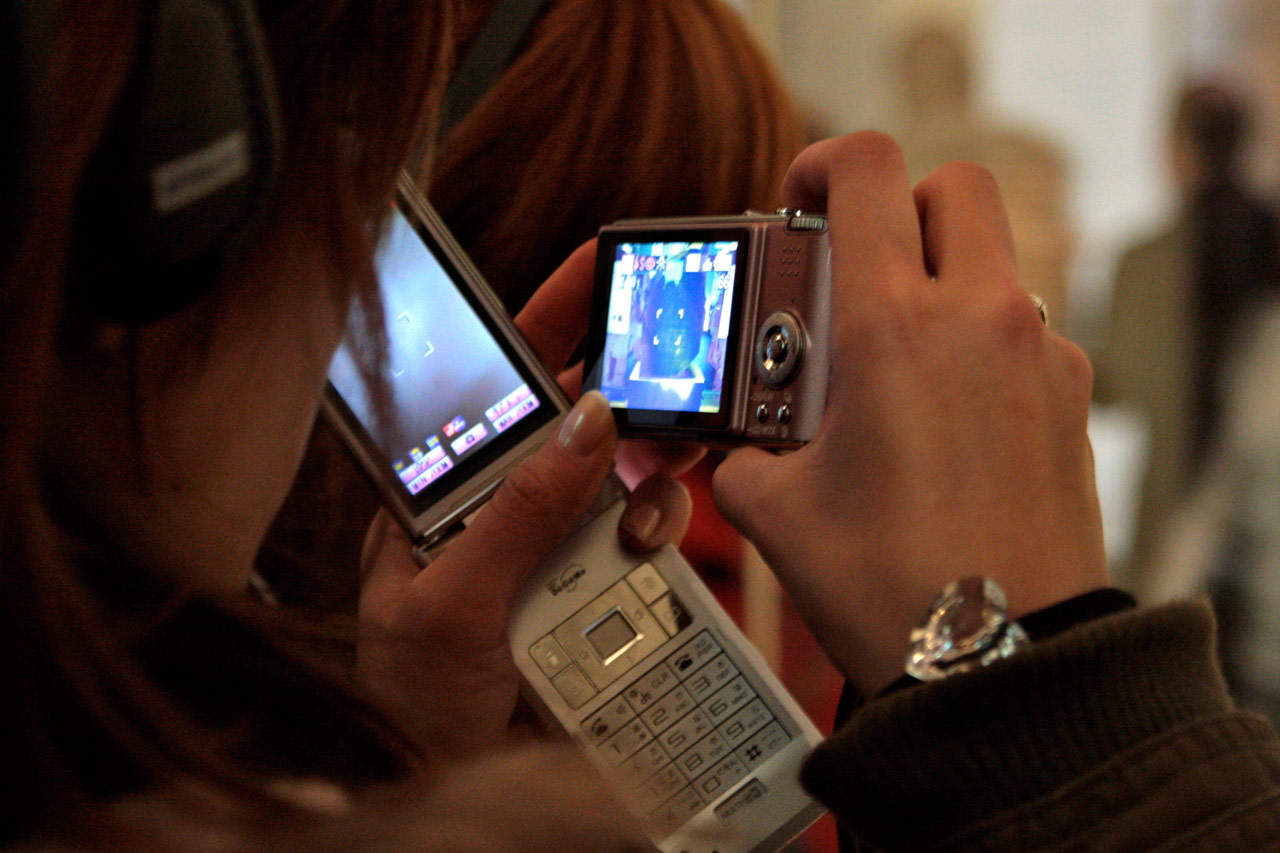
Fig. 2. Photograph at a museum. A tourist uses at the same time a camera and a camera phone, depending on what she wishes to achieve or convey in the image (British Museum, London, 2008, priv. coll.).
Being able to share in real time a photo to a friend or group of friends —an ability once reserved only to some wireline services— modifies thoroughly its uses. During this initial period, the quality of pictures offered by smartphones regressed in comparison to that proposed by compact cameras. In these terms, choosing a cell phone rather than a camera or the strong progression of production in this format indicated that users find an advantage to connected photography. The lack of quality is largely made up by the utility of new uses of the image, particularly by the increase in the ability to exhibit them through social networks.
Facebook, the vastest of them, which was made public in 2006, improved considerably its interface to present images between 2009 and 2011, making it easier to integrate visual files and offering a better visibility. From this point forward, taking a picture is no longer enough, what counts is being able to show it, discuss it, and share it. As the first place of exposition of self-produced photographs, Facebook logically became the most important collection of images in the world (over 250 billion photos downloaded in September of 2013 10 ). In spite of the recent loss of media achievements, this will always be the main historical site of spreading regarding connected images.
Being able to share your own photographs or to discuss them was already possible at Flickr since 2004. But the specialized platform continues to be a space for discussion centered on images. The breach created by Facebook was to propose a general environment equipped with a maximum of features, structured not around specific interests but, more fundamentally, around the interaction between real people. As Pierre Bourdieu had noticed, the uses of amateur photography continue to be mainly social 11. In Facebook, discussion focuses on any aspect of existence. Images are not mobile mainly due to aesthetic qualities but because they document life, take part in the game of self-representation, and are useful as reference documents.
This revolution of diversification modifies fundamentally the ancient paradigm of photography based on technique, the supremacy of taking pictures, the materiality, and the objectivity of the image. While the visual recording used to form an autonomous universe strongly identified, what characterizes it nowadays is its integration to the gist of multipurpose systems. The delay for camera manufacturers, who objected to transform their materials into connected tools and kept the communicative features to a minimum12 is meaningful to the extent of the change. For the first time in history, photography has become a niche practice at the core of a more vast universe: that of electronic communication.
We can compare this integration with the process of miniaturization that affected clock making between the 15th and the 19th century, taking the timepieces from bell towers of churches to the interior of salons, and to the pocket of a piece of clothing. By gaining availability at each stage, the time function evolves and transforms itself:
"The small time pieces that, as a result had, domestically or personally, a whole different quality and sense than public and monumental mechanisms. The possibility of a use both private and universal established the bases of a way to control time, in contrast to the merely obeying it", explains historian David Landes13.
Having become one of many components in the universe of communication, is photography not at risk of disappearing? Quite the contrary. If photography integrates blends with other devices, it will be inconceivable to think of a communication tool without a camera, or a digital environment lacking a visual display. In every connected object the photographic feature is independent; it has gained in universality and adaptation, fulfilling to its best its promise of democratization of the visual production. As with the clock, the integration of photography, which is only beginning, continues announcing that it will go beyond its original function. Hereafter, the generalization of the production of images announces a revolution of its uses.
1 William J. Mitchell, The Reconfigured Eye. Visual Truth in the Post-Photographic Era,Cambridge, London, MIT Press, 1992; Pierre Barboza, Du photographique au numérique. La parenthèse indicielle dans l'histoire des images, Paris, L'Harmattan, 1996.
2 Sylvain Maresca, Dominique Sagot-Duvauroux, "Photographie(s) et numérique(s). Du singulier au pluriel" (memo at symposium "Travail et création artistique en régime numérique", Avignon, 27 may 2011), La vie sociale des images, 5 may 2011 (http://culturevisuelle.org/viesociale/2791).
3 Out of 100 people aged 15 and over, 14 declared having made movies or videos in 1997 vs. 27 in 2008, an increase by almost 2-fold; Olivier Donnat, Les Pratiques culturelles des Français à l'ère numérique. Enquête 2008, Paris, La Découverte, 2009, p. 190. Confirmation of determination through fluidity: short-video formats have experienced the strongest development.
4 Proposed in 1991, the JPEG format (Joint Photographic Expert Group) is a compressed format used for most motionless images on line. The animated GIF (part of the public domain since 2004) allows to post in the same context a looped sequence of images, joined in a same file.
5 Walter Isaacson, Steve Jobs Trans. by Dominique Defert and Carole Delporte. Paris, Lattès, 2011. p. 529-539.
6 Edgar Gómez Cruz, Eric T. Meyer, "Creation and Control in the Photographic Process. iPhones and the Emerging Fifth Moment of Photography", Photographies, 5/2, 2012.
7 "The life cycle of a photograph in the digital era", Ipsos survey 2011 (communication SIPEC September 2011).
8 Nancy Van House et al., "The Uses of Personal Networked Digital Imaging. An Empirical Study of Cameraphone Photos and Sharing", Extended Abstracts of the Conference on Human Factors in Computing Systems (CHI 2005), 2005, ACM Press, p. 1853-1856.
9 "In the eyes of the peasant, the city-dweller is the one who succumbs to a sort of perceptual 'anything goes-ism'; and this attitude appears incomprehensible to him because he refers to an implicit philosophy according to which only certain objects, on certain occasions, are worthy of being photographed", Pierre Bourdieu, "The Social Definition of Photography", Un art moyen. Essai sur lesusages sociaux de la photographie, Paris, Minuit, 1965, p. 117.
10 « Every day, there are more than 4.75 billion content items shared on Facebook (including status updates, wall posts, photos, videos and comments), more than 4.5 billion "Likes", and more than 10 billion messages sent. More than 250 billion photos have been uploaded to Facebook, and more than 350 million photos are uploaded every day on average », A Focus on Efficiency, Facebook/Ericsson/Qualcomm whitepaper, 16 September2013, p. 6(en línea: https://fbcdn--dragon-a.akamaihd.net/hphotos-ak-prn1/851575_520797877991079_393255490_n.pdf ).
11 Pierre Bourdieu, "La définition sociale de la photographie", op. cit., p. 108-138.
12 Samsung, the main competitor of Apple in terms of smartphones, proposed in 2012 the first "smart cameras" equipped with Wi-Fi transmitters, the variety of NX hybrid and the EX2F, a compact expert. That same year, Nikon chose to introduce its Coolpix S800c with Android OS.
13 David S. Landes, L'Heure qu'il est. Les horloges, la mesure du temps et la formation du monde moderne (1983, translated from the English by Pierre-Emmanuel Dauzat), París, Gallimard, 1987, p. 30.
 André Gunthert (Francia, 1961). Lives and works in France. He works as a researcher in cultural history and visual studies, holds a PhD in Art History and is an associate professor at the EHESS (School for Higher Studies in Social Sciences). Gunthert is also the director of the Laboratory of Contemporary Visual History (LHIVIC) and the founder of the digital journals Photographic studies and Visual Culture. He is currently carrying out research into the new uses of the digital image. His writings on visual culture can be consulted in his blog: L'Atelier des icônes.
André Gunthert (Francia, 1961). Lives and works in France. He works as a researcher in cultural history and visual studies, holds a PhD in Art History and is an associate professor at the EHESS (School for Higher Studies in Social Sciences). Gunthert is also the director of the Laboratory of Contemporary Visual History (LHIVIC) and the founder of the digital journals Photographic studies and Visual Culture. He is currently carrying out research into the new uses of the digital image. His writings on visual culture can be consulted in his blog: L'Atelier des icônes.André Gunthert, "Conversational image: new uses of digital photography.", Etudes photographiques, n° 31, printemps 2014.

Fig. 1. Collection of visual messages from the collaborative activist blog "We are the 99%", October 2011.
Directed by Steven Spielberg and based on a novel by Philip K. Dick, the movie Minority Report released in 2002 is renowned for the credibility of its predictions about technology. It depicts a universe in 2054 based on the propositions of a group of experts, and it is famous for having foreseen the use of tactile interfaces. In addition to the visualization of mental images, it predicts the generalization of optical identification for monitoring or advertisement profiling purposes.
The most important part of this forecasting exercise is how its near-sightedness is even more remarkable in face of what has become, shortly after, common in the visual practices of developed countries. In the film, the private uses of the image are limited to traditional printed photographs, three-dimensional films, and interactive video conversations.
Some years later, these expectations seem to have been exceeded long ago. Instead of half a century, man only needed three to five years to have available on a daily basis video communication tools (Skype 2.0, 2005) or tactile interfaces (Apple iPhone, 2007). In contrast, no one would have imagined the rise of multimedia messaging services, the diversity of images or visual conversations in social networks. The present has left the future behind, and nowadays Minority Report seems trapped in a Foucauldian perception of the image as an instrument of control and domination.
The unforeseen uses, much more avant-gardist than anything that could have been imagined at the beginning of the 21st century, have turned upside-down our visual practices and have evidently found a place of their own. Yet, its unpredictable nature provides an invaluable historical indication. Quite the opposite of what happened to the automobile, aviation, or television —that fell into an extension of horse carriages, navigation, or radio— the development of innovations such as photography, cinema, or records depends on proprietary mechanisms where the choice of users has had a major role. The same holds true for interactive images, an unexpected product of the encounter of the digitalization of visual contents and the documented interaction.
From the fluid image to connected photography
At the beginning of the 1990's, the digitalization of photography was described both as a revolution and as a catastrophe. By prolonging the traditional technical approach, many specialists see in the transition to pixels the ruin of the indexicality and a sign of the end of our trust in the truth of images 1 .
At one time writing transformed the language into information, granting it irreplaceable properties of preservation, reproduction, or transmission. Now, by reducing the images' materiality, digitalization grants them a new plasticity and mobility. In the form of files easy to copy or manipulate, the iconic object becomes a fluid image.
This first stage of digital transition has important consequences in the industry of images: the disappearance of laboratories, simplification of procedures, multiplication of numerical databases, and rise of prices. However, in spite of a considerable technological jump, we have been able to observe a remarkable continuity in the forms and uses. For twenty years the digital transition has only affected the edges of visual practices. Contrary to the most somber predictions, journals have continued publishing illustrated reports and parents still take pictures of their children. Just as an automobile that traded a thermal motor for an electrical one, photography has preserved its most essential functions. There has not been a catastrophe of what is visible but, more mundanely, an acceleration of the rationalization of the field 2.
Following the example set in Minority Report, many specialists expected that this rise of new visual tools came with a shift to animated and more seductive images, and a loss of interest for motionless images. The practice of amateur video has certainly seen an important progression 3.
Nevertheless, the motionless image continues to be the most exchanged content.
It is not easy to compare in absolute terms the amount of photos and videos shared in social networks, for seconds are usually counted up in broadcasting hours. Facebook has stopped providing regular information regarding animated images, which suggests a weak increase. In 2010, at a time where social networks had half a billion members, the figures available indicated 2.5 billion of downloaded photos per month but only 20 million videos, that is 125 times less (the difference of point of view of the amateur production increases if we consider the fact that shared videos constitute a more important proportion of repeated material while photo is richer in self-produced contents).
It seems that the main advantage of the motionless image over the video is its fluidity. Video is at a disadvantage due to the weight of its files, the download time, and the restriction of formats. Not being as universal as a photo, a video can only be envisioned in an environment comprised by an appropriate reading device. In contrast, a JPEG file or an animated GIF4 have the advantage of being able to appear in any environment, in a computer or a platform, a mobile or a tablet.
Between 2008 and 2011 the landscape changed unexpectedly. It came not in the form of a camera, but a hand-held telephone produced by a computer brand. The Apple's iPhone, conceived by Steve Jobs to give major access to web features 5 (especially the 3G version available since 2008), foretells an essential evolution: that of connected photography6.
In every developed country, it is not long before the sales of cameras were surpassed by those of cell phones. In 2011, while 4.6 million of cameras were being commercialized in France (two times more than in the late 1990's) smartphones reached 12 million units 7.
The adaptation of photography to mobile telephony existed since the first camera phones were available in Japan since the year 2000. But the power conferred to this convergence by the 3G norm (UMTS), comparable to the transition from modem to broadband, opens the way to the full implementation of visual practices.
This evolution turns a smartphone into a universal camera. In the past, carrying a camera implied anticipating an occasion to take pictures. In contrast, the telephone that we carry for communicative tasks or for fun, turns photography into something that is always available 8.
The moment to take a photograph belongs to a range of codified events, outside of which taking pictures is not tolerated9.
The only exception being tourists and the justification of exoticism authorize an extreme use of a camera. By granting the possibility of being recorded to every moment in life, a cell phone transforms each one of us into a daily tourist, ready to take a picture at any time. This new skill is manifested mainly by the publication in the press of amateur photos or videos of major tragedies or accidents (the London attacks in 2005; the campus shootings in Virginia Tech in 2007; the plane crash in Hudson River in 2009, etc.).
But the metamorphosis does not end with the production of images; connected photography results in the alliance of the smartphone and communication tools, instant messages, or social networks, where the image can be immediately transferred through elemental operations. Even if this union is but a fraction of amateur practices, it imposes itself as an emblematic stage: the symbol of a second evolution of digital images.

Fig. 2. Photograph at a museum. A tourist uses at the same time a camera and a camera phone, depending on what she wishes to achieve or convey in the image (British Museum, London, 2008, priv. coll.).
Being able to share in real time a photo to a friend or group of friends —an ability once reserved only to some wireline services— modifies thoroughly its uses. During this initial period, the quality of pictures offered by smartphones regressed in comparison to that proposed by compact cameras. In these terms, choosing a cell phone rather than a camera or the strong progression of production in this format indicated that users find an advantage to connected photography. The lack of quality is largely made up by the utility of new uses of the image, particularly by the increase in the ability to exhibit them through social networks.
Facebook, the vastest of them, which was made public in 2006, improved considerably its interface to present images between 2009 and 2011, making it easier to integrate visual files and offering a better visibility. From this point forward, taking a picture is no longer enough, what counts is being able to show it, discuss it, and share it. As the first place of exposition of self-produced photographs, Facebook logically became the most important collection of images in the world (over 250 billion photos downloaded in September of 2013 10 ). In spite of the recent loss of media achievements, this will always be the main historical site of spreading regarding connected images.
Being able to share your own photographs or to discuss them was already possible at Flickr since 2004. But the specialized platform continues to be a space for discussion centered on images. The breach created by Facebook was to propose a general environment equipped with a maximum of features, structured not around specific interests but, more fundamentally, around the interaction between real people. As Pierre Bourdieu had noticed, the uses of amateur photography continue to be mainly social 11. In Facebook, discussion focuses on any aspect of existence. Images are not mobile mainly due to aesthetic qualities but because they document life, take part in the game of self-representation, and are useful as reference documents.
This revolution of diversification modifies fundamentally the ancient paradigm of photography based on technique, the supremacy of taking pictures, the materiality, and the objectivity of the image. While the visual recording used to form an autonomous universe strongly identified, what characterizes it nowadays is its integration to the gist of multipurpose systems. The delay for camera manufacturers, who objected to transform their materials into connected tools and kept the communicative features to a minimum12 is meaningful to the extent of the change. For the first time in history, photography has become a niche practice at the core of a more vast universe: that of electronic communication.
We can compare this integration with the process of miniaturization that affected clock making between the 15th and the 19th century, taking the timepieces from bell towers of churches to the interior of salons, and to the pocket of a piece of clothing. By gaining availability at each stage, the time function evolves and transforms itself:
"The small time pieces that, as a result had, domestically or personally, a whole different quality and sense than public and monumental mechanisms. The possibility of a use both private and universal established the bases of a way to control time, in contrast to the merely obeying it", explains historian David Landes13.
Having become one of many components in the universe of communication, is photography not at risk of disappearing? Quite the contrary. If photography integrates blends with other devices, it will be inconceivable to think of a communication tool without a camera, or a digital environment lacking a visual display. In every connected object the photographic feature is independent; it has gained in universality and adaptation, fulfilling to its best its promise of democratization of the visual production. As with the clock, the integration of photography, which is only beginning, continues announcing that it will go beyond its original function. Hereafter, the generalization of the production of images announces a revolution of its uses.
1 William J. Mitchell, The Reconfigured Eye. Visual Truth in the Post-Photographic Era,Cambridge, London, MIT Press, 1992; Pierre Barboza, Du photographique au numérique. La parenthèse indicielle dans l'histoire des images, Paris, L'Harmattan, 1996.
2 Sylvain Maresca, Dominique Sagot-Duvauroux, "Photographie(s) et numérique(s). Du singulier au pluriel" (memo at symposium "Travail et création artistique en régime numérique", Avignon, 27 may 2011), La vie sociale des images, 5 may 2011 (http://culturevisuelle.org/viesociale/2791).
3 Out of 100 people aged 15 and over, 14 declared having made movies or videos in 1997 vs. 27 in 2008, an increase by almost 2-fold; Olivier Donnat, Les Pratiques culturelles des Français à l'ère numérique. Enquête 2008, Paris, La Découverte, 2009, p. 190. Confirmation of determination through fluidity: short-video formats have experienced the strongest development.
4 Proposed in 1991, the JPEG format (Joint Photographic Expert Group) is a compressed format used for most motionless images on line. The animated GIF (part of the public domain since 2004) allows to post in the same context a looped sequence of images, joined in a same file.
5 Walter Isaacson, Steve Jobs Trans. by Dominique Defert and Carole Delporte. Paris, Lattès, 2011. p. 529-539.
6 Edgar Gómez Cruz, Eric T. Meyer, "Creation and Control in the Photographic Process. iPhones and the Emerging Fifth Moment of Photography", Photographies, 5/2, 2012.
7 "The life cycle of a photograph in the digital era", Ipsos survey 2011 (communication SIPEC September 2011).
8 Nancy Van House et al., "The Uses of Personal Networked Digital Imaging. An Empirical Study of Cameraphone Photos and Sharing", Extended Abstracts of the Conference on Human Factors in Computing Systems (CHI 2005), 2005, ACM Press, p. 1853-1856.
9 "In the eyes of the peasant, the city-dweller is the one who succumbs to a sort of perceptual 'anything goes-ism'; and this attitude appears incomprehensible to him because he refers to an implicit philosophy according to which only certain objects, on certain occasions, are worthy of being photographed", Pierre Bourdieu, "The Social Definition of Photography", Un art moyen. Essai sur lesusages sociaux de la photographie, Paris, Minuit, 1965, p. 117.
10 « Every day, there are more than 4.75 billion content items shared on Facebook (including status updates, wall posts, photos, videos and comments), more than 4.5 billion "Likes", and more than 10 billion messages sent. More than 250 billion photos have been uploaded to Facebook, and more than 350 million photos are uploaded every day on average », A Focus on Efficiency, Facebook/Ericsson/Qualcomm whitepaper, 16 September2013, p. 6(en línea: https://fbcdn--dragon-a.akamaihd.net/hphotos-ak-prn1/851575_520797877991079_393255490_n.pdf ).
11 Pierre Bourdieu, "La définition sociale de la photographie", op. cit., p. 108-138.
12 Samsung, the main competitor of Apple in terms of smartphones, proposed in 2012 the first "smart cameras" equipped with Wi-Fi transmitters, the variety of NX hybrid and the EX2F, a compact expert. That same year, Nikon chose to introduce its Coolpix S800c with Android OS.
13 David S. Landes, L'Heure qu'il est. Les horloges, la mesure du temps et la formation du monde moderne (1983, translated from the English by Pierre-Emmanuel Dauzat), París, Gallimard, 1987, p. 30.
 André Gunthert (Francia, 1961). Lives and works in France. He works as a researcher in cultural history and visual studies, holds a PhD in Art History and is an associate professor at the EHESS (School for Higher Studies in Social Sciences). Gunthert is also the director of the Laboratory of Contemporary Visual History (LHIVIC) and the founder of the digital journals Photographic studies and Visual Culture. He is currently carrying out research into the new uses of the digital image. His writings on visual culture can be consulted in his blog: L'Atelier des icônes.
André Gunthert (Francia, 1961). Lives and works in France. He works as a researcher in cultural history and visual studies, holds a PhD in Art History and is an associate professor at the EHESS (School for Higher Studies in Social Sciences). Gunthert is also the director of the Laboratory of Contemporary Visual History (LHIVIC) and the founder of the digital journals Photographic studies and Visual Culture. He is currently carrying out research into the new uses of the digital image. His writings on visual culture can be consulted in his blog: L'Atelier des icônes.Page 1 of 2
Page 1 of 2



